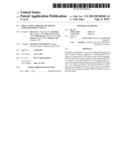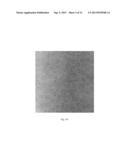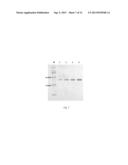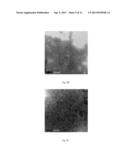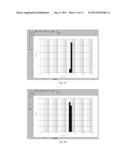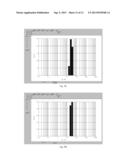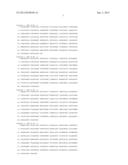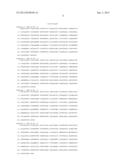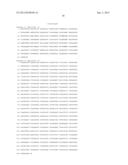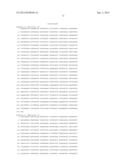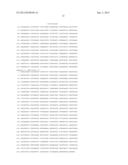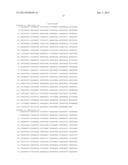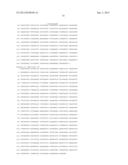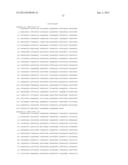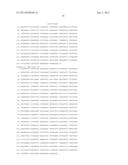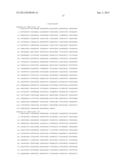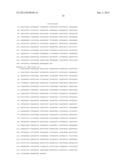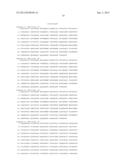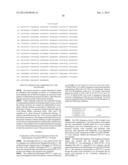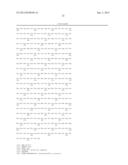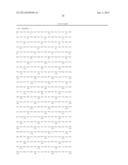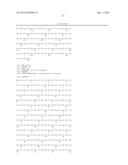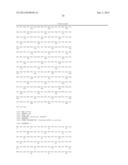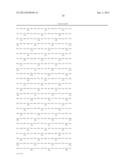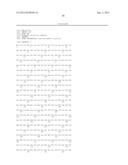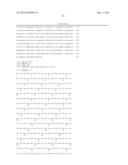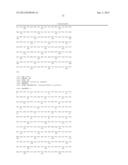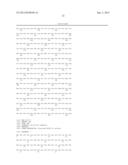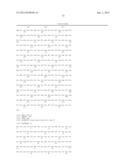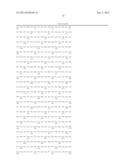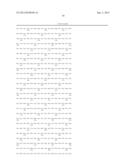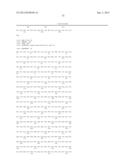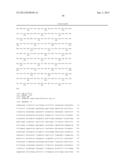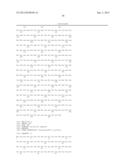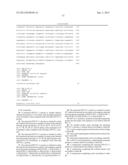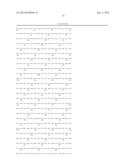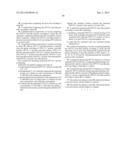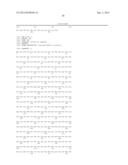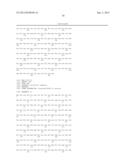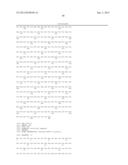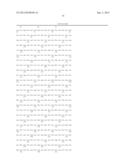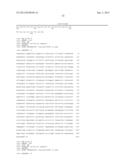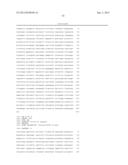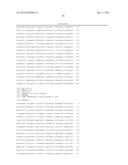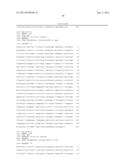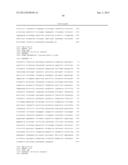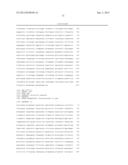Patent application title: TRUNCATED L1 PROTEIN OF HUMAN PAPILLOMAVIRUS TYPE 52
Inventors:
Shaowei Li (Xiamen, CN)
Xiaobing Mo (Xiamen, CN)
Minxi Wei (Xiamen, CN)
Huirong Pan (Xiamen, CN)
Jun Zhang (Xiamen, CN)
Jun Zhang (Xiamen, CN)
Ningshao Xia (Xiamen, CN)
Ningshao Xia (Xiamen, CN)
Assignees:
Xiamen University
IPC8 Class: AC07K14025FI
USPC Class:
4241861
Class name: Antigen, epitope, or other immunospecific immunoeffector (e.g., immunospecific vaccine, immunospecific stimulator of cell-mediated immunity, immunospecific tolerogen, immunospecific immunosuppressor, etc.) amino acid sequence disclosed in whole or in part; or conjugate, complex, or fusion protein or fusion polypeptide including the same disclosed amino acid sequence derived from virus
Publication date: 2013-09-05
Patent application number: 20130230548
Abstract:
Provided is a truncated L1 protein of Human Papillomavirus (HPV) Type 52
which, compared to a wild type HPV52 L1 protein, is truncated by 27-42
amino acids at the N-terminal. Also provided are a coding sequence of the
truncated HPV52 L1 protein, a virus-like particle (VLP) comprising the
protein, and a method of preparing the protein and the VLP using an E.
coli expression system. The truncated HPV52 L1 protein and an assembled
VLP can be used to prevent an HPV52 infection and a disease caused by
HPV52 infection, such as cervical cancer.Claims:
1.-13. (canceled)
14. A truncated HPV52 L1 protein or variants thereof, wherein the protein is 27-42 amino acids in length, truncated at its N-terminal, when compared with wild type HPV52 L1 protein.
15. The truncated HPV52 L1 protein as claimed in claim 14, wherein the protein has a number of amino acids selected from the group consisting of, 27, 28, 29, 30, 31, 32, 33, 34, 35, 36, 37, 38, 39, 40, 41, and 42 amino acids, truncated at its N-terminal, when compared with wild type HPV52 L1 protein.
16. The truncated HPV52 L1 protein as claimed in claim 15, wherein the protein has a number of amino acids selected from the group consisting, 27, 35, 38, 40, and 42 amino acids, truncated at its N-terminal, as compared with wild type HPV52 L1 protein.
17. The truncated HPV52 L1 protein as claimed in claim 14, wherein the protein has an amino acid sequence selected from the group consisting of SEQ ID NO: 1, SEQ ID NO: 2, SEQ ID NO: 3, SEQ ID NO: 4, SEQ ID NO: 5, SEQ ID NO: 6, SEQ ID NO: 7, SEQ ID NO: 8, SEQ ID NO: 9, SEQ ID NO: 10, SEQ ID NO: 11, SEQ ID NO: 12, and SEQ ID NO: 13.
18. The truncated HPV52 L1 protein as claimed in claim 17, wherein the protein has an amino acid sequence selected from the group consisting of SEQ ID NO: 1, SEQ ID NO: 7, SEQ ID NO: 10, SEQ ID NO: 12, or SEQ ID NO: 13
19. HPV52 L1 protein as claimed in claim 18, wherein the protein has the amino acid sequence as set forth in SEQ ID NO: 12.
20. An isolated nucleic acid, encoding the truncated HPV52 L1 protein or variants thereof according to claim 14.
21. A vector comprising the isolated nucleic acid according to claim 20.
22. A host cell comprising the isolated nucleic acid according to claim 20.
23. A host cell comprising the vector according to claim 21.
24. A HPV52 virus-like particle, comprising the truncated protein or variants, thereof according to claim 14.
25. A composition comprising the truncated HPV52 L1 protein or variants thereof according to claim 14.
26. A composition comprising the isolated nucleic acid according to claim 20.
27. A composition comprising vector according to claim 21.
28. A composition comprising the host cell according to claim 22.
29. A composition comprising the HPV52 virus-like particle according to claim 24.
30. A pharmaceutical composition or vaccine comprising the HPV52 virus-like particle according to claim 24, and optionally comprising pharmaceutically acceptable carriers and/or excipients, wherein the HPV52 virus-like particle is present in an amount effective for preventing HPV infection or cervical cancer.
31. The pharmaceutical composition or vaccine according to claim 30, wherein HPV52 virus-like particle is selected from the group consisting of HPV6 L1 protein virus-like particle, HPV11 L1 protein virus-like particle, HPV16 L1 protein virus-like particle, HPV18 L1 protein virus-like particle, HPV31 L1 protein virus-like particle, HPV33 L1 protein virus-like particle, HPV45 L1 protein virus-like particle, and HPV58 L1 protein virus-like particle.
32. A method for obtaining a truncated HPV52 L1 protein comprising: preferably, the method comprises the steps of: a) expressing the truncated HPV52 L1 protein of claim 14 in E. coli; b) disrupting the E. coli, which has expressed the truncated protein, in a solution at a salt concentration of 100 mM to 600 mM, and isolating the supernatant; c) decreasing the salt concentration of the supernatant of b) to 100 mM or less, by using water or a solution at a low salt concentration, and collecting a precipitate; d) re-dissolving the precipitate of c) in a solution at a salt concentration of 150 mM to 250 mM and adding a reductant to the solution, and isolating the resultant solution, wherein the resultant solution contains the truncated HPV52 L1 protein with a purity of at least 50%.
33. A method for preparing the HPV52 virus-like particle according to claim 24, comprising: a) purifying a truncated HPV52 L1 protein having 27-42 amino acids in length, truncated at its N-terminal, when compared with wild type HPV52 L1 protein, to have a purity of at least 50% by a chromatography; and b) removing the reductant from the truncated protein obtained in a).
34. A method for preparing a vaccine, comprising blending the HPV52 virus-like particle according to claim 24 and optionally, one or more virus-like particles selected from the group consisting of virus-like particles of HPV types 6, 11, 16, 18, 31, 33, 45 and 58, with pharmaceutically acceptable carriers and/or excipients.
35. A method for preventing HPV52 infection or a disease caused by HPV52 infection, comprising administering a prophylactically effective amount of the HPV52 virus-like particle according to claim 24, to a subject.
36. A method for preventing HPV52 infection or a disease caused by HPV52 infection comprising administering a prophylactically effective amount of the pharmaceutical composition or vaccine comprising the HPV52 virus-like particle according to claim 30, to a subject.
37. The method according to claim 35, wherein the disease is cervical cancer, and the subject is a human.
38. The method according to claim 36, wherein the disease is cervical cancer, and the subject is a human.
Description:
FIELD OF THE INVENTION
[0001] The invention relates to the field of molecular virology and immunology. In particular, the invention relates to a truncated L1 protein of Human Papillomavirus Type 52, its coding sequence and preparation method, and a virus-like particle comprising the protein, wherein the protein and the virus-like particle are useful for preventing HPV (particularly HPV52) infection, and a disease caused by HPV (particularly HPV52) infection, such as cervical cancer. The invention also relates to the use of the protein and the virus-like particle in the preparation of a pharmaceutical composition or a vaccine for preventing HPV (particularly HPV52) infection, and a disease caused by HPV (particularly HPV52) infection, such as cervical cancer.
BACKGROUND OF THE INVENTION
[0002] Human Papillomavirus (HPV), a non-enveloped, deoxyribonucleic acid (DNA) virus, belongs to the family Papillomaviridae. The viral genome is a double-stranded, closed circular DNA, which is approximately 7.2-8 kb in length and contains 8 open reading frames (ORFs). The genome can be divided into three parts in terms of function: (1) the early region (E), approximately 4.5 Kb in length, coding for 6 non-structural proteins E1, E2, E4-E7 associated with virus replication, transcription and transformation; (2) the late region (L), approximately 2.5 Kb in length, coding for the major capsid protein L1 and the minor capsid protein L2; (3) the long control region (LCR), located between the end of the L region and the initiating terminal of the E region, approximately 800-900 bp in length, and comprising regulator elements for DNA replication and expression instead of coding for proteins. HPV viral particles have a diameter of 45-55 nm, wherein the nucleocapsid, consisting of L1 and L2, exhibits icosahedral symmetry and comprises 72 capsomers.
[0003] Currently, there are over 100 different types of HPV, mainly causing papillary disease in the skin and mucosa of human. HPV types are divided into three groups depending on their relation with tumorigenesis: (1) group of low or no cancerogenic risk, containing HPV 6, 11, 39, 41, 42, and 43; (2) group of medium cancerogenic risk, containing HPV 31, 33, 35 and 51; and (3) group of high cancerogenic risk, containing HPV 16, 18, 58, 45 and 52.
[0004] HPV molecular epidemiological investigation demonstrates that infection by high-risk HPV types is an important factor responsible for the development of cervical cancer. Among all the cervical cancer specimens, HPV DNA is detected in over 80% of them. Cervical cancer is a common malignant tumor among women, the incidence of which is only next to breast cancer, and seriously threatens the health of women. There are about 490,000 newly reported cases worldwide every year, and nearly 270,000 people die of this disease annually (Boyle, P., and J. Ferlay. Ann Oncol 2005, 16:481-8). Cases in developing countries account for approximately 83% of the total cervical cancer cases. In these developing countries, the cervical cancer cases account for about 15% of female malignant tumors, in contrast to 1.5% in developed countries. Cervical cancer is most prevalent in sub-Saharan Africa, central and Southern Asia, Latin America, and Eastern Asia. Cervical cancer is also prevalent in China. The incidence of cervical cancer among married women is as high as 1026/100000 in Lueyang County of Shanxi Province.
[0005] The distribution of HPV types exhibits some characteristics of geographical distribution and populations. HPV 16 and 18 subtypes are the most common types in cervical cancer worldwide, and HPV52 subtype is the sixth most common high-risk HPV type. Among some areas of China, for example, provinces such as Guangdong province, HPV52 is a high-risk cancerogenic HPV type only next to HPV 16, 33 and 18.
[0006] Currently, the commercially available HPV vaccines are Gardasil® from Merck and Cervarix® from GSK, which comprise HPV6/11/16/18 and HPV16/18 VLP, respectively, but do not comprise HPV type 52 VLP.
[0007] Therefore, vaccines directed to HPV type 52 shall be involved in the development of vaccines for high-risk types, which cover a wider scope and are more suitable for Chinese population.
[0008] HPV L1 protein, with a molecular weight of 55-60 kDa, is the major capsid protein of the human papillomavirus and the main target protein of the HPV vaccine. HPV L1 protein expressed in many expression systems can form Virus-Like Particles (VLPs) which resemble native HPV particles morphologically, without the assistance of the L2 protein. The VLPs, consisting of 72 pentamers of the L1 proteins, exhibit icosahedral symmetry. Since the VLPs retain the native epitopes of the viral particles, they are highly immunogenic and can induce the generation of neutralization antibodies against homologous HPV (Kirnbauer, R., F. Booy, et al. 1992 Proc Natl Acad Sci USA 89(24): 12180-4). Furthermore, the VLPs are safe and have no potential cancergenic risk as they contain no viral nucleic acids. Therefore, VLP vaccines have become the primary candidate for HPV vaccines.
[0009] The key for development of HPV VLP vaccines lies in efficient production of VLP samples in large-scale. Currently, the most common expression systems used for VLP are divided into eukaryotic expression systems and prokaryotic expression systems.
[0010] The commonly used eukaryotic expression systems comprise poxvirus, insect baculovirus and yeast expression systems. HPV L1 protein expressed in eukaryotic expression systems shows little conformational difference from that of the native virus, and can self-assemble into VLPs. Thus, purified VLPs can be easily obtained after simple gradient density centrifugation. It brings a lot of convenience to the purification work. However, due to the high culture costs and low expression level of eukaryotic expression systems, it is quite difficult to product industrially on a large-scale. The HPV vaccine Gardasil®, which came into the market recently, is more expensive than others due to low expression level and high production cost of the Saccharomyces cerevisiae expression system employed in its manufacture, and therefore, its general application is limited.
[0011] The expression of HPV L1 protein in a prokaryotic expression system such as E. coli expression system has been previously reported. The expression of HPV 16 L1 protein by employing E. coli has been reported (Banks, L., G. Matlashewski, et al. (1987). J Gen Virol 68 (Pt 12): 3081-9). However, most HPV L1 proteins expressed in E. coli lose their native conformation and cannot induce protective antibodies against HPV. Alternatively, although HPV VLPs can be obtained from the proteins by steps such as purification from inclusion bodies and renaturation (Kelsall, S. R. and J. K. Kulski (1995). J Virol Methods 53(1): 75-90), it is difficult to apply this method to large-scale production, as the proteins are largely lost during the renaturation process and the yield is low. Although HPV L1 protein may be expressed in a soluble form with a correct conformation in E. coli and be dissolved in the supernatants of E. coli lysate, the expression level is low. Moreover, since there are large number and amounts of impure proteins, it is difficult to isolate the proteins of interest from them. Although it is also reported that the expression level of L1 protein can be increased in the supernatants by means of GST fusion expression and the purification of the protein of interest is facilitated (Li, M., T. P. Cripe, et al. (1997), J Virol 71(4): 2988-95), it still cannot be applied to larger-scale production because expensive enzymes are required to cleave the fusion protein.
[0012] Therefore, the obtainment of a HPV L1 protein capable of inducing the generation of protective antibodies against HPV, and a virus-like particle consisting of the same, at low cost, are still urgent in the art, in order to make the large-scale industrial production of vaccines for cervical cancer possible.
DESCRIPTION OF THE INVENTION
[0013] The invention is at least partially based on the inventors' surprised discovery: a truncated HPV52 L1 protein capable of inducing the generation of neutralization antibodies against HPV52 can be expressed in an E. coli expression system on a large scale, wherein the truncated HPV52 L1 protein can be produced with a high yield, and the purity of the purified protein reaches at least 50% or higher (such as 60%, 70%, 80%, 90%, 95%, 96%, 97%, 98%, and 99%). Moreover, further treatment of the purified protein results in the obtainment of VLPs capable of inducing the generation of protective antibodies against HPV52.
[0014] Therefore, in one aspect, the invention relates to a truncated HPV52 L1 protein or variants thereof, wherein said protein has 27-42 amino acids, for example, 27, 28, 29, 30, 31, 32, 33, 34, 35, 36, 37, 38, 39, 40, 41, or 42 amino acids, truncated at its N-terminal.
[0015] In one aspect, the invention relates to a truncated HPV52 L1 protein or variants thereof, wherein said protein has 27-42 amino acids, for example, 27, 28, 29, 30, 31, 32, 33, 34, 35, 36, 37, 38, 39, 40, 41, or 42 amino acids, truncated at its N-terminal, as compared with wild type HPV52 L1 protein.
[0016] In a preferred embodiment, the truncated HPV52 L1 protein has 27-42 amino acids (such as, 35-42 amino acids), for example, 27, 35, 38, 40, or 42 amino acids, truncated at its N-terminal, as compared with wild type HPV52 L1 protein. In another preferred embodiment, the truncated HPV52 L1 protein has 40 amino acids truncated at its N-terminal, as compared with wild type HPV52 L1 protein.
[0017] In another preferred embodiment, the truncated HPV52 L1 protein (cited hereafter as the truncated protein) has an amino acid sequence as set forth in SEQ ID NO: 1, SEQ ID NO: 2, SEQ ID NO: 3, SEQ ID NO: 4, SEQ ID NO: 5, SEQ ID NO: 6, SEQ ID NO: 7, SEQ ID NO: 8, SEQ ID NO: 9, SEQ ID NO: 10, SEQ ID NO: 11, SEQ ID NO: 12, or SEQ ID NO: 13; such as, an amino acid sequence as set forth in SEQ ID NO: 1, SEQ ID NO: 7, SEQ ID NO: 10, SEQ ID NO: 12, or SEQ ID NO: 13. In another preferred embodiment, the truncated protein has an amino acid sequence as set forth in SEQ ID NO: 12.
[0018] In another aspect, the invention relates to a polynucleotide encoding the truncated protein or variants thereof according to the invention, and a vector containing the polynucleotide.
[0019] Vectors for inserting a polynucleotide of interest are well known in the art, including, but not limited to clone vectors and expression vectors. In one embodiment, the vectors are, for example, plasmids, phages, cosmids, etc.
[0020] In another aspect, the invention also relates to a host cell comprising the polynucleotide or vector as described above. The host cell includes, but is not limited to prokaryotic cells such as E. coli cells, and eukaryotic cells such as yeast cells, insect cells, plant cells and animal cells (such as mammalian cells, for example, mouse cells, human cells, etc.). The host cell according to the invention may also be a cell line, such as 293T cell.
[0021] In another aspect, the invention relates to a HPV52 virus-like particle, comprising or consisting of or formed from the truncated protein or variants thereof according to the invention.
[0022] In one preferred embodiment, the HPV52 virus-like particle according to invention comprises or is consisted of or formed from the truncated HPV52 L1 protein having 27-42 amino acids, for example, 27, 35, 38, 40, or 42 amino acids, truncated at its N-terminal, as compared with wild type HPV52 L1 protein. In a particularly preferred embodiment, the HPV52 virus-like particle according to invention comprises or is consisted of or formed from the truncated HPV52 L1 protein having a sequence as set forth in SEQ ID NO: 1, 7, 10, 12, or 13.
[0023] In another aspect, the invention also relates to a composition comprising said truncated protein or variants thereof, or said polynucleotide or vector or host cell or HPV52 virus-like particle. In one preferred embodiment, the composition comprises the truncated protein or variants thereof according to the invention. In another preferred embodiment, the composition comprises the HPV52 virus-like particle according to the invention.
[0024] In another aspect, the invention also relates to a pharmaceutical composition or vaccine comprising the HPV52 virus-like particle according to invention, and optionally pharmaceutically acceptable carriers and/or excipients. The pharmaceutical composition or vaccine according to the invention is useful for preventing HPV (particularly HPV52) infection, and a disease caused by HPV (particularly HPV52) infection, such as cervical cancer.
[0025] In one preferred embodiment, the HPV52 virus-like particle is present at an amount effective for preventing HPV infection or cervical cancer. In another preferred embodiment, the pharmaceutical composition or vaccine according to the invention further comprises at least one virus-like particle selected from the group consisting of HPV6 L1 protein virus-like particle, HPV11 L1 protein virus-like particle, HPV16 L1 protein virus-like particle, HPV18 L1 protein virus-like particle, HPV31 L1 protein virus-like particle, HPV33 L1 protein virus-like particle, HPV45 L1 protein virus-like particle, and HPV58 L1 protein virus-like particle; preferably these virus-like particles are independently present at an amount effective for preventing cervical cancer or infection by the corresponding HPV subtype.
[0026] The pharmaceutical composition or vaccine according to the invention may be administrated by methods well known in the art, for example, but not limited to, orally or by injection. In the invention, the particularly preferred administration route is injection.
[0027] In one preferred embodiment, the pharmaceutical composition or vaccine according to the invention is administrated in a form of a unit dosage. For example, but not for limiting the invention, each unit dosage contains 5 μg-80 μg, preferably 20 μg-40 μg HPV52 virus-like particle.
[0028] In another aspect, the invention relates to a method for obtaining the truncated protein according to the invention, comprising expressing the truncated protein according to the invention with an E. coli expression system, and carrying out a purification process on the lysis supernatant containing the truncated protein,
[0029] In a preferred embodiment, the method for obtaining the truncated protein according to the invention comprises
[0030] a) expressing the truncated protein in E. coli;
[0031] b) disrupting the E. coli, which has expressed the truncated protein, in a solution at a salt concentration of 100 mM to 600 mM, and isolating the supernatant;
[0032] c) decreasing the salt concentration of the supernatant of b) to 100 mM or less, by using water or a solution at a low salt concentration, lowest to 0, and collecting a precipitate;
[0033] d) re-dissolving the precipitate of c) in a solution at a salt concentration of 150 mM to 250 mM and adding a reductant to the solution, and then isolating the resultant solution, wherein the resultant solution contains the truncated HPV52 L1 protein with a purity of at least 50%.
[0034] In one embodiment of the invention, the salt concentration in b) is from 200 mM to 500 mM.
[0035] The invention also relates to a method for obtaining the HPV52 virus-like particle according to invention, on the basis of the obtainment of the truncated protein of the invention, comprising the steps of:
[0036] e) further purifying the truncated HPV52 L1 protein according to the invention with a purity of at least 50% by a chromatography; and
[0037] f) removing the reductant from the truncated protein obtained in e).
[0038] The invention also relates to a method for preparing a vaccine, comprising blending the HPV52 virus-like particle according to the invention, and optionally, one or more virus-like particles selected from the group consisting of virus-like particles of HPV types 6, 11, 16, 18, 31, 33, 45 and 58, with pharmaceutically acceptable carriers and/or excipients. As described above, the vaccine obtained is useful for preventing HPV (particularly HPV52) infection, and a disease caused by HPV (particularly HPV52) infection, such as cervical cancer.
[0039] In another aspect, the invention relates to a method for preventing HPV infection or a disease caused by HPV infection, comprising administrating a prophylactically effective amount of the HPV52 virus-like particle or pharmaceutical composition or vaccine according to the invention. In one preferred embodiment, the HPV infection is HPV52 infection. In another preferred embodiment, the disease caused by HPV infection includes, but is not limited to cervical cancer. In another preferred embodiment, the subject is mammalian, such as human.
[0040] In another aspect, the invention also relates to the use of the truncated protein or variants thereof or the HPV52 virus-like particle according to invention in the preparation of a pharmaceutical composition or vaccine for preventing HPV infection or a disease caused by HPV infection. In one preferred embodiment, the HPV infection is HPV52 infection. In another preferred embodiment, the disease caused by HPV infection includes, but is not limited to cervical cancer.
[0041] In another aspect, the invention also relates to the truncated protein or variants thereof or the HPV52 virus-like particle according to invention, for use in the prevention of HPV infection or a disease caused by HPV infection. In one preferred embodiment, the HPV infection is HPV52 infection. In another preferred embodiment, the disease caused by HPV infection includes, but is not limited to cervical cancer.
DEFINITIONS OF THE TERM IN PRESENT INVENTION
[0042] In the invention, unless otherwise specified, the scientific and technical terms used herein have the meanings as generally understood by a person skilled in the art. Moreover, the laboratory operations of cell culture, molecular genetics, nucleic acid chemistry, and immunology used herein are the routine operations widely used in the corresponding fields. Meanwhile, in order to better understand the invention, the definitions and explanations of the relevant terms are provided as follows.
[0043] According to the invention, the term "a protein having X amino acids truncated at its N-terminal" refers to a protein resulted from substituting the amino acid residues from positions 1 to X at the N-terminal of the protein with methionine residue encoded by an initiator codon (for initiating protein translation). For example, a HPV52 L1 protein having 27 amino acids truncated at its N-terminal refers to a protein resulted from substituting the amino acid residues from positions 1 to 27 at the N-terminal of wild type HPV52 L1 protein with methionine residue encoded by an initiator codon.
[0044] According to the invention, the term "variant" refers to a protein, whose amino acid sequence is different from the truncated HPV52 L1 protein according to the invention (for example, the protein as set forth in SEQ ID NO: 1, 7, 10, 12, or 13) by one or more (for example, 1-10, or 1-5 or 1-3) amino acids (such as conservative amino acid substitutions), or which has an identity of at least 60%, 80%, 85%, 90%, 95%, 96%, 97%, 98%, or 99% to the truncated HPV52 L1 protein according to the invention (for example, the protein as set forth in SEQ ID NO: 1, 7, 10, 12, or 13), and which retains the essential characteristics of the truncated protein. The term "essential characteristics" may be one or more of the following characteristics: capable of inducing the generation of neutralization antibodies against HPV52; capable of being expressed in E. coli in a soluble manner; capable of obtaining purified protein with a high yield by the expression and purification methods as involved in the invention.
[0045] According to the invention, the term "identity" refers to the match degree between two polypeptides or between two nucleic acids. When two sequences for comparison have the same base or amino acid monomer sub-unit at a certain site (e.g., each of two DNA molecules has an adenine at a certain site, or each of two polypeptides has a lysine at a certain site), the two molecules are identical at the site. The percent identity between two sequences is a function of the number of identical sites shared by the two sequences over the total number of sites for comparison×100. For example, if 6 of 10 sites of two sequences are matched, these two sequences have an identity of 60%. For example, DNA sequences: CTGACT and CAGGTT share an identity of 50% (3 of 6 sites are matched). Generally, the comparison of two sequences is conducted in a manner to produce maximum identity. Such alignment can be conducted by using a computer program such as Align program (DNAstar, Inc.) which is based on the method of Needleman, et al. (J. Mol. Biol. 48:443-453, 1970). The percent identity between two amino acid sequences can be determined using the algorithm of E. Meyers and W. Miller (Comput. Appl. Biosci., 4:11-17 (1988)) which has been incorporated into the ALIGN program (version 2.0), using a PAM120 weight residue table, a gap length penalty of 12 and a gap penalty of 4. In addition, the percent identity between two amino acid sequences can be determined using the algorithm of Needleman and Wunsch (J. Mol. Biol. 48:444-453 (1970)) which has been incorporated into the GAP program in the GCG software package (available at http://www.gcg.com), using either a Blossum 62 matrix or a PAM250 matrix, and a gap weight of 16, 14, 12, 10, 8, 6, or 4 and a length weight of 1, 2, 3, 4, 5, or 6.
[0046] As used in the invention, the term "conservative substitution" refers to amino acid substitutions which would not negatively affect or change the biological activity of a protein/polypeptide comprising the amino acid sequence. For example, a conservative substitution may be introduced by standard techniques known in the art such as site-directed mutagenesis and PCR-mediated mutagenesis. Conservative amino acid substitutions include substitutions wherein an amino acid residue is substituted with another amino acid residue having a similar side chain, for example, a residue similar to the corresponding amino acid residue physically or functionally (such as, having similar size, shape, charges, chemical properties including the capability of forming covalent bond or hydrogen bond, etc.). The families of amino acid residues having similar side chains have been defined in the art. These families include amino acids having alkaline side chains (for example, lysine, arginine and histidine), amino acids having acidic side chains (for example, aspartic acid and glutamic acid), amino acids having uncharged polar side chains (for example, glycine, asparagine, glutamine, serine, threonine, tyrosine, cysteine, tryptophan), amino acids having nonpolar side chains (for example, alanine, valine, leucine, isoleucine, proline, phenylalanine, methionine), amino acids having β-branched side chains (such as threonine, valine, isoleucine) and amino acids having aromatic side chains (for example, tyrosine, phenylalanine, tryptophan, histidine). Therefore, a corresponding amino acid residue is preferably substituted with another amino acid residue from the same side-chain family. Methods for identifying amino acid conservative substitutions are well known in the art (see, for example, Brummell et al., Biochem. 32: 1180-1187 (1993); Kobayashi et al., Protein Eng. 12(10): 879-884 (1999); and Burks et al., Proc. Natl Acad. Set USA 94: 412-417 (1997), which are incorporated herein by reference).
[0047] According to the invention, the term "E. coli expression system" refers to an expression system consisting of E. coli (strain) and a vector, wherein the E. coli (strain) includes, but are not limited to: GI698, ER2566, BL21 (DE3), B834 (DE3), BLR (DE3), etc., which are available on the market.
[0048] According to the invention, the term "vector" refers to a nucleic acid vehicle which can have a polynucleotide inserted therein. When the vector allows for the expression of the protein encoded by the polynucleotide inserted therein, the vector is called an expression vector. The vector can have the carried genetic material elements expressed in a host cell by transformation, transduction, and transfection into the host cell. Vectors are well known by a person skilled in the art, including, but not limited to plasmids, phages, cosmids and the like.
[0049] According to the invention, the term "a truncated HPV52 L1 protein" refers to the protein with one or more amino acids deleted at the N- and/or C-terminal of wild-type HPV52 L1 protein, wherein the example of the wild-type HPV52 L1 protein includes, but is not limited to, the full-length L1 proteins such as ACX32362.1, Q05138.2 or ABU55790.1 in NCBI database. For example, the amino acid sequence of wild-type HPV52 L1 protein may be as set forth in SEQ ID NO: 27, SEQ ID NO: 28 or SEQ ID NO: 29.
[0050] According to the invention, the term "a gene fragment of a truncated HPV52 L1 protein" refers to the gene fragments with the nucleotide(s) encoding one or more amino acids deleted at 5' or 3' terminal of the wild-type HPV52 L1 gene, wherein the full-length gene sequence of the wild-type HPV52 L1 gene includes, but is not limited to, the following sequences: EU077195.1, EU077194.1, FJ615303.1 in NCBI database.
[0051] According to the invention, the term "pharmaceutically acceptable carriers and/or excipients" refers to carriers and/or excipients that are pharmacologically and/or physiologically compatible with subjects and active ingredients, and are well known in the art (see, for example, Remington's Pharmaceutical Sciences. Edited by Gennaro A R, 19th ed. Pennsylvania: Mack Publishing Company, 1995), including, but not limited to pH adjusting agents, surfactants, adjuvants, and ionic strength enhancers. For example, pH adjusting agents include, but are not limited to, phosphate buffers; surfactants include, but are not limited to: anion surfactants, cation surfactants, or non-ionic surfactants (for example, Tween-80); adjuvants include, but are not limited to, aluminum adjuvants (for example, aluminum hydroxide) and Freund's adjuvants (for example, Freund's complete adjuvant); and ionic strength enhancers include, but are not limited to, NaCl.
[0052] According to the invention, the term "an effective amount" refers to an amount that can effectively achieve the intended purpose. For example, an amount effective for preventing a disease (such as HPV infection) refers to an amount effective for preventing, suppressing, or delaying the occurrence of a disease (such as HPV infection). The determination of such an effective amount is within the ability of a person skilled in the art.
[0053] According to the invention, the term "chromatography" includes, but is not limited to: ion exchange chromatography (e.g. cation-exchange chromatography), hydrophobic interaction chromatography, absorbent chromatography (e.g. hydroxyapatite chromatography), gel filtration chromatography (gel exclusion chromatography), and affinity chromatography.
[0054] According to the invention, the truncated HPV52 L1 proteins according to the invention may be obtained preferably by the following steps:
[0055] disrupting E. coli, which expresses a truncated HPV52 L1 protein, in a buffer at a salt concentration of 100-600 mM, preferably 200-500 mM, and centrifuging the disrupted solution to obtain a supernatant;
[0056] precipitating the truncated HPV52 L1 protein from the supernatant by decreasing the salt concentration of the resultant supernatant to 100 mM-0 mM with water or a low-salt solution (generally, with a salt concentration lower than the one of the buffer for disrupting);
[0057] re-dissolving the precipitate in a solution containing a reductant and having a salt concentration of 150-200 mM, preferably greater than 200 mM, resulting in a solution comprising the truncated HPV52 L1 proteins with a purity of at least 50%, preferably at least 70%, more preferably at least 80%.
[0058] The buffers used in the methods of the invention are well known in the art, including, but not limited to Tris buffers, phosphate buffers, HEPES buffers, MOPS buffers, etc.
[0059] According to the invention, the disrupting of the host cell can be accomplished by methods well known by a person skilled in the art, including, but not limited to homogenizer disrupting, ultrasonic treatment, grinding, high pressure extrusion, lysozyme treatment, etc.
[0060] The salts used in the methods of the invention include, but are not limited to: one or more of acidic salts, basic salts, neutral salts, for example, alkali metal salts, alkaline-earth metal salts, ammonium salts, hydrochlorides, sulfates, bicarbonates, phosphate salts or biphosphates, especially NaCl, KCl, NH4Cl, (NH4)2SO4. NaCl is particularly preferred. The reductant used in the methods of the invention includes, but is not limited to, DTT and 2-mercaptoethanol, at an amount including, but not limited to, 10-100 mM.
[0061] According to the invention, the HPV52 VLPs according to the invention may be produced by the following steps: further purifying the truncated HPV52 L1 protein with a purity of at least 50% as described above by e.g. a chromatography, and thereby obtaining a purified truncated protein solution; and removing the reductant from the solution to obtain the HPV52 VLPs. Methods for removing the reductant are known in the art, including, but not limited to, dialysis, ultrafiltration, and chromatography.
BENEFICIAL EFFECT
[0062] Presently, the expression systems useful for preparing HPV VLPs include eukaryotic and prokaryotic expression systems.
[0063] HPV L1 proteins expressed in eukaryotic expression systems show little conformational difference from that of the native virus, and can self-assemble into VLPs. In most cases, VLPs with a correct conformation can be obtained by simple purification. Nevertheless, eukaryotic expression systems, such as the baculovirus and yeast expression systems, are difficult to be applied to large-scale industrial production due to shortcomings such as low expression levels and high culturing costs.
[0064] Prokaryotic expression systems, such as E. coli systems, have the advantages of high expression levels and low culturing costs. However, when expressed in E. coli system, HPV L1 proteins usually lose their native conformations and are expressed in a form of inclusion bodies in the precipitant. Currently, renaturation of the protein from inclusion bodies is still a challenge worldwide. Due to the difficulty and inefficiency of renaturation, this method is limited to small-scale lab research and cannot be applied to the large-scale obtainment of VLPs with a correct conformation from the inclusive bodies. Although HPV L1 protein may be expressed in a soluble form with a correct conformation in E. coli, their expression levels are low. Moreover, it is quite difficult to purify the HPV L1 proteins from the numerous soluble proteins in the E. coli lysate supernatant. Generally, the purification is carried out by means such as fusion expression and affinity chromatography which are not feasible for industrial-scale processes due to expensive enzymes employed therein.
[0065] The N-truncated HPV52 L1 protein and the method for preparing the same, as provided in the invention, effectively solve the problem. Firstly, E. coli expression systems are used in the invention to express the N-truncated HPV52 L1 protein, which ensures a high expression level. Secondly, the truncated protein is selectively precipitated from the E. coli lysate supernatant under mild conditions. The truncated protein is then redissolved in a salt buffer to significantly improve its purity while still retaining its correct conformation. The truncated protein solution thus obtained can be further purified directly by chromatography such as ion-exchange and hydrophobic exchange chromatography so as to obtain the protein of interest with a high purity (such as a purity up to 80%). Further, the purified, truncated protein obtained from these steps, can self-assemble into VLP with good immunogenicity and the ability to induce neutralization antibodies of a high titer against HPV52, which is a good vaccine for preventing HPV52 infection in human.
[0066] Therefore, the invention has the following advantages. The truncated protein of the invention can be expressed in E. coli expression systems on a large scale whilst retaining the antigenicity, immunogenicity, and particle self-assembly ability of the full-length HPV52 L1 protein. Expensive enzymes are not required in the preparation methods used in the invention, i.e. the cost is low. Furthermore, since the truncated protein is not subjected to the intensive procedures of denaturation and renaturation during purification, the loss of the protein is low and the yield is high. The VLPs formed from the truncated protein can induce the generation of protective antibodies against HPV at a high titer and can be applied to the preparation of vaccines. Thus, the truncated protein of the invention and the preparation method thereof can be applied to large-scale industrial production, and makes the large-scale industrial production of vaccines for cervical cancer possible.
[0067] The embodiments of the invention are further described in detail by reference to the drawings and examples. However, a person skilled in the art would understand that the following drawings and examples are intended for illustrating the invention only, rather than defining the scope of the invention. According to the detailed description of the following drawings and preferred embodiments, various purposes and advantages of the invention are apparent for a person skilled in the art.
DESCRIPTION OF DRAWINGS
[0068] FIG. 1 shows the SDS-PAGE result of the HPV52N40C-L1 protein obtained during different steps of Example 3 of the invention. Lane M: protein molecular weight marker; Lane 1: supernatant of disrupted bacteria (i.e. the supernatant obtained by centrifuging the disrupted bacteria); Lane 2: precipitate product free of salts (i.e. the precipitate obtained by centrifugation after dialysis); Lane 3: re-dissolved supernatant (i.e. the supernatant obtained by centrifuging the solution resulted from re-dissolving the precipitate product free of salts); Lane 4: precipitant obtained after re-dissolution (i.e. the precipitate obtained by centrifuging the solution resulted from re-dissolving the precipitate product free of salts). The result showed that the purity of HPV52N40C-L1 protein was increased from about 10% (see Lane 1) to about 70% (see Lane 3) after the steps of precipitation and re-dissolution.
[0069] FIG. 2 shows the SDS-PAGE result of HPV52N40C-L1 purified by cation exchange chromatography and CHT-II in Example 4. Lane M: protein molecular weight marker; Lane 1: HPV52N40C-L1 purified by the method of Example 4 (the loading volume was 10 μL); Lane 2: HPV52N40C-L1 purified by the method of Example 4 (the loading volume was 20 μL). The result showed that HPV52N40C-L1 protein purified by the cation exchange chromatography and CHT-II of Example 4 reached a purity of about 98%.
[0070] FIG. 3 shows the transmission electron microscopy (TEM) photograph of HPV52N40C-L1 VLPs obtained in Example 5 (taken at 50,000× magnification, Bar=100 nm), as described in Example 6. A large number of VLPs with a radius of about 25 nm were observed in visual field, wherein the particle size was consistent with the theoretic size and the particles were homogenous.
[0071] FIG. 4 shows cryo-electron microscopy photograph of HPV52N40C-L1 VLPs obtained in Example 5 and its reconstructed three-dimensional structure, as described in Example 6. FIG. 4A, HPV52N40C-L1 VLPs; FIG. 4B, the reconstructed three-dimensional structure of HPV52N40C-L1 VLPs. The reconstructed three-dimensional structure showed that HPV52N40C-L1 VLP had an icosahedral structure formed by 72 capsomers (morphologic subunit, pentamer), with T=7 (h=1, k=2). Unlike general icosahedral capsids meeting quasi-equivalent principle, all the subunits in the structure of HPV52N40C-L1 VLP were pentamers, no hexamers were found, and the VLP had a most peripheral diameter of 60 nm. The structure was similar to the three-dimensional structures of the previously reported native HPV viral particles and the HPV VLPs from eukaryotic expression systems (such as, poxvirus expression system) (Baker T S, Newcomb W W, Olson N H. et al. Biophys J. (1991), 60(6): 1445-1456; Hagensee M E, Olson N H, Baker T S, et al. J Virol. (1994), 68(7): 4503-4505; Buck C B, Cheng N, Thompson C D. et al. J Virol. (2008), 82(11):5190-7).
[0072] FIG. 5 shows the dynamic light-scattering measurement result of HPV52N40C-L1 VLPs obtained in Example 5, as described in Example 6. The result showed that HPV52N40C-L1 VLPs had a hydrodynamic radius of 24.39 nm and a particle assembly rate of 100%.
[0073] FIG. 6 shows neutralization titers of antibodies in serum at different stages after vaccination of rabbits with HPV52N40C-L1 VLPs as determined in Example 7. Vaccination times are indicated with arrows. The neutralization titers of antibodies increased significantly one month after the first vaccination, and reached a peak level of 105 after a booster.
[0074] FIG. 7 shows the SDS-PAGE results of the HPV52 L1 proteins having 27, 35, 38 or 42 amino acids truncated at the N-terminal, respectively, i.e. HPV52N27C-L1, HPV52N35C-L1, HPV52N38C-L1, HPV52N42C-L1 (their amino acid sequences were set forth in SEQ ID NOs: 1, 7, 10 and 13, respectively), as obtained in Example 8. Lane M: protein molecular weight marker; Lane 1: HPV52N27C-L1 protein (the loading volume was 10 μL); Lane 2: HPV52N35C-L1 protein (the loading volume was 10 μL); Lane 3: HPV52N38C-L1 protein (the loading volume was 10 μL); Lane 4: HPV52N42C-L1 protein (the loading volume was 10 μL). The results showed that the truncated proteins, i.e. HPV52N27C-L1, HPV52N35C-L1, HPV52N38C-L1, HPV52N42C-L1, as obtained in Example 8, reached a purity of about 98%.
[0075] FIG. 8 shows the transmission electron microscopy (TEM) photographs of HPV52N27C-L1, HPV52N35C-L1, HPV52N38C-L1, and HPV52N42C-L1 VLPs obtained in Example 8 (taken at 50,000× magnification, Bar=100 nm). FIG. 8A, HPV52N27C-L1 VLPs; FIG. 8B, HPV52N35C-L1 VLPs; FIG. 8C, HPV52N38C-L1 VLPs; and FIG. 8D, HPV52N42C-L1 VLPs. The results showed that a large number of VLPs with a radius of about 25 nm were observed in visual field in the four figures, wherein the particle size was consistent with the theoretic size and the particles were homogenous.
[0076] FIG. 9 shows the dynamic light-scattering measurement results of HPV52N27C-L1, HPV52N35C-L1, HPV52N38C-L1, and HPV52N42C-L1 VLPs obtained in Example 8. FIG. 9A, HPV52N27C-L1 VLPs; FIG. 9B, HPV52N35C-L1 VLPs; FIG. 9C, HPV52N38C-L1 VLPs; and FIG. 9D, HPV52N42C-L1 VLPs. The results showed that HPV52N27C-L1, HPV52N35C-L1, HPV52N38C-L1, and HPV52N42C-L1 VLPs had a hydrodynamic radius of about 25 nm and a particle assembly rate of 100%.
SEQUENCE INFORMATION
[0077] The information on the sequences involved in the invention is provided in the following Table 1.
TABLE-US-00001 TABLE 1 Depiction of sequences SEQ ID NO: depiction 1 a HPV52 L1 protein having 27 amino acids truncated at its N-terminal, HPV52N27C-L1 2 a HPV52 L1 protein having 30 amino acids truncated at its N-terminal, HPV52N30C-L1 3 a HPV52 L1 protein having 31 amino acids truncated at its N-terminal, HPV52N31C-L1 4 a HPV52 L1 protein having 32 amino acids truncated at its N-terminal, HPV52N32C-L1 5 a HPV52 L1 protein having 33 amino acids truncated at its N-terminal, HPV52N33C-L1 6 a HPV52 L1 protein having 34 amino acids truncated at its N-terminal, HPV52N34C-L1 7 a HPV52 L1 protein having 35 amino acids truncated at its N-terminal, HPV52N35C-L1 8 a HPV52 L1 protein having 36 amino acids truncated at its N-terminal, HPV52N36C-L1 9 a HPV52 L1 protein having 37 amino acids truncated at its N-terminal, HPV52N37C-L1 10 a HPV52 L1 protein having 38 amino acids truncated at its N-terminal, HPV52N38C-L1 11 a HPV52 L1 protein having 39 amino acids truncated at its N-terminal, HPV52N39C-L1 12 a HPV52 L1 protein having 40 amino acids truncated at its N-terminal, HPV52N40C-L1 13 a HPV52 L1 protein having 42 amino acids truncated at its N-terminal, HPV52N42C-L1 14 a DNA sequence encoding SEQ ID NO: 1 15 a DNA sequence encoding SEQ ID NO: 2 16 a DNA sequence encoding SEQ ID NO: 3 17 a DNA sequence encoding SEQ ID NO: 4 18 a DNA sequence encoding SEQ ID NO: 5 19 a DNA sequence encoding SEQ ID NO: 6 20 a DNA sequence encoding SEQ ID NO: 7 21 a DNA sequence encoding SEQ ID NO: 8 22 a DNA sequence encoding SEQ ID NO: 9 23 a DNA sequence encoding SEQ ID NO: 10 24 a DNA sequence encoding SEQ ID NO: 11 25 a DNA sequence encoding SEQ ID NO: 12 26 a DNA sequence encoding SEQ ID NO: 13 27 the amino acid sequence of ACX32362.1 28 the amino acid sequence of Q05138.2 29 the amino acid sequence of ABU55790.1 30 HPV-52 L1 gene sequence 31 primer 32 primer
TABLE-US-00002 Sequence 1 (SEQ ID NO: 1): 1 MSVWRPSEAT VYLPPVPVSK VVSTDEYVSR TSIYYYAGSS RLLTVGHPYF SIKNTSSGNG 61 KKVLVPKVSG LQYRVFRIKL PDPNKFGFPD TSFYNPETQR LVWACTGLEI GRGQPLGVGI 121 SGHPLLNKFD DTETSNKYAG KPGIDNRECL SMDYKQTQLC ILGCKPPIGE HWGKGTPCNN 181 NSGNPGDCPP LQLINSVIQD GDMVDTGFGC MDFNTLQASK SDVPIDICSS VCKYPDYLQM 241 ASEPYGDSLF FFLRREQMFV RHFFNRAGTL GDPVPGDLYI QGSNSGNTAT VQSSAFFPTP 301 SGSMVTSESQ LFNKPYWLQR AQGHNNGICW GNQLFVTVVD TTRSTNMTLC AEVKKESTYK 361 NENFKEYLRH GEEFDLQFIF QLCKITLTAD VMTYIHKMDA TILEDWQFGL TPPPSASLED 421 TYRFVTSTAI TCQKNTPPKG KEDPLKDYMF WEVDLKEKFS ADLDQFPLGR KFLLQAGLQA 481 RPKLKRPASS APRTSTKKKK VKR Sequence 2 (SEQ ID NO: 2): 1 MRPSEATVYL PPVPVSKVVS TDEYVSRTSI YYYAGSSRLL TVGHPYFSIK NTSSGNGKKV 61 LVPKVSGLQY RVFRIKLPDP NKFGFPDTSF YNPETQRLVW ACTGLEIGRG QPLGVGISGH 121 PLLNKFDDTE TSNKYAGKPG IDNRECLSMD YKQTQLCILG CKPPIGEHWG KGTPCNNNSG 181 NPGDCPPLQL INSVIQDGDM VDTGFGCMDF NTLQASKSDV PIDICSSVCK YPDYLQMASE 241 PYGDSLFFFL RREQMFVRHF FNRAGTLGDP VPGDLYIQGS NSGNTATVQS SAFFPTPSGS 301 MVTSESQLFN KPYWLQRAQG HNNGICWGNQ LFVTVVDTTR STNMTLCAEV KKESTYKNEN 361 FKEYLRHGEE FDLQFIFQLC KITLTADVMT YIHKMDATIL EDWQFGLTPP PSASLEDTYR 421 FVTSTAITCQ KNTPPKGKED PLKDYMFWEV DLKEKFSADL DQFPLGRKFL LQAGLQARPK 481 LKRPASSAPR TSTKKKKVKR Sequence 3 (SEQ ID NO: 3): 1 MPSEATVYLP PVPVSKVVST DEYVSRTSIY YYAGSSRLLT VGHPYFSIKN TSSGNGKKVL 61 VPKVSGLQYR VFRIKLPDPN KFGFPDTSFY NPETQRLVWA CTGLEIGRGQ PLGVGISGHP 121 LLNKFDDTET SNKYAGKPGI DNRECLSMDY KQTQLCILGC KPPIGEHWGK GTPCNNNSGN 181 PGDCPPLQLI NSVIQDGDMV DTGFGCMDFN TLQASKSDVP IDICSSVCKY PDYLQMASEP 241 YGDSLFFFLR REQMFVRHFF NRAGTLGDPV PGDLYIQGSN SGNTATVQSS AFFPTPSGSM 301 VTSESQLFNK PYWLQRAQGH NNGICWGNQL FVTVVDTTRS TNMTLCAEVK KESTYKNENF 361 KEYLRHGEEF DLQFIFQLCK ITLTADVMTY IHKMDATILE DWQFGLTPPP SASLEDTYRF 421 VTSTAITCQK NTPPKGKEDP LKDYMFWEVD LKEKFSADLD QFPLGRKFLL QAGLQARPKL 481 KRPASSAPRT STKKKKVKR Sequence 4 (SEQ ID NO: 4): 1 MSEATVYLPP VPVSKVVSTD EYVSRTSIYY YAGSSRLLTV GHPYFSIKNT SSGNGKKVLV 61 PKVSGLQYRV FRIKLPDPNK FGFPDTSFYN PETQRLVWAC TGLEIGRGQP LGVGISGHPL 121 LNKFDDTETS NKYAGKPGID NRECLSMDYK QTQLCILGCK PPIGEHWGKG TPCNNNSGNP 181 GDCPPLQLIN SVIQDGDMVD TGFGCMDFNT LQASKSDVPI DICSSVCKYP DYLQMASEPY 241 GDSLFFFLRR EQMFVRHFFN RAGTLGDPVP GDLYIQGSNS GNTATVQSSA FFPTPSGSMV 301 TSESQLFNKP YWLQRAQGHN NGICWGNQLF VTVVDTTRST NMTLCAEVKK ESTYKNENFK 361 EYLRHGEEFD LQFIFQLCKI TLTADVMTYI HKMDATILED WQFGLTPPPS ASLEDTYRFV 421 TSTAITCQKN TPPKGKEDPL KDYMFWEVDL KEKFSADLDQ FPLGRKFLLQ AGLQARPKLK 481 RPASSAPRTS TKKKKVKR Sequence 5 (SEQ ID NO: 5): 1 MEATVYLPPV PVSKVVSTDE YVSRTSIYYY AGSSRLLTVG HPYFSIKNTS SGNGKKVLVP 61 KVSGLQYRVF RIKLPDPNKF GFPDTSFYNP ETQRLVWACT GLEIGRGQPL GVGISGHPLL 121 NKFDDTETSN KYAGKPGIDN RECLSMDYKQ TQLCILGCKP PIGEHWGKGT PCNNNSGNPG 181 DCPPLQLINS VIQDGDMVDT GFGCMDFNTL QASKSDVPID ICSSVCKYPD YLQMASEPYG 241 DSLFFFLRRE QMFVRHFFNR AGTLGDPVPG DLYIQGSNSG NTATVQSSAF FPTPSGSMVT 301 SESQLFNKPY WLQRAQGHNN GICWGNQLFV TVVDTTRSTN MTLCAEVKKE STYKNENFKE 361 YLRHGEEFDL QFIFQLCKIT LTADVMTYIH KMDATILEDW QFGLTPPPSA SLEDTYRFVT 421 STAITCQKNT PPKGKEDPLK DYMFWEVDLK EKFSADLDQF PLGRKFLLQA GLQARPKLKR 481 PASSAPRTST KKKKVKR Sequence 6 (SEQ ID NO: 6): 1 MATVYLPPVP VSKVVSTDEY VSRTSIYYYA GSSRLLTVGH PYFSIKNTSS GNGKKVLVPK 61 VSGLQYRVFR IKLPDPNKFG FPDTSFYNPE TQRLVWACTG LEIGRGQPLG VGISGHPLLN 121 KFDDTETSNK YAGKPGIDNR ECLSMDYKQT QLCILGCKPP IGEHWGKGTP CNNNSGNPGD 181 CPPLQLINSV IQDGDMVDTG FGCMDFNTLQ ASKSDVPIDI CSSVCKYPDY LQMASEPYGD 241 SLFFFLRREQ MFVRHFFNRA GTLGDPVPGD LYIQGSNSGN TATVQSSAFF PTPSGSMVTS 301 ESQLFNKPYW LQRAQGHNNG ICWGNQLFVT VVDTTRSTNM TLCAEVKKES TYKNENFKEY 361 LRHGEEFDLQ FIFQLCKITL TADVMTYIHK MDATILEDWQ FGLTPPPSAS LEDTYRFVTS 421 TAITCQKNTP PKGKEDPLKD YMFWEVDLKE KFSADLDQFP LGRKFLLQAG LQARPKLKRP 481 ASSAPRTSTK KKKVKR Sequence 7 (SEQ ID NO: 7): 1 MTVYLPPVPV SKVVSTDEYV SRTSIYYYAG SSRLLTVGHP YFSIKNTSSG NGKKVLVPKV 61 SGLQYRVFRI KLPDPNKFGF PDTSFYNPET QRLVWACTGL EIGRGQPLGV GISGHPLLNK 121 FDDTETSNKY AGKPGIDNRE CLSMDYKQTQ LCILGCKPPI GEHWGKGTPC NNNSGNPGDC 181 PPLQLINSVI QDGDMVDTGF GCMDFNTLQA SKSDVPIDIC SSVCKYPDYL QMASEPYGDS 241 LFFFLRREQM FVRHFFNRAG TLGDPVPGDL YIQGSNSGNT ATVQSSAFFP TPSGSMVTSE 301 SQLFNKPYWL QRAQGHNNGI CWGNQLFVTV VDTTRSTNMT LCAEVKKEST YKNENFKEYL 361 RHGEEFDLQF IFQLCKITLT ADVMTYIHKM DATILEDWQF GLTPPPSASL EDTYRFVTST 421 AITCQKNTPP KGKEDPLKDY MFWEVDLKEK FSADLDQFPL GRKFLLQAGL QARPKLKRPA 481 SSAPRTSTKK KKVKR Sequence 8 (SEQ ID NO: 8): 1 MVYLPPVPVS KVVSTDEYVS RTSIYYYAGS SRLLTVGHPY FSIKNTSSGN GKKVLVPKVS 61 GLQYRVFRIK LPDPNKFGFP DTSFYNPETQ RLVWACTGLE IGRGQPLGVG ISGHPLLNKF 121 DDTETSNKYA GKPGIDNREC LSMDYKQTQL CILGCKPPIG EHWGKGTPCN NNSGNPGDCP 181 PLQLINSVIQ DGDMVDTGFG CMDFNTLQAS KSDVPIDICS SVCKYPDYLQ MASEPYGDSL 241 FFFLRREQMF VRHFFNRAGT LGDPVPGDLY IQGSNSGNTA TVQSSAFFPT PSGSMVTSES 301 QLFNKPYWLQ RAQGHNNGIC WGNQLFVTVV DTTRSTNMTL CAEVKKESTY KNENFKEYLR 361 HGEEFDLQFI FQLCKITLTA DVMTYIHKMD ATILEDWQFG LTPPPSASLE DTYRFVTSTA 421 ITCQKNTPPK GKEDPLKDYM FWEVDLKEKF SADLDQFPLG RKFLLQAGLQ ARPKLKRPAS 481 SAPRTSTKKK KVKR Sequence 9 (SEQ ID NO: 9): 1 MYLPPVPVSK VVSTDEYVSR TSIYYYAGSS RLLTVGHPYF SIKNTSSGNG KKVLVPKVSG 61 LQYRVFRIKL PDPNKFGFPD TSFYNPETQR LVWACTGLEI GRGQPLGVGI SGHPLLNKFD 121 DTETSNKYAG KPGIDNRECL SMDYKQTQLC ILGCKPPIGE HWGKGTPCNN NSGNPGDCPP 181 LQLINSVIQD GDMVDTGFGC MDFNTLQASK SDVPIDICSS VCKYPDYLQM ASEPYGDSLF 241 FFLRREQMFV RHFFNRAGTL GDPVPGDLYI QGSNSGNTAT VQSSAFFPTP SGSMVTSESQ 301 LFNKPYWLQR AQGHNNGICW GNQLFVTVVD TTRSTNMTLC AEVKKESTYK NENFKEYLRH 361 GEEFDLQFIF QLCKITLTAD VMTYIHKMDA TILEDWQFGL TPPPSASLED TYRFVTSTAI 421 TCQKNTPPKG KEDPLKDYMF WEVDLKEKFS ADLDQFPLGR KFLLQAGLQA RPKLKRPASS 481 APRTSTKKKK VKR Sequence 10 (SEQ ID NO: 10): 1 MLPPVPVSKV VSTDEYVSRT SIYYYAGSSR LLTVGHPYFS IKNTSSGNGK KVLVPKVSGL 61 QYRVFRIKLP DPNKFGFPDT SFYNPETQRL VWACTGLEIG RGQPLGVGIS GHPLLNKFDD 121 TETSNKYAGK PGIDNRECLS MDYKQTQLCI LGCKPPIGEH WGKGTPCNNN SGNPGDCPPL 181 QLINSVIQDG DMVDTGFGCM DFNTLQASKS DVPIDICSSV CKYPDYLQMA SEPYGDSLFF 241 FLRREQMFVR HFFNRAGTLG DPVPGDLYIQ GSNSGNTATV QSSAFFPTPS GSMVTSESQL 301 FNKPYWLQRA QGHNNGICWG NQLFVTVVDT TRSTNMTLCA EVKKESTYKN ENFKEYLRHG 361 EEFDLQFIFQ LCKITLTADV MTYIHKMDAT ILEDWQFGLT PPPSASLEDT YRFVTSTAIT 421 CQKNTPPKGK EDPLKDYMFW EVDLKEKFSA DLDQFPLGRK FLLQAGLQAR PKLKRPASSA 481 PRTSTKKKKV KR Sequence 11 (SEQ ID NO: 11): 1 MPPVPVSKVV STDEYVSRTS IYYYAGSSRL LTVGHPYFSI KNTSSGNGKK VLVPKVSGLQ 61 YRVFRIKLPD PNKFGFPDTS FYNPETQRLV WACTGLEIGR GQPLGVGISG HPLLNKFDDT 121 ETSNKYAGKP GIDNRECLSM DYKQTQLCIL GCKPPIGEHW GKGTPCNNNS GNPGDCPPLQ 181 LINSVIQDGD MVDTGFGCMD FNTLQASKSD VPIDICSSVC KYPDYLQMAS EPYGDSLFFF 241 LRREQMFVRH FFNRAGTLGD PVPGDLYIQG SNSGNTATVQ SSAFFPTPSG SMVTSESQLF 301 NKPYWLQRAQ GHNNGICWGN QLFVTVVDTT RSTNMTLCAE VKKESTYKNE NFKEYLRHGE 361 EFDLQFIFQL CKITLTADVM TYIHKMDATI LEDWQFGLTP PPSASLEDTY RFVTSTAITC 421 QKNTPPKGKE DPLKDYMFWE VDLKEKFSAD LDQFPLGRKF LLQAGLQARP KLKRPASSAP 481 RTSTKKKKVK R Sequence 12 (SEQ ID NO: 12): 1 MPVPVSKVVS TDEYVSRTSI YYYAGSSRLL TVGHPYFSIK NTSSGNGKKV LVPKVSGLQY 61 RVFRIKLPDP NKFGFPDTSF YNPETQRLVW ACTGLEIGRG QPLGVGISGH PLLNKFDDTE 121 TSNKYAGKPG IDNRECLSMD YKQTQLCILG CKPPIGEHWG KGTPCNNNSG NPGDCPPLQL 181 INSVIQDGDM VDTGFGCMDF NTLQASKSDV PIDICSSVCK YPDYLQMASE PYGDSLFFFL 241 RREQMFVRHF FNRAGTLGDP VPGDLYIQGS NSGNTATVQS SAFFPTPSGS MVTSESQLFN 301 KPYWLQRAQG HNNGICWGNQ LFVTVVDTTR STNMTLCAEV KKESTYKNEN FKEYLRHGEE 361 FDLQFIFQLC KITLTADVMT YIHKMDATIL EDWQFGLTPP PSASLEDTYR FVTSTAITCQ 421 KNTPPKGKED PLKDYMFWEV DLKEKFSADL DQFPLGRKFL LQAGLQARPK LKRPASSAPR 481 TSTKKKKVKR Sequence 13 (SEQ ID NO: 13): 1 MPVSKVVSTD EYVSRTSIYY YAGSSRLLTV GHPYFSIKNT SSGNGKKVLV PKVSGLQYRV 61 FRIKLPDPNK FGFPDTSFYN PETQRLVWAC TGLEIGRGQP LGVGISGHPL LNKFDDTETS 121 NKYAGKPGID NRECLSMDYK QTQLCILGCK PPIGEHWGKG TPCNNNSGNP GDCPPLQLIN 181 SVIQDGDMVD TGFGCMDFNT LQASKSDVPI DICSSVCKYP DYLQMASEPY GDSLFFFLRR 241 EQMFVRHFFN RAGTLGDPVP GDLYIQGSNS GNTATVQSSA FFPTPSGSMV TSESQLFNKP 301 YWLQRAQGHN NGICWGNQLF VTVVDTTRST NMTLCAEVKK ESTYKNENFK EYLRHGEEFD 361 LQFIFQLCKI TLTADVMTYI HKMDATILED WQFGLTPPPS ASLEDTYRFV TSTAITCQKN 421 TPPKGKEDPL KDYMFWEVDL KEKFSADLDQ FPLGRKFLLQ AGLQARPKLK RPASSAPRTS 481 TKKKKVKR Sequence 14 (SEQ ID NO: 14): 1 ATGAGCGTGT GGAGGCCCAG CGAGGCCACC GTGTACCTGC CCCCCGTGCC CGTGAGCAAG
61 GTGGTGAGCA CCGACGAGTA CGTGAGCAGG ACCAGCATCT ACTACTACGC CGGCAGCAGC 121 AGGCTGCTGA CCGTGGGCCA CCCCTACTTC AGCATCAAGA ACACCAGCAG CGGCAACGGC 181 AAGAAGGTGC TGGTGCCCAA GGTGAGCGGC CTGCAGTACA GGGTGTTCAG GATCAAGCTG 241 CCCGACCCCA ACAAGTTCGG CTTCCCCGAC ACCAGCTTCT ACAACCCCGA GACCCAGAGG 301 CTGGTGTGGG CCTGCACCGG CCTGGAGATC GGCAGGGGCC AGCCCCTGGG CGTGGGCATC 361 AGCGGCCACC CCCTGCTGAA CAAGTTCGAC GACACCGAGA CCAGCAACAA GTACGCCGGC 421 AAGCCCGGCA TCGACAACAG GGAGTGCCTG AGCATGGACT ACAAGCAGAC CCAGCTGTGC 481 ATCCTGGGCT GCAAGCCCCC CATCGGCGAG CACTGGGGCA AGGGCACCCC CTGCAACAAC 541 AACAGCGGCA ACCCCGGCGA CTGCCCCCCC CTGCAGCTGA TCAACAGCGT GATCCAGGAC 601 GGCGACATGG TGGACACCGG CTTCGGCTGC ATGGACTTCA ACACCCTGCA GGCCAGCAAG 661 AGCGACGTGC CCATCGACAT CTGCAGCAGC GTGTGCAAGT ACCCCGACTA CCTGCAGATG 721 GCCAGCGAGC CCTACGGCGA CAGCCTGTTC TTCTTCCTGA GGAGGGAGCA GATGTTCGTG 781 AGGCACTTCT TCAACAGGGC CGGCACCCTG GGCGACCCCG TGCCCGGCGA CCTGTACATC 841 CAGGGCAGCA ACAGCGGCAA CACCGCCACC GTGCAGAGCA GCGCCTTCTT CCCCACCCCC 901 AGCGGCAGCA TGGTGACCAG CGAGAGCCAG CTGTTCAACA AGCCCTACTG GCTGCAGAGG 961 GCCCAGGGCC ACAACAACGG CATCTGCTGG GGCAACCAGC TGTTCGTGAC CGTGGTGGAC 1021 ACCACCAGGA GCACCAACAT GACCCTGTGC GCCGAGGTGA AGAAGGAGAG CACCTACAAG 1081 AACGAGAACT TCAAGGAGTA CCTGAGGCAC GGCGAGGAGT TCGACCTGCA GTTCATCTTC 1141 CAGCTGTGCA AGATCACCCT GACCGCCGAC GTGATGACCT ACATCCACAA GATGGACGCC 1201 ACCATCCTGG AGGACTGGCA GTTCGGCCTG ACCCCCCCCC CCAGCGCCAG CCTGGAGGAC 1261 ACCTACAGGT TCGTGACCAG CACCGCCATC ACCTGCCAGA AGAACACCCC CCCCAAGGGC 1321 AAGGAGGACC CCCTGAAGGA CTACATGTTC TGGGAGGTGG ACCTGAAGGA GAAGTTCAGC 1381 GCCGACCTGG ACCAGTTCCC CCTGGGCAGG AAGTTCCTGC TGCAGGCCGG CCTGCAGGCC 1441 AGGCCCAAGC TGAAGAGGCC CGCCAGCAGC GCCCCCAGGA CCAGCACCAA GAAGAAGAAG 1501 GTGAAGAGGT GA Sequence 15 (SEQ ID NO: 15): 1 ATGAGGCCCA GCGAGGCCAC CGTGTACCTG CCCCCCGTGC CCGTGAGCAA GGTGGTGAGC 61 ACCGACGAGT ACGTGAGCAG GACCAGCATC TACTACTACG CCGGCAGCAG CAGGCTGCTG 121 ACCGTGGGCC ACCCCTACTT CAGCATCAAG AACACCAGCA GCGGCAACGG CAAGAAGGTG 181 CTGGTGCCCA AGGTGAGCGG CCTGCAGTAC AGGGTGTTCA GGATCAAGCT GCCCGACCCC 241 AACAAGTTCG GCTTCCCCGA CACCAGCTTC TACAACCCCG AGACCCAGAG GCTGGTGTGG 301 GCCTGCACCG GCCTGGAGAT CGGCAGGGGC CAGCCCCTGG GCGTGGGCAT CAGCGGCCAC 361 CCCCTGCTGA ACAAGTTCGA CGACACCGAG ACCAGCAACA AGTACGCCGG CAAGCCCGGC 421 ATCGACAACA GGGAGTGCCT GAGCATGGAC TACAAGCAGA CCCAGCTGTG CATCCTGGGC 481 TGCAAGCCCC CCATCGGCGA GCACTGGGGC AAGGGCACCC CCTGCAACAA CAACAGCGGC 541 AACCCCGGCG ACTGCCCCCC CCTGCAGCTG ATCAACAGCG TGATCCAGGA CGGCGACATG 601 GTGGACACCG GCTTCGGCTG CATGGACTTC AACACCCTGC AGGCCAGCAA GAGCGACGTG 661 CCCATCGACA TCTGCAGCAG CGTGTGCAAG TACCCCGACT ACCTGCAGAT GGCCAGCGAG 721 CCCTACGGCG ACAGCCTGTT CTTCTTCCTG AGGAGGGAGC AGATGTTCGT GAGGCACTTC 781 TTCAACAGGG CCGGCACCCT GGGCGACCCC GTGCCCGGCG ACCTGTACAT CCAGGGCAGC 841 AACAGCGGCA ACACCGCCAC CGTGCAGAGC AGCGCCTTCT TCCCCACCCC CAGCGGCAGC 901 ATGGTGACCA GCGAGAGCCA GCTGTTCAAC AAGCCCTACT GGCTGCAGAG GGCCCAGGGC 961 CACAACAACG GCATCTGCTG GGGCAACCAG CTGTTCGTGA CCGTGGTGGA CACCACCAGG 1021 AGCACCAACA TGACCCTGTG CGCCGAGGTG AAGAAGGAGA GCACCTACAA GAACGAGAAC 1081 TTCAAGGAGT ACCTGAGGCA CGGCGAGGAG TTCGACCTGC AGTTCATCTT CCAGCTGTGC 1141 AAGATCACCC TGACCGCCGA CGTGATGACC TACATCCACA AGATGGACGC CACCATCCTG 1201 GAGGACTGGC AGTTCGGCCT GACCCCCCCC CCCAGCGCCA GCCTGGAGGA CACCTACAGG 1261 TTCGTGACCA GCACCGCCAT CACCTGCCAG AAGAACACCC CCCCCAAGGG CAAGGAGGAC 1321 CCCCTGAAGG ACTACATGTT CTGGGAGGTG GACCTGAAGG AGAAGTTCAG CGCCGACCTG 1381 GACCAGTTCC CCCTGGGCAG GAAGTTCCTG CTGCAGGCCG GCCTGCAGGC CAGGCCCAAG 1441 CTGAAGAGGC CCGCCAGCAG CGCCCCCAGG ACCAGCACCA AGAAGAAGAA GGTGAAGAGG 1501 TGA Sequence 16 (SEQ ID NO: 16): 1 ATGCCCAGCG AGGCCACCGT GTACCTGCCC CCCGTGCCCG TGAGCAAGGT GGTGAGCACC 61 GACGAGTACG TGAGCAGGAC CAGCATCTAC TACTACGCCG GCAGCAGCAG GCTGCTGACC 121 GTGGGCCACC CCTACTTCAG CATCAAGAAC ACCAGCAGCG GCAACGGCAA GAAGGTGCTG 181 GTGCCCAAGG TGAGCGGCCT GCAGTACAGG GTGTTCAGGA TCAAGCTGCC CGACCCCAAC 241 AAGTTCGGCT TCCCCGACAC CAGCTTCTAC AACCCCGAGA CCCAGAGGCT GGTGTGGGCC 301 TGCACCGGCC TGGAGATCGG CAGGGGCCAG CCCCTGGGCG TGGGCATCAG CGGCCACCCC 361 CTGCTGAACA AGTTCGACGA CACCGAGACC AGCAACAAGT ACGCCGGCAA GCCCGGCATC 421 GACAACAGGG AGTGCCTGAG CATGGACTAC AAGCAGACCC AGCTGTGCAT CCTGGGCTGC 481 AAGCCCCCCA TCGGCGAGCA CTGGGGCAAG GGCACCCCCT GCAACAACAA CAGCGGCAAC 541 CCCGGCGACT GCCCCCCCCT GCAGCTGATC AACAGCGTGA TCCAGGACGG CGACATGGTG 601 GACACCGGCT TCGGCTGCAT GGACTTCAAC ACCCTGCAGG CCAGCAAGAG CGACGTGCCC 661 ATCGACATCT GCAGCAGCGT GTGCAAGTAC CCCGACTACC TGCAGATGGC CAGCGAGCCC 721 TACGGCGACA GCCTGTTCTT CTTCCTGAGG AGGGAGCAGA TGTTCGTGAG GCACTTCTTC 781 AACAGGGCCG GCACCCTGGG CGACCCCGTG CCCGGCGACC TGTACATCCA GGGCAGCAAC 841 AGCGGCAACA CCGCCACCGT GCAGAGCAGC GCCTTCTTCC CCACCCCCAG CGGCAGCATG 901 GTGACCAGCG AGAGCCAGCT GTTCAACAAG CCCTACTGGC TGCAGAGGGC CCAGGGCCAC 961 AACAACGGCA TCTGCTGGGG CAACCAGCTG TTCGTGACCG TGGTGGACAC CACCAGGAGC 1021 ACCAACATGA CCCTGTGCGC CGAGGTGAAG AAGGAGAGCA CCTACAAGAA CGAGAACTTC 1081 AAGGAGTACC TGAGGCACGG CGAGGAGTTC GACCTGCAGT TCATCTTCCA GCTGTGCAAG 1141 ATCACCCTGA CCGCCGACGT GATGACCTAC ATCCACAAGA TGGACGCCAC CATCCTGGAG 1201 GACTGGCAGT TCGGCCTGAC CCCCCCCCCC AGCGCCAGCC TGGAGGACAC CTACAGGTTC 1261 GTGACCAGCA CCGCCATCAC CTGCCAGAAG AACACCCCCC CCAAGGGCAA GGAGGACCCC 1321 CTGAAGGACT ACATGTTCTG GGAGGTGGAC CTGAAGGAGA AGTTCAGCGC CGACCTGGAC 1381 CAGTTCCCCC TGGGCAGGAA GTTCCTGCTG CAGGCCGGCC TGCAGGCCAG GCCCAAGCTG 1441 AAGAGGCCCG CCAGCAGCGC CCCCAGGACC AGCACCAAGA AGAAGAAGGT GAAGAGGTGA Sequence 17 (SEQ ID NO: 17): 1 ATGAGCGAGG CCACCGTGTA CCTGCCCCCC GTGCCCGTGA GCAAGGTGGT GAGCACCGAC 61 GAGTACGTGA GCAGGACCAG CATCTACTAC TACGCCGGCA GCAGCAGGCT GCTGACCGTG 121 GGCCACCCCT ACTTCAGCAT CAAGAACACC AGCAGCGGCA ACGGCAAGAA GGTGCTGGTG 181 CCCAAGGTGA GCGGCCTGCA GTACAGGGTG TTCAGGATCA AGCTGCCCGA CCCCAACAAG 241 TTCGGCTTCC CCGACACCAG CTTCTACAAC CCCGAGACCC AGAGGCTGGT GTGGGCCTGC 301 ACCGGCCTGG AGATCGGCAG GGGCCAGCCC CTGGGCGTGG GCATCAGCGG CCACCCCCTG 361 CTGAACAAGT TCGACGACAC CGAGACCAGC AACAAGTACG CCGGCAAGCC CGGCATCGAC 421 AACAGGGAGT GCCTGAGCAT GGACTACAAG CAGACCCAGC TGTGCATCCT GGGCTGCAAG 481 CCCCCCATCG GCGAGCACTG GGGCAAGGGC ACCCCCTGCA ACAACAACAG CGGCAACCCC 541 GGCGACTGCC CCCCCCTGCA GCTGATCAAC AGCGTGATCC AGGACGGCGA CATGGTGGAC 601 ACCGGCTTCG GCTGCATGGA CTTCAACACC CTGCAGGCCA GCAAGAGCGA CGTGCCCATC 661 GACATCTGCA GCAGCGTGTG CAAGTACCCC GACTACCTGC AGATGGCCAG CGAGCCCTAC 721 GGCGACAGCC TGTTCTTCTT CCTGAGGAGG GAGCAGATGT TCGTGAGGCA CTTCTTCAAC 781 AGGGCCGGCA CCCTGGGCGA CCCCGTGCCC GGCGACCTGT ACATCCAGGG CAGCAACAGC 841 GGCAACACCG CCACCGTGCA GAGCAGCGCC TTCTTCCCCA CCCCCAGCGG CAGCATGGTG 901 ACCAGCGAGA GCCAGCTGTT CAACAAGCCC TACTGGCTGC AGAGGGCCCA GGGCCACAAC 961 AACGGCATCT GCTGGGGCAA CCAGCTGTTC GTGACCGTGG TGGACACCAC CAGGAGCACC 1021 AACATGACCC TGTGCGCCGA GGTGAAGAAG GAGAGCACCT ACAAGAACGA GAACTTCAAG 1081 GAGTACCTGA GGCACGGCGA GGAGTTCGAC CTGCAGTTCA TCTTCCAGCT GTGCAAGATC 1141 ACCCTGACCG CCGACGTGAT GACCTACATC CACAAGATGG ACGCCACCAT CCTGGAGGAC 1201 TGGCAGTTCG GCCTGACCCC CCCCCCCAGC GCCAGCCTGG AGGACACCTA CAGGTTCGTG 1261 ACCAGCACCG CCATCACCTG CCAGAAGAAC ACCCCCCCCA AGGGCAAGGA GGACCCCCTG 1321 AAGGACTACA TGTTCTGGGA GGTGGACCTG AAGGAGAAGT TCAGCGCCGA CCTGGACCAG 1381 TTCCCCCTGG GCAGGAAGTT CCTGCTGCAG GCCGGCCTGC AGGCCAGGCC CAAGCTGAAG 1441 AGGCCCGCCA GCAGCGCCCC CAGGACCAGC ACCAAGAAGA AGAAGGTGAA GAGGTGA Sequence 18 (SEQ ID NO: 18): 1 ATGGAGGCCA CCGTGTACCT GCCCCCCGTG CCCGTGAGCA AGGTGGTGAG CACCGACGAG 61 TACGTGAGCA GGACCAGCAT CTACTACTAC GCCGGCAGCA GCAGGCTGCT GACCGTGGGC 121 CACCCCTACT TCAGCATCAA GAACACCAGC AGCGGCAACG GCAAGAAGGT GCTGGTGCCC 181 AAGGTGAGCG GCCTGCAGTA CAGGGTGTTC AGGATCAAGC TGCCCGACCC CAACAAGTTC 241 GGCTTCCCCG ACACCAGCTT CTACAACCCC GAGACCCAGA GGCTGGTGTG GGCCTGCACC 301 GGCCTGGAGA TCGGCAGGGG CCAGCCCCTG GGCGTGGGCA TCAGCGGCCA CCCCCTGCTG 361 AACAAGTTCG ACGACACCGA GACCAGCAAC AAGTACGCCG GCAAGCCCGG CATCGACAAC 421 AGGGAGTGCC TGAGCATGGA CTACAAGCAG ACCCAGCTGT GCATCCTGGG CTGCAAGCCC 481 CCCATCGGCG AGCACTGGGG CAAGGGCACC CCCTGCAACA ACAACAGCGG CAACCCCGGC 541 GACTGCCCCC CCCTGCAGCT GATCAACAGC GTGATCCAGG ACGGCGACAT GGTGGACACC 601 GGCTTCGGCT GCATGGACTT CAACACCCTG CAGGCCAGCA AGAGCGACGT GCCCATCGAC 661 ATCTGCAGCA GCGTGTGCAA GTACCCCGAC TACCTGCAGA TGGCCAGCGA GCCCTACGGC 721 GACAGCCTGT TCTTCTTCCT GAGGAGGGAG CAGATGTTCG TGAGGCACTT CTTCAACAGG 781 GCCGGCACCC TGGGCGACCC CGTGCCCGGC GACCTGTACA TCCAGGGCAG CAACAGCGGC 841 AACACCGCCA CCGTGCAGAG CAGCGCCTTC TTCCCCACCC CCAGCGGCAG CATGGTGACC 901 AGCGAGAGCC AGCTGTTCAA CAAGCCCTAC TGGCTGCAGA GGGCCCAGGG CCACAACAAC 961 GGCATCTGCT GGGGCAACCA GCTGTTCGTG ACCGTGGTGG ACACCACCAG GAGCACCAAC 1021 ATGACCCTGT GCGCCGAGGT GAAGAAGGAG AGCACCTACA AGAACGAGAA CTTCAAGGAG 1081 TACCTGAGGC ACGGCGAGGA GTTCGACCTG CAGTTCATCT TCCAGCTGTG CAAGATCACC 1141 CTGACCGCCG ACGTGATGAC CTACATCCAC AAGATGGACG CCACCATCCT GGAGGACTGG 1201 CAGTTCGGCC TGACCCCCCC CCCCAGCGCC AGCCTGGAGG ACACCTACAG GTTCGTGACC 1261 AGCACCGCCA TCACCTGCCA GAAGAACACC CCCCCCAAGG GCAAGGAGGA CCCCCTGAAG 1321 GACTACATGT TCTGGGAGGT GGACCTGAAG GAGAAGTTCA GCGCCGACCT GGACCAGTTC
1381 CCCCTGGGCA GGAAGTTCCT GCTGCAGGCC GGCCTGCAGG CCAGGCCCAA GCTGAAGAGG 1441 CCCGCCAGCA GCGCCCCCAG GACCAGCACC AAGAAGAAGA AGGTGAAGAG GTGA Sequence 19 (SEQ ID NO: 19): 1 ATGGCCACCG TGTACCTGCC CCCCGTGCCC GTGAGCAAGG TGGTGAGCAC CGACGAGTAC 61 GTGAGCAGGA CCAGCATCTA CTACTACGCC GGCAGCAGCA GGCTGCTGAC CGTGGGCCAC 121 CCCTACTTCA GCATCAAGAA CACCAGCAGC GGCAACGGCA AGAAGGTGCT GGTGCCCAAG 181 GTGAGCGGCC TGCAGTACAG GGTGTTCAGG ATCAAGCTGC CCGACCCCAA CAAGTTCGGC 241 TTCCCCGACA CCAGCTTCTA CAACCCCGAG ACCCAGAGGC TGGTGTGGGC CTGCACCGGC 301 CTGGAGATCG GCAGGGGCCA GCCCCTGGGC GTGGGCATCA GCGGCCACCC CCTGCTGAAC 361 AAGTTCGACG ACACCGAGAC CAGCAACAAG TACGCCGGCA AGCCCGGCAT CGACAACAGG 421 GAGTGCCTGA GCATGGACTA CAAGCAGACC CAGCTGTGCA TCCTGGGCTG CAAGCCCCCC 481 ATCGGCGAGC ACTGGGGCAA GGGCACCCCC TGCAACAACA ACAGCGGCAA CCCCGGCGAC 541 TGCCCCCCCC TGCAGCTGAT CAACAGCGTG ATCCAGGACG GCGACATGGT GGACACCGGC 601 TTCGGCTGCA TGGACTTCAA CACCCTGCAG GCCAGCAAGA GCGACGTGCC CATCGACATC 661 TGCAGCAGCG TGTGCAAGTA CCCCGACTAC CTGCAGATGG CCAGCGAGCC CTACGGCGAC 721 AGCCTGTTCT TCTTCCTGAG GAGGGAGCAG ATGTTCGTGA GGCACTTCTT CAACAGGGCC 781 GGCACCCTGG GCGACCCCGT GCCCGGCGAC CTGTACATCC AGGGCAGCAA CAGCGGCAAC 841 ACCGCCACCG TGCAGAGCAG CGCCTTCTTC CCCACCCCCA GCGGCAGCAT GGTGACCAGC 901 GAGAGCCAGC TGTTCAACAA GCCCTACTGG CTGCAGAGGG CCCAGGGCCA CAACAACGGC 961 ATCTGCTGGG GCAACCAGCT GTTCGTGACC GTGGTGGACA CCACCAGGAG CACCAACATG 1021 ACCCTGTGCG CCGAGGTGAA GAAGGAGAGC ACCTACAAGA ACGAGAACTT CAAGGAGTAC 1081 CTGAGGCACG GCGAGGAGTT CGACCTGCAG TTCATCTTCC AGCTGTGCAA GATCACCCTG 1141 ACCGCCGACG TGATGACCTA CATCCACAAG ATGGACGCCA CCATCCTGGA GGACTGGCAG 1201 TTCGGCCTGA CCCCCCCCCC CAGCGCCAGC CTGGAGGACA CCTACAGGTT CGTGACCAGC 1261 ACCGCCATCA CCTGCCAGAA GAACACCCCC CCCAAGGGCA AGGAGGACCC CCTGAAGGAC 1321 TACATGTTCT GGGAGGTGGA CCTGAAGGAG AAGTTCAGCG CCGACCTGGA CCAGTTCCCC 1381 CTGGGCAGGA AGTTCCTGCT GCAGGCCGGC CTGCAGGCCA GGCCCAAGCT GAAGAGGCCC 1441 GCCAGCAGCG CCCCCAGGAC CAGCACCAAG AAGAAGAAGG TGAAGAGGTG A Sequence 20 (SEQ ID NO: 20): 1 ATGACCGTGT ACCTGCCCCC CGTGCCCGTG AGCAAGGTGG TGAGCACCGA CGAGTACGTG 61 AGCAGGACCA GCATCTACTA CTACGCCGGC AGCAGCAGGC TGCTGACCGT GGGCCACCCC 121 TACTTCAGCA TCAAGAACAC CAGCAGCGGC AACGGCAAGA AGGTGCTGGT GCCCAAGGTG 181 AGCGGCCTGC AGTACAGGGT GTTCAGGATC AAGCTGCCCG ACCCCAACAA GTTCGGCTTC 241 CCCGACACCA GCTTCTACAA CCCCGAGACC CAGAGGCTGG TGTGGGCCTG CACCGGCCTG 301 GAGATCGGCA GGGGCCAGCC CCTGGGCGTG GGCATCAGCG GCCACCCCCT GCTGAACAAG 361 TTCGACGACA CCGAGACCAG CAACAAGTAC GCCGGCAAGC CCGGCATCGA CAACAGGGAG 421 TGCCTGAGCA TGGACTACAA GCAGACCCAG CTGTGCATCC TGGGCTGCAA GCCCCCCATC 481 GGCGAGCACT GGGGCAAGGG CACCCCCTGC AACAACAACA GCGGCAACCC CGGCGACTGC 541 CCCCCCCTGC AGCTGATCAA CAGCGTGATC CAGGACGGCG ACATGGTGGA CACCGGCTTC 601 GGCTGCATGG ACTTCAACAC CCTGCAGGCC AGCAAGAGCG ACGTGCCCAT CGACATCTGC 661 AGCAGCGTGT GCAAGTACCC CGACTACCTG CAGATGGCCA GCGAGCCCTA CGGCGACAGC 721 CTGTTCTTCT TCCTGAGGAG GGAGCAGATG TTCGTGAGGC ACTTCTTCAA CAGGGCCGGC 781 ACCCTGGGCG ACCCCGTGCC CGGCGACCTG TACATCCAGG GCAGCAACAG CGGCAACACC 841 GCCACCGTGC AGAGCAGCGC CTTCTTCCCC ACCCCCAGCG GCAGCATGGT GACCAGCGAG 901 AGCCAGCTGT TCAACAAGCC CTACTGGCTG CAGAGGGCCC AGGGCCACAA CAACGGCATC 961 TGCTGGGGCA ACCAGCTGTT CGTGACCGTG GTGGACACCA CCAGGAGCAC CAACATGACC 1021 CTGTGCGCCG AGGTGAAGAA GGAGAGCACC TACAAGAACG AGAACTTCAA GGAGTACCTG 1081 AGGCACGGCG AGGAGTTCGA CCTGCAGTTC ATCTTCCAGC TGTGCAAGAT CACCCTGACC 1141 GCCGACGTGA TGACCTACAT CCACAAGATG GACGCCACCA TCCTGGAGGA CTGGCAGTTC 1201 GGCCTGACCC CCCCCCCCAG CGCCAGCCTG GAGGACACCT ACAGGTTCGT GACCAGCACC 1261 GCCATCACCT GCCAGAAGAA CACCCCCCCC AAGGGCAAGG AGGACCCCCT GAAGGACTAC 1321 ATGTTCTGGG AGGTGGACCT GAAGGAGAAG TTCAGCGCCG ACCTGGACCA GTTCCCCCTG 1381 GGCAGGAAGT TCCTGCTGCA GGCCGGCCTG CAGGCCAGGC CCAAGCTGAA GAGGCCCGCC 1441 AGCAGCGCCC CCAGGACCAG CACCAAGAAG AAGAAGGTGA AGAGGTGA Sequence 21 (SEQ ID NO: 21): 1 ATGGTGTACC TGCCCCCCGT GCCCGTGAGC AAGGTGGTGA GCACCGACGA GTACGTGAGC 61 AGGACCAGCA TCTACTACTA CGCCGGCAGC AGCAGGCTGC TGACCGTGGG CCACCCCTAC 121 TTCAGCATCA AGAACACCAG CAGCGGCAAC GGCAAGAAGG TGCTGGTGCC CAAGGTGAGC 181 GGCCTGCAGT ACAGGGTGTT CAGGATCAAG CTGCCCGACC CCAACAAGTT CGGCTTCCCC 241 GACACCAGCT TCTACAACCC CGAGACCCAG AGGCTGGTGT GGGCCTGCAC CGGCCTGGAG 301 ATCGGCAGGG GCCAGCCCCT GGGCGTGGGC ATCAGCGGCC ACCCCCTGCT GAACAAGTTC 361 GACGACACCG AGACCAGCAA CAAGTACGCC GGCAAGCCCG GCATCGACAA CAGGGAGTGC 421 CTGAGCATGG ACTACAAGCA GACCCAGCTG TGCATCCTGG GCTGCAAGCC CCCCATCGGC 481 GAGCACTGGG GCAAGGGCAC CCCCTGCAAC AACAACAGCG GCAACCCCGG CGACTGCCCC 541 CCCCTGCAGC TGATCAACAG CGTGATCCAG GACGGCGACA TGGTGGACAC CGGCTTCGGC 601 TGCATGGACT TCAACACCCT GCAGGCCAGC AAGAGCGACG TGCCCATCGA CATCTGCAGC 661 AGCGTGTGCA AGTACCCCGA CTACCTGCAG ATGGCCAGCG AGCCCTACGG CGACAGCCTG 721 TTCTTCTTCC TGAGGAGGGA GCAGATGTTC GTGAGGCACT TCTTCAACAG GGCCGGCACC 781 CTGGGCGACC CCGTGCCCGG CGACCTGTAC ATCCAGGGCA GCAACAGCGG CAACACCGCC 841 ACCGTGCAGA GCAGCGCCTT CTTCCCCACC CCCAGCGGCA GCATGGTGAC CAGCGAGAGC 901 CAGCTGTTCA ACAAGCCCTA CTGGCTGCAG AGGGCCCAGG GCCACAACAA CGGCATCTGC 961 TGGGGCAACC AGCTGTTCGT GACCGTGGTG GACACCACCA GGAGCACCAA CATGACCCTG 1021 TGCGCCGAGG TGAAGAAGGA GAGCACCTAC AAGAACGAGA ACTTCAAGGA GTACCTGAGG 1081 CACGGCGAGG AGTTCGACCT GCAGTTCATC TTCCAGCTGT GCAAGATCAC CCTGACCGCC 1141 GACGTGATGA CCTACATCCA CAAGATGGAC GCCACCATCC TGGAGGACTG GCAGTTCGGC 1201 CTGACCCCCC CCCCCAGCGC CAGCCTGGAG GACACCTACA GGTTCGTGAC CAGCACCGCC 1261 ATCACCTGCC AGAAGAACAC CCCCCCCAAG GGCAAGGAGG ACCCCCTGAA GGACTACATG 1321 TTCTGGGAGG TGGACCTGAA GGAGAAGTTC AGCGCCGACC TGGACCAGTT CCCCCTGGGC 1381 AGGAAGTTCC TGCTGCAGGC CGGCCTGCAG GCCAGGCCCA AGCTGAAGAG GCCCGCCAGC 1441 AGCGCCCCCA GGACCAGCAC CAAGAAGAAG AAGGTGAAGA GGTGA Sequence 22 (SEQ ID NO: 22): 1 ATGTACCTGC CCCCCGTGCC CGTGAGCAAG GTGGTGAGCA CCGACGAGTA CGTGAGCAGG 61 ACCAGCATCT ACTACTACGC CGGCAGCAGC AGGCTGCTGA CCGTGGGCCA CCCCTACTTC 121 AGCATCAAGA ACACCAGCAG CGGCAACGGC AAGAAGGTGC TGGTGCCCAA GGTGAGCGGC 181 CTGCAGTACA GGGTGTTCAG GATCAAGCTG CCCGACCCCA ACAAGTTCGG CTTCCCCGAC 241 ACCAGCTTCT ACAACCCCGA GACCCAGAGG CTGGTGTGGG CCTGCACCGG CCTGGAGATC 301 GGCAGGGGCC AGCCCCTGGG CGTGGGCATC AGCGGCCACC CCCTGCTGAA CAAGTTCGAC 361 GACACCGAGA CCAGCAACAA GTACGCCGGC AAGCCCGGCA TCGACAACAG GGAGTGCCTG 421 AGCATGGACT ACAAGCAGAC CCAGCTGTGC ATCCTGGGCT GCAAGCCCCC CATCGGCGAG 481 CACTGGGGCA AGGGCACCCC CTGCAACAAC AACAGCGGCA ACCCCGGCGA CTGCCCCCCC 541 CTGCAGCTGA TCAACAGCGT GATCCAGGAC GGCGACATGG TGGACACCGG CTTCGGCTGC 601 ATGGACTTCA ACACCCTGCA GGCCAGCAAG AGCGACGTGC CCATCGACAT CTGCAGCAGC 661 GTGTGCAAGT ACCCCGACTA CCTGCAGATG GCCAGCGAGC CCTACGGCGA CAGCCTGTTC 721 TTCTTCCTGA GGAGGGAGCA GATGTTCGTG AGGCACTTCT TCAACAGGGC CGGCACCCTG 781 GGCGACCCCG TGCCCGGCGA CCTGTACATC CAGGGCAGCA ACAGCGGCAA CACCGCCACC 841 GTGCAGAGCA GCGCCTTCTT CCCCACCCCC AGCGGCAGCA TGGTGACCAG CGAGAGCCAG 901 CTGTTCAACA AGCCCTACTG GCTGCAGAGG GCCCAGGGCC ACAACAACGG CATCTGCTGG 961 GGCAACCAGC TGTTCGTGAC CGTGGTGGAC ACCACCAGGA GCACCAACAT GACCCTGTGC 1021 GCCGAGGTGA AGAAGGAGAG CACCTACAAG AACGAGAACT TCAAGGAGTA CCTGAGGCAC 1081 GGCGAGGAGT TCGACCTGCA GTTCATCTTC CAGCTGTGCA AGATCACCCT GACCGCCGAC 1141 GTGATGACCT ACATCCACAA GATGGACGCC ACCATCCTGG AGGACTGGCA GTTCGGCCTG 1201 ACCCCCCCCC CCAGCGCCAG CCTGGAGGAC ACCTACAGGT TCGTGACCAG CACCGCCATC 1261 ACCTGCCAGA AGAACACCCC CCCCAAGGGC AAGGAGGACC CCCTGAAGGA CTACATGTTC 1321 TGGGAGGTGG ACCTGAAGGA GAAGTTCAGC GCCGACCTGG ACCAGTTCCC CCTGGGCAGG 1381 AAGTTCCTGC TGCAGGCCGG CCTGCAGGCC AGGCCCAAGC TGAAGAGGCC CGCCAGCAGC 1441 GCCCCCAGGA CCAGCACCAA GAAGAAGAAG GTGAAGAGGT GA Sequence 23 (SEQ ID NO: 23): 1 ATGCTGCCCC CCGTGCCCGT GAGCAAGGTG GTGAGCACCG ACGAGTACGT GAGCAGGACC 61 AGCATCTACT ACTACGCCGG CAGCAGCAGG CTGCTGACCG TGGGCCACCC CTACTTCAGC 121 ATCAAGAACA CCAGCAGCGG CAACGGCAAG AAGGTGCTGG TGCCCAAGGT GAGCGGCCTG 181 CAGTACAGGG TGTTCAGGAT CAAGCTGCCC GACCCCAACA AGTTCGGCTT CCCCGACACC 241 AGCTTCTACA ACCCCGAGAC CCAGAGGCTG GTGTGGGCCT GCACCGGCCT GGAGATCGGC 301 AGGGGCCAGC CCCTGGGCGT GGGCATCAGC GGCCACCCCC TGCTGAACAA GTTCGACGAC 361 ACCGAGACCA GCAACAAGTA CGCCGGCAAG CCCGGCATCG ACAACAGGGA GTGCCTGAGC 421 ATGGACTACA AGCAGACCCA GCTGTGCATC CTGGGCTGCA AGCCCCCCAT CGGCGAGCAC 481 TGGGGCAAGG GCACCCCCTG CAACAACAAC AGCGGCAACC CCGGCGACTG CCCCCCCCTG 541 CAGCTGATCA ACAGCGTGAT CCAGGACGGC GACATGGTGG ACACCGGCTT CGGCTGCATG 601 GACTTCAACA CCCTGCAGGC CAGCAAGAGC GACGTGCCCA TCGACATCTG CAGCAGCGTG 661 TGCAAGTACC CCGACTACCT GCAGATGGCC AGCGAGCCCT ACGGCGACAG CCTGTTCTTC 721 TTCCTGAGGA GGGAGCAGAT GTTCGTGAGG CACTTCTTCA ACAGGGCCGG CACCCTGGGC 781 GACCCCGTGC CCGGCGACCT GTACATCCAG GGCAGCAACA GCGGCAACAC CGCCACCGTG 841 CAGAGCAGCG CCTTCTTCCC CACCCCCAGC GGCAGCATGG TGACCAGCGA GAGCCAGCTG 901 TTCAACAAGC CCTACTGGCT GCAGAGGGCC CAGGGCCACA ACAACGGCAT CTGCTGGGGC 961 AACCAGCTGT TCGTGACCGT GGTGGACACC ACCAGGAGCA CCAACATGAC CCTGTGCGCC 1021 GAGGTGAAGA AGGAGAGCAC CTACAAGAAC GAGAACTTCA AGGAGTACCT GAGGCACGGC 1081 GAGGAGTTCG ACCTGCAGTT CATCTTCCAG CTGTGCAAGA TCACCCTGAC CGCCGACGTG 1141 ATGACCTACA TCCACAAGAT GGACGCCACC ATCCTGGAGG ACTGGCAGTT CGGCCTGACC 1201 CCCCCCCCCA GCGCCAGCCT GGAGGACACC TACAGGTTCG TGACCAGCAC CGCCATCACC
1261 TGCCAGAAGA ACACCCCCCC CAAGGGCAAG GAGGACCCCC TGAAGGACTA CATGTTCTGG 1321 GAGGTGGACC TGAAGGAGAA GTTCAGCGCC GACCTGGACC AGTTCCCCCT GGGCAGGAAG 1381 TTCCTGCTGC AGGCCGGCCT GCAGGCCAGG CCCAAGCTGA AGAGGCCCGC CAGCAGCGCC 1441 CCCAGGACCA GCACCAAGAA GAAGAAGGTG AAGAGGTGA Sequence 24 (SEQ ID NO: 24): 1 ATGCCCCCCG TGCCCGTGAG CAAGGTGGTG AGCACCGACG AGTACGTGAG CAGGACCAGC 61 ATCTACTACT ACGCCGGCAG CAGCAGGCTG CTGACCGTGG GCCACCCCTA CTTCAGCATC 121 AAGAACACCA GCAGCGGCAA CGGCAAGAAG GTGCTGGTGC CCAAGGTGAG CGGCCTGCAG 181 TACAGGGTGT TCAGGATCAA GCTGCCCGAC CCCAACAAGT TCGGCTTCCC CGACACCAGC 241 TTCTACAACC CCGAGACCCA GAGGCTGGTG TGGGCCTGCA CCGGCCTGGA GATCGGCAGG 301 GGCCAGCCCC TGGGCGTGGG CATCAGCGGC CACCCCCTGC TGAACAAGTT CGACGACACC 361 GAGACCAGCA ACAAGTACGC CGGCAAGCCC GGCATCGACA ACAGGGAGTG CCTGAGCATG 421 GACTACAAGC AGACCCAGCT GTGCATCCTG GGCTGCAAGC CCCCCATCGG CGAGCACTGG 481 GGCAAGGGCA CCCCCTGCAA CAACAACAGC GGCAACCCCG GCGACTGCCC CCCCCTGCAG 541 CTGATCAACA GCGTGATCCA GGACGGCGAC ATGGTGGACA CCGGCTTCGG CTGCATGGAC 601 TTCAACACCC TGCAGGCCAG CAAGAGCGAC GTGCCCATCG ACATCTGCAG CAGCGTGTGC 661 AAGTACCCCG ACTACCTGCA GATGGCCAGC GAGCCCTACG GCGACAGCCT GTTCTTCTTC 721 CTGAGGAGGG AGCAGATGTT CGTGAGGCAC TTCTTCAACA GGGCCGGCAC CCTGGGCGAC 781 CCCGTGCCCG GCGACCTGTA CATCCAGGGC AGCAACAGCG GCAACACCGC CACCGTGCAG 841 AGCAGCGCCT TCTTCCCCAC CCCCAGCGGC AGCATGGTGA CCAGCGAGAG CCAGCTGTTC 901 AACAAGCCCT ACTGGCTGCA GAGGGCCCAG GGCCACAACA ACGGCATCTG CTGGGGCAAC 961 CAGCTGTTCG TGACCGTGGT GGACACCACC AGGAGCACCA ACATGACCCT GTGCGCCGAG 1021 GTGAAGAAGG AGAGCACCTA CAAGAACGAG AACTTCAAGG AGTACCTGAG GCACGGCGAG 1081 GAGTTCGACC TGCAGTTCAT CTTCCAGCTG TGCAAGATCA CCCTGACCGC CGACGTGATG 1141 ACCTACATCC ACAAGATGGA CGCCACCATC CTGGAGGACT GGCAGTTCGG CCTGACCCCC 1201 CCCCCCAGCG CCAGCCTGGA GGACACCTAC AGGTTCGTGA CCAGCACCGC CATCACCTGC 1261 CAGAAGAACA CCCCCCCCAA GGGCAAGGAG GACCCCCTGA AGGACTACAT GTTCTGGGAG 1321 GTGGACCTGA AGGAGAAGTT CAGCGCCGAC CTGGACCAGT TCCCCCTGGG CAGGAAGTTC 1381 CTGCTGCAGG CCGGCCTGCA GGCCAGGCCC AAGCTGAAGA GGCCCGCCAG CAGCGCCCCC 1441 AGGACCAGCA CCAAGAAGAA GAAGGTGAAG AGGTGA Sequence 25 (SEQ ID NO: 25): 1 ATGCCCGTGC CCGTGAGCAA GGTGGTGAGC ACCGACGAGT ACGTGAGCAG GACCAGCATC 61 TACTACTACG CCGGCAGCAG CAGGCTGCTG ACCGTGGGCC ACCCCTACTT CAGCATCAAG 121 AACACCAGCA GCGGCAACGG CAAGAAGGTG CTGGTGCCCA AGGTGAGCGG CCTGCAGTAC 181 AGGGTGTTCA GGATCAAGCT GCCCGACCCC AACAAGTTCG GCTTCCCCGA CACCAGCTTC 241 TACAACCCCG AGACCCAGAG GCTGGTGTGG GCCTGCACCG GCCTGGAGAT CGGCAGGGGC 301 CAGCCCCTGG GCGTGGGCAT CAGCGGCCAC CCCCTGCTGA ACAAGTTCGA CGACACCGAG 361 ACCAGCAACA AGTACGCCGG CAAGCCCGGC ATCGACAACA GGGAGTGCCT GAGCATGGAC 421 TACAAGCAGA CCCAGCTGTG CATCCTGGGC TGCAAGCCCC CCATCGGCGA GCACTGGGGC 481 AAGGGCACCC CCTGCAACAA CAACAGCGGC AACCCCGGCG ACTGCCCCCC CCTGCAGCTG 541 ATCAACAGCG TGATCCAGGA CGGCGACATG GTGGACACCG GCTTCGGCTG CATGGACTTC 601 AACACCCTGC AGGCCAGCAA GAGCGACGTG CCCATCGACA TCTGCAGCAG CGTGTGCAAG 661 TACCCCGACT ACCTGCAGAT GGCCAGCGAG CCCTACGGCG ACAGCCTGTT CTTCTTCCTG 721 AGGAGGGAGC AGATGTTCGT GAGGCACTTC TTCAACAGGG CCGGCACCCT GGGCGACCCC 781 GTGCCCGGCG ACCTGTACAT CCAGGGCAGC AACAGCGGCA ACACCGCCAC CGTGCAGAGC 841 AGCGCCTTCT TCCCCACCCC CAGCGGCAGC ATGGTGACCA GCGAGAGCCA GCTGTTCAAC 901 AAGCCCTACT GGCTGCAGAG GGCCCAGGGC CACAACAACG GCATCTGCTG GGGCAACCAG 961 CTGTTCGTGA CCGTGGTGGA CACCACCAGG AGCACCAACA TGACCCTGTG CGCCGAGGTG 1021 AAGAAGGAGA GCACCTACAA GAACGAGAAC TTCAAGGAGT ACCTGAGGCA CGGCGAGGAG 1081 TTCGACCTGC AGTTCATCTT CCAGCTGTGC AAGATCACCC TGACCGCCGA CGTGATGACC 1141 TACATCCACA AGATGGACGC CACCATCCTG GAGGACTGGC AGTTCGGCCT GACCCCCCCC 1201 CCCAGCGCCA GCCTGGAGGA CACCTACAGG TTCGTGACCA GCACCGCCAT CACCTGCCAG 1261 AAGAACACCC CCCCCAAGGG CAAGGAGGAC CCCCTGAAGG ACTACATGTT CTGGGAGGTG 1321 GACCTGAAGG AGAAGTTCAG CGCCGACCTG GACCAGTTCC CCCTGGGCAG GAAGTTCCTG 1381 CTGCAGGCCG GCCTGCAGGC CAGGCCCAAG CTGAAGAGGC CCGCCAGCAG CGCCCCCAGG 1441 ACCAGCACCA AGAAGAAGAA GGTGAAGAGG TGA Sequence 26 (SEQ ID NO: 26): 1 ATGCCCGTGA GCAAGGTGGT GAGCACCGAC GAGTACGTGA GCAGGACCAG CATCTACTAC 61 TACGCCGGCA GCAGCAGGCT GCTGACCGTG GGCCACCCCT ACTTCAGCAT CAAGAACACC 121 AGCAGCGGCA ACGGCAAGAA GGTGCTGGTG CCCAAGGTGA GCGGCCTGCA GTACAGGGTG 181 TTCAGGATCA AGCTGCCCGA CCCCAACAAG TTCGGCTTCC CCGACACCAG CTTCTACAAC 241 CCCGAGACCC AGAGGCTGGT GTGGGCCTGC ACCGGCCTGG AGATCGGCAG GGGCCAGCCC 301 CTGGGCGTGG GCATCAGCGG CCACCCCCTG CTGAACAAGT TCGACGACAC CGAGACCAGC 361 AACAAGTACG CCGGCAAGCC CGGCATCGAC AACAGGGAGT GCCTGAGCAT GGACTACAAG 421 CAGACCCAGC TGTGCATCCT GGGCTGCAAG CCCCCCATCG GCGAGCACTG GGGCAAGGGC 481 ACCCCCTGCA ACAACAACAG CGGCAACCCC GGCGACTGCC CCCCCCTGCA GCTGATCAAC 541 AGCGTGATCC AGGACGGCGA CATGGTGGAC ACCGGCTTCG GCTGCATGGA CTTCAACACC 601 CTGCAGGCCA GCAAGAGCGA CGTGCCCATC GACATCTGCA GCAGCGTGTG CAAGTACCCC 661 GACTACCTGC AGATGGCCAG CGAGCCCTAC GGCGACAGCC TGTTCTTCTT CCTGAGGAGG 721 GAGCAGATGT TCGTGAGGCA CTTCTTCAAC AGGGCCGGCA CCCTGGGCGA CCCCGTGCCC 781 GGCGACCTGT ACATCCAGGG CAGCAACAGC GGCAACACCG CCACCGTGCA GAGCAGCGCC 841 TTCTTCCCCA CCCCCAGCGG CAGCATGGTG ACCAGCGAGA GCCAGCTGTT CAACAAGCCC 901 TACTGGCTGC AGAGGGCCCA GGGCCACAAC AACGGCATCT GCTGGGGCAA CCAGCTGTTC 961 GTGACCGTGG TGGACACCAC CAGGAGCACC AACATGACCC TGTGCGCCGA GGTGAAGAAG 1021 GAGAGCACCT ACAAGAACGA GAACTTCAAG GAGTACCTGA GGCACGGCGA GGAGTTCGAC 1081 CTGCAGTTCA TCTTCCAGCT GTGCAAGATC ACCCTGACCG CCGACGTGAT GACCTACATC 1141 CACAAGATGG ACGCCACCAT CCTGGAGGAC TGGCAGTTCG GCCTGACCCC CCCCCCCAGC 1201 GCCAGCCTGG AGGACACCTA CAGGTTCGTG ACCAGCACCG CCATCACCTG CCAGAAGAAC 1261 ACCCCCCCCA AGGGCAAGGA GGACCCCCTG AAGGACTACA TGTTCTGGGA GGTGGACCTG 1321 AAGGAGAAGT TCAGCGCCGA CCTGGACCAG TTCCCCCTGG GCAGGAAGTT CCTGCTGCAG 1381 GCCGGCCTGC AGGCCAGGCC CAAGCTGAAG AGGCCCGCCA GCAGCGCCCC CAGGACCAGC 1441 ACCAAGAAGA AGAAGGTGAA GAGGTGA Sequence 27 (SEQ ID NO: 27): 1 MVQILFYILV IFYYVAGVNV FHIFLQMSVW RPSEATVYLP PVPVSKVVST DEYVSRTSIY 61 YYAGSSRLLT VGHPYFSIKN TSSGNGKKVL VPKVSGLQYR VFRIKLPDPN KFGFPDTSFY 121 NPETQRLVWA CTGLEIGRGQ PLGVGISGHP LLNKFDDTET SNKYAGKPGI DNRECLSMDY 181 KQTQLCILGC KPPIGEHWGK GTPCNNNSGN PGDCPPLQLI NSVIQDGDMV DTGFGCMDFN 241 TSQASKSDVP IDICSSVCKY PDYLQMASEP YGDSLFFFLR REQMFVRHFF NRAGTLGDPV 301 PGDLYIQGSN SGNTATVQSS AFFPTPSGSM VTSESQLFNK PYWLQRAQGH NNGICWGNQL 361 FVTVVDTTRS TNMTLCAEVK KESTYKNENF KEYLRHGEEF DLQFIFQLCK ITLTADVMTY 421 IHKMDATILE DWQFGLTPPP SASLEDTYRF VTSTAITCQK NTPPKGKEDP LKDYMFWEVD 481 LKEKFSADLD QFPLGRKFLL QAGLQARPKL KRPASSAPRT STKKKKVKR Sequence 28 (SEQ ID NO: 28): 1 MVQILFYILV IFYYVAGVNV FHIFLQMSVW RPSEATVYLP PVPVSKVVST DEYVSRTSIY 61 YYAGSSRLLT VGHPYFSIKN TSSGNGKKVL VPKVSGLQYR VFRIKLPDPN KFGFPDTSFY 121 NPETQRLVWA CTGLEIGRGQ PLGVGISGHP LLNKFDDTET SNKYAGKPGI DNRECLSMDY 181 KQTQLCILGC KPPIGEHWGK GTPCNNNSGN PGDCPPLQLI NSVIQDGDMV DTGFGCMDFN 241 TLQASKSDVP IDICSSVCKY PDYLQMASEP YGDSLFFFLR REQMFVRHFF NRAGTLGDPV 301 PGDLYIQGSN SGNTATVQSS AFFPTPSGSM VTSESQLFNK PYWLQRAQGH NNGICWGNQL 361 FVTVVDTTRS TNMTLCAEVK KESTYKNENF KEYLRHGEEF DLQFIFQLCK ITLTADVMTY 421 IHKMDATILE DWQFGLTPPP SASLEDTYRF VTSTAITCQK NTPPKGKEDP LKDYMFWEVD 481 LKEKFSADLD QFPLGRKFLL QAGLQARPKL KRPASSAPRT STKKKKVKR Sequence 29 (SEQ ID NO: 29): 1 MVQILFYILV IFYYVAGVNV FHIFLQMSVW RPSVATVYLP PVPVSKVVST DEYVSRTSIY 61 YYAGSSRLLT VGHPYFSIKN TSSGNGKKVL VPKVSGLQYR VFRIKLPDPN KFGFPDTSFY 121 NPETQRLVWA CTGLEIGRGQ PLGVGISGHP LLNKFDDTET SNKYAGKPGI DNRECLSMDY 181 KQTQLCILGC KPPIGEHWGK GTPCNNNSGN PGDCPPLQLI NSVIQDGDMV DTGFGCMDFN 241 TLQASKSDVP IDICSSVCKY PDYLQMASEP YGDSLFFFLR REQMFVRHFF NRAGTLGDPV 301 PGDLYIQGSN SGNTATVQSS AFFPTPSGSM VTSESQLFNK PYWLQRAQGH NNGICWGNQL 361 FVTVVDTTRS TNMTLCAEVK KESTYKNENF KEYLRHGEEF DLQFIFQLCK ITLAADVMTY 421 IHKMDATILE DWQFGLTPPP SASLEDTYRF VTSTAITCQK NTPPKGKEDP LKDYMFWEVD 481 LKEKFSADLD QFPLGRKFLL QAGLQARPKL KRPASSAPRT STKKKKVKR Sequence 30 (SEQ ID NO: 30): 1 ATGGTGCAGA TCCTGTTCTA CATCCTGGTG ATCTTCTACT ACGTGGCCGG CGTGAACGTG 61 TTCCACATCT TCCTGCAGAT GAGCGTGTGG AGGCCCAGCG AGGCCACCGT GTACCTGCCC 121 CCCGTGCCCG TGAGCAAGGT GGTGAGCACC GACGAGTACG TGAGCAGGAC CAGCATCTAC 181 TACTACGCCG GCAGCAGCAG GCTGCTGACC GTGGGCCACC CCTACTTCAG CATCAAGAAC 241 ACCAGCAGCG GCAACGGCAA GAAGGTGCTG GTGCCCAAGG TGAGCGGCCT GCAGTACAGG 301 GTGTTCAGGA TCAAGCTGCC CGACCCCAAC AAGTTCGGCT TCCCCGACAC CAGCTTCTAC 361 AACCCCGAGA CCCAGAGGCT GGTGTGGGCC TGCACCGGCC TGGAGATCGG CAGGGGCCAG 421 CCCCTGGGCG TGGGCATCAG CGGCCACCCC CTGCTGAACA AGTTCGACGA CACCGAGACC 481 AGCAACAAGT ACGCCGGCAA GCCCGGCATC GACAACAGGG AGTGCCTGAG CATGGACTAC 541 AAGCAGACCC AGCTGTGCAT CCTGGGCTGC AAGCCCCCCA TCGGCGAGCA CTGGGGCAAG 601 GGCACCCCCT GCAACAACAA CAGCGGCAAC CCCGGCGACT GCCCCCCCCT GCAGCTGATC 661 AACAGCGTGA TCCAGGACGG CGACATGGTG GACACCGGCT TCGGCTGCAT GGACTTCAAC 721 ACCCTGCAGG CCAGCAAGAG CGACGTGCCC ATCGACATCT GCAGCAGCGT GTGCAAGTAC 781 CCCGACTACC TGCAGATGGC CAGCGAGCCC TACGGCGACA GCCTGTTCTT CTTCCTGAGG 841 AGGGAGCAGA TGTTCGTGAG GCACTTCTTC AACAGGGCCG GCACCCTGGG CGACCCCGTG 901 CCCGGCGACC TGTACATCCA GGGCAGCAAC AGCGGCAACA CCGCCACCGT GCAGAGCAGC
961 GCCTTCTTCC CCACCCCCAG CGGCAGCATG GTGACCAGCG AGAGCCAGCT GTTCAACAAG 1021 CCCTACTGGC TGCAGAGGGC CCAGGGCCAC AACAACGGCA TCTGCTGGGG CAACCAGCTG 1081 TTCGTGACCG TGGTGGACAC CACCAGGAGC ACCAACATGA CCCTGTGCGC CGAGGTGAAG 1141 AAGGAGAGCA CCTACAAGAA CGAGAACTTC AAGGAGTACC TGAGGCACGG CGAGGAGTTC 1201 GACCTGCAGT TCATCTTCCA GCTGTGCAAG ATCACCCTGA CCGCCGACGT GATGACCTAC 1261 ATCCACAAGA TGGACGCCAC CATCCTGGAG GACTGGCAGT TCGGCCTGAC CCCCCCCCCC 1321 AGCGCCAGCC TGGAGGACAC CTACAGGTTC GTGACCAGCA CCGCCATCAC CTGCCAGAAG 1381 AACACCCCCC CCAAGGGCAA GGAGGACCCC CTGAAGGACT ACATGTTCTG GGAGGTGGAC 1441 CTGAAGGAGA AGTTCAGCGC CGACCTGGAC CAGTTCCCCC TGGGCAGGAA GTTCCTGCTG 1501 CAGGCCGGCC TGCAGGCCAG GCCCAAGCTG AAGAGGCCCG CCAGCAGCGC CCCCAGGACC 1561 AGCACCAAGA AGAAGAAGGT GAAGAGGTGA
SPECIFIC MODES FOR CARRYING OUT THE INVENTION
[0078] The present invention is further illustrated in detail by reference to the examples as follows. It is understood by those skilled in the art that the examples are used only for the purpose of illustrating the present invention, rather than limiting the protection scope of the present invention.
[0079] Unless indicated otherwise, the molecular biological experimental methods and immunological assays used in the present invention are carried out substantially in accordance with the methods as described in Sambrook J et al., Molecular Cloning: A Laboratory Manual (Second Edition), Cold Spring Harbor Laboratory Press, 1989, and F. M. Ausubel et al., Short Protocols in Molecular Biology, 3rd Edition, John Wiley & Sons, Inc., 1995, or in accordance with the product instructions. The reagents and instruments used in the present invention without marking out their manufacturers are all conventional products commercially available from markets. Those skilled in the art understand that the examples are used for illustrating the present invention, but not intended to limit the protection scope of the present invention.
Example 1
Construction of Non-Fusion Expression Vectors for Expressing the Truncated HPV52 L1 Proteins
[0080] The full-length HPV52 L1 Gene (SEQ ID NO: 30) as a template was synthesized by Shanghai Boya Bio Co. The synthesized gene fragment has a full length of 1590 bp. On the basis of the synthetic full-length HPV52 L1 gene fragment, the polynucleotides encoding the truncated HPV52 L1 proteins according to the invention were prepared.
[0081] The synthesized full-length HPV52 L1 gene was used as the template for the PCR reaction. The forward primer was 52N40F: 5'-CAT ATg CCC GTG CCC GTG AGC AAG-3' (SEQ ID NO: 31), at the 5' terminal of which the restriction endonuclease NdeI site CAT ATG was introduced, wherein ATG was the initiation codon in E. coli system. The reverse primer was 52CR: 5'-GTC GAC TCA CCT CTT CAC CTT CTT C-3' (SEQ ID NO: 32), at the 5' terminal of which the restriction endonuclease SalI site was introduced. The PCR reaction was performed in a PCR thermocycler (Biometra T3) under the following conditions:
TABLE-US-00003 94 denaturation 10 min 1 cycle 94 denaturation 50 sec 15 cycles 56 annealing 50 sec 72 elongation 1.5 min 72 elongation 10 min 1 cycle
[0082] The DNA fragments, about 1.5 kb in length, were obtained after amplification. The PCR products were linked into the commercially available pMD 18-T vector (Takara Biosciences), and were transformed into E. coli. Positive bacterial colonies were screened, and plasmids were extracted. After digestion with NdeI/SalI, it was identified that positive clones, designated as pMD 18-T-HPV52N40C-L1, were obtained, wherein the truncated HPV52 L1 gene was inserted.
[0083] The nucleotide sequence of the fragment of interest, which was inserted into the plasmid pMD 18-T-HPV52N40C-L1, was determined as SEQ ID NO: 25 by Shanghai Boya Bio Co. using M13 (+)/(-) primers, and the amino acid sequence encoded thereby was set forth in SEQ ID NO: 12. The sequence corresponded to a HPV52 L1 protein having 40 amino acids truncated at its N-terminal and no amino acid truncated at its C-terminal, designated as HPV52N40C-L1.
[0084] The HPV52N40C-L1 gene fragment was obtained by NdeI/SalI digestion of plasmid pMD 18-T-HPV52N40C-L1. The fragment was linked into the prokaryotic expression vector pT0-T7 (purchased from Invitrogen) digested with NdeI/SalI, and was transformed into ER2566 bacteria. Positive bacterial colonies were screened, and plasmids were extracted. After digestion with NdeI/SalI, it was identified that positive clones, designated as pT0-T7-HPV52N40C-L1, were obtained, wherein the fragment of interest was inserted.
[0085] 1 μL plasmid pT0-T7-HPV52N40C-L1 (0.15 mg/ml) was used to transform 40 μL competent E. coli ER2566 (purchased from Invitrogen) prepared by the Calcium chloride method, and then the bacteria were plated on solid LB medium (the components of the LB medium: 10 g/L peptone, 5 g/L yeast powder, and 10 g/L NaCl, the same as below) containing kanamycin (at a final concentration of 100 mg/ml, the same as below). The plates were statically incubated at 37° C. for about 10-12 h until single colonies could be observed clearly. Single colonies from the plates were transferred to a tube containing 4 ml liquid LB media containing kanamycin. The cultures were incubated in a shaking incubator at 180 rpm for 10 h at 37° C., and then 1 ml bacterial solution was taken and stored at -70° C.
Example 2
Expression of HPV52N40C-L1 Protein on a Large Scale
[0086] The E. coli solution carrying the recombinant plasmid pTO-T7-HPV52N40C-L1 at -70° C. as prepared in Example 1 was seeded in 50 mL LB liquid medium containing kanamycin and incubated at 180 rpm and 37° C. for about 12 h. Then, the cultures were transferred to ten flasks (5 ml cultures per flask), each of which contained 500 mL LB medium containing kanamycin, and was incubated in a shaking incubator overnight at 180 rpm and 37° C., as a starter culture.
[0087] A 50 L fermenter made by Shanghai Baoxing Biological Ltd was used in large-scale culture. PH electrode of the fermenter was calibrated. 30 L LB medium was loaded into the fermenter, in situ sterilized at 121° C. for 30 minutes. Oxygen-dissolved electrode was calibrated, wherein the value was determined as 0 prior to introduction of air after sterilization and as 100% prior to vaccination after introduction of air while stirring at an initial rate of 100 rpm.
[0088] Preparation of the feed: 30 g casein hydrolysates were dissolved in 100 mL deionized water to prepare a solution (30%), and 50 g glucose was dissolved in 100 ml deionized water to prepare a glucose solution (50%). The two solutions were sterilized at 121° C. for 20 min.
[0089] On the next day, the starter cultures in the ten flasks (for a total of 5 L) were transferred to the fermenter. A temperature of 37° C. and a pH value of 7.0 were set, the dissolved O2 was maintained at >40% by regulating agitation rate and air supply manually.
[0090] Flow Feed: 50% glucose and 30% casein hydrolysates were mixed at a solute mass ratio of 2:1.
[0091] Flow rates were as followed (25 ml/min was defined as 100%):
[0092] 1st h: 5%;
[0093] 2nd h: 10%;
[0094] 3rd h: 20%;
[0095] 4th h: 40%;
[0096] 5th h to the end: 60%.
[0097] When the bacterial concentration reached an OD600 of about 10.0, the culturing temperature was lowered to 25° C. and 4 g IPTG was added to initiate an induction culture of 12 h. Fermentation was halted when the final concentration reached an OD600 of about 40. The bacteria expressing HPV52N40C-L1 protein were obtained, weighted about 2.5 kg.
Example 3
Preparation of HPV52N40C-L1 Protein with a Purity of about 70%
[0098] Bacteria were re-suspended at a proportion of 1 g bacteria corresponding to 10 ml lysis buffer (20 mM Tris buffer pH 7.2, 300 mM NaCl). Bacteria were disrupted by an APV homogenizer (Invensys Group) for five times at a pressure of 600 bar. The homogenate was centrifuged at 13,500 rpm (30,000 g) using JA-14 rotor for 15 min, and the supernatant (i.e. the supernatant of disrupted bacteria) was obtained. The supernatant was subjected to 10% SDS-PAGE. At this stage, the HPV52N40C-L1 protein in the supernatant had a purity of about 10% (see FIG. 1, Lane 1).
[0099] The supernatant was dialyzed by a CENTRASETTE 5 Tangential Flow Filter (Pall Co.) running at a pressure of 0.5 psi, a flow rate of 500 ml/min, and a tangential flow rate of 200 mL/min, wherein the membrane retention molecular weight was 30 kDa, the dialysis solution was 10 mM phosphate buffer pH 6.0, and the dialysis volume was three times of the volume of the supernatant.
[0100] After thorough dialysis, the mixture was centrifuged at 9500 rpm (12,000 g) using JA-10 rotor (Beckman J25 high speed centrifuge) for 20 min, and the precipitate (i.e. the precipitate product free of salts) was collected. The precipitate was re-suspended in 10 mM phosphate buffer (pH 7.0) containing 10 mM DTT and 300 mM NaCl, wherein the volume of the buffer was 1/10 of the volume of the supernatant. The mixture was stirred for 30 min and centrifuged at 13,500 rpm (30,000 g) using JA-14 rotor (Beckman J25 high speed centrifuge) for 20 min. The supernatant and precipitate (i.e. the precipitate obtained after re-dissolution) were collected. The supernatant passed through a filter membrane with an aperture of 0.22 μm. The sample obtained (i.e. re-dissolved supernatant) was used for the purification with cation exchange chromatography (as described in Example 4). 30 μL of 6× loading buffer (12% (w/v) SDS, 0.6% (w/v) bromophenol blue, 0.3M Tris-HCl pH 6.8, 60% (v/v) glycerin, 5% (v/v) β-mercaptoethanol) was added to 150 μL filtered supernatant, and the resultant solution was mixed homogeneously and was placed in a water bath at 80° C. for 10 min Then, 10 μl sample was subjected to 10% SDS-PAGE at 120V for 120 min. The electrophoretic bands were stained by Coomassie brilliant blue. The electrophoretic result was shown in FIG. 1. The result showed that HPV52N40C-L1 protein was purified and enriched after the steps of precipitation and re-dissolution, with a purity increased from about 10% to about 70% (see FIG. 1, Lane 1 and Lane 3).
Example 4
Chromatographic Purification of HPV52N40C-L1 Protein
[0101] 1) Purification of HPV52N40C-L1 by Cation Exchange Chromatography
[0102] Equipment: AKTA Explorer 100 preparative liquid chromatography system produced by GE Healthcare (i.e. the original Amershan Pharmacia Co.)
[0103] Chromatographic media: SP Sepharose 4 Fast Flow (GE Healthcare Co.)
[0104] Column Volume: 5.5 cm×20 cm
[0105] Buffer: 20 mM phosphate buffer pH 8.0, 10 mM DTT
[0106] 20 mM phosphate buffer pH 8.0, 10 mM DTT, 2M NaCl
[0107] Flow Rate: 25 mL/min
[0108] Detector Wavelength: 280 nm
[0109] Sample: 3 L of about 70% pure HPV52N40C-L1 protein solution, as filtered through a filter membrane with an aperture of 0.22 μm in Example 3.
[0110] Elution protocol: eluting undesired proteins with 500 mM NaCl, eluting the protein of interest with 1000 mM NaCl, collecting eluate eluted with 1000 mM NaCl, and finally getting about 900 mL purified HPV52N40C-L1 sample.
[0111] 2) Purification of HPV52N40C-L1 by CHT-II Chromatography (Hydroxyapatite Chromatography)
[0112] Equipment: AKTA Explorer 100 preparative liquid chromatography system produced by GE Healthcare (i.e. the original Amershan Pharmacia Co.)
[0113] Chromatographic media: CHT-II (purchased from Bio-Rad)
[0114] Column Volume: 5.5 cm×20 cm
[0115] Buffer: 20 mM phosphate buffer pH8.0, 10 mM DTT,
[0116] 20 mM phosphate buffer pH 8.0, 10 mM DTT, 2M NaCl
[0117] Flow Rate: 20 mL/min
[0118] Detector Wavelength: 280 nm
[0119] Sample: 1000 mM NaCl elution product obtained in the previous step, diluted to a NaCl concentration of 500 mM with 20 mM phosphate buffer pH 8.0, 10 mM DTT.
[0120] Elution protocol: eluting undesired proteins with 500 mM NaCl, eluting the protein of interest with 1000 mM NaCl, collecting eluate eluted with 1000 mM NaCl, and finally getting 800 mL purified HPV52N40C-L1 sample.
[0121] 30 μL 6× loading buffer was added to 150 μL HPV52N40C-L1 sample as purified by the method in the present Example, and then the resulted solution was mixed homogeneously. After incubating the solution in a water bath at 80° C. for 10 min, a 10 μL sample was subjected to 10% SDS-PAGE at 120V for 120 min. The electrophoretic bands were stained by Coomassie brilliant blue. The electrophoretic result was shown in FIG. 2. The result showed that after said purification step, the concentration of HPV52N40C-L1 protein was about 0.7 mg/ml, with a purity of greater than 98%.
Example 5
Assembly of HPV52N40C-L1 VLPs
[0122] Equipment: CENTRASETTE 5 Tangential Flow Filter (Pall Co.), wherein the membrane retention molecular weight was 30 kDa. Sample: 800 mL HPV52N40C-L1 with a purity of greater than 98% obtained in Example 4.
[0123] Sample Concentration: Sample was concentrated to 600 mL by adjusting the tangential flow rate of the tangential flow system to 50 mL/min.
[0124] Sample Renaturation: Sample buffer was exchanged with 10 L renaturation buffer (20 mM PB (sodium phosphate buffer) pH 6.0, 2 mM CaCl2, 2 mM MgCl2, 0.5M NaCl, 0.003% Tween-80) thoroughly. The Tangential Flow Filter was run at a pressure of 0.5 psi and a tangential flow rate of 10 mL/min. When the exchange with renaturation buffer was finished, the renaturation buffer was exchanged with storage buffer (20 mM PB (sodium phosphate buffer) pH 6.5, 0.5M NaCl) with an exchange volume of 20 L. The Tangential Flow Filter was run at a pressure of 0.5 psi and a tangential flow rate of 25 mL/min. When the exchange was finished, the sample was aseptically filtrated with a Pall filter (0.22 μm), and thereby obtaining HPV52N40C-L1 VLPs. The HPV52N40C-L1 VLPs were stored at 4° C. for further use.
Example 6
Determination of the Morphology of HPV52N40C-L1 VLPs
[0125] 1) Transmission Electron Microscopy (TEM) of HPV52N40C-L1 VLPs
[0126] The equipment was a JEOL 100 kV Transmission Electron Microscope (100,000× magnification). HPV52N40C-L1 VLPs obtained in Example 5 were negatively stained with 2% phosphotungstic acid at pH 7.0, and fixed on a copper grid for observation. Results were shown in FIG. 3. A large number of VLPs with a radius of approximately 25 nm, which were homogenous and in a hollow form, were observed.
[0127] 2) Reconstruction of the Three-Dimensional Structure of HPV52N40C-L1 VLPs
[0128] The three-dimensional structure of HPV52N40C-L1 VLPs was reconstructed by the three-dimensional structure reconstruction experiment using cryo-electron microscopy (Wolf M, Garcea R L, Grigorieff N. et al. Proc Natl Acad Sci USA. (2010), 107(14): 6298-303). In brief, in the cryo-electron microscopy photograph of HPV52N40C-L1 VLPs (FIG. 4A), 400 homogeneous particles with a diameter of above 50 nm were separately selected for computer refolding and structure reconstruction, thereby obtaining the three-dimensional structure of HPV52N40C-L1 VLPs. The three-dimensional structure obtained was shown in FIG. 4B, wherein the resolution of HPV52N40C-L1 VLPs was 22 Å. The result showed that HPV52N40C-L1 VLPs had an icosahedral structure formed by 72 capsomers (morphologic subunit, pentamer), with T=7 (h=1, k=2). Unlike general icosahedral capsids meeting quasi-equivalent principle, all the subunits in the structure of HPV52N40C-L1 VLP were pentamers, no hexamers were found, and the VLPs had a most peripheral diameter of about 60 nm. The structure was similar to the three-dimensional structures of the previously reported native HPV viral particles and the HPV VLPs from eukaryotic expression systems (such as, poxvirus expression system).
[0129] 3) Dynamic Light-Scattering Measurement of HPV52N40C-L1 VLPs
[0130] DynaPro MS/X dynamic light-scattering instrument (including a temperature controller) (US Protein Solutions Co.) was used for light-scattering measurements. The Regulation algorithm was used in the measurements. The sample was the HPV52N40C-L1 VLPs obtained in Example 5. The sample was passed through a 0.22 μm filter membrane prior to the measurement. The result was shown in FIG. 5. The result showed that HPV52N40C-L1 VLPs had a hydrodynamic radius of 24.39 nm.
Example 7
Determination of Immunogenicity of HPV52N40C-L1 VLP
[0131] Establishment of a Cellular Model for HPV52 Pseudovirion Neutralization
[0132] HPV can hardly be cultured in vitro, and the HPV host is strongly specific. Thus, HPV can hardly be propagated in hosts other than human. That is, there was not an appropriate animal model for HPV. Therefore, in order to evaluate the immune protection of HPV vaccines quickly, it is urgent to establish an effective model for in vitro neutralization assays.
[0133] In Vitro Model of Pseudovirion Infection: by means of the characteristic that HPV VLP can package nucleic acids non-specifically, HPV pseudovirion was formed by expressing HPV L1 and L2 protein in cells, and by packaging episomal viral DNA or reporter plasmids introduced heterologously (Yeager, M. D, Aste-Amezaga, M. et al (2000) Virology (278) 570-7). The concrete methods include methods of recombinant viral expression systems and methods of co-transfection of multi-plasmids. Methods of co-transfection of multi-plasmids were used in the Example exemplarily.
[0134] In addition, some improvement directed to HPV systems were made by conventional methods as followed. The calcium phosphate transfection method for 293FT cell line was optimized to obtain a transfection efficiency of up to more than 90%, thereby facilitating large-scale production. The expression plasmid for expressing HPV structural proteins was codon-optimized to express HPV L1 and L2 gene efficiently in mammalian cells, thereby facilitating high efficient assembly of pseudovirion.
[0135] Construction of HPV Pseudovirion:
[0136] Plasmid p52L1h (the pAAV vector carrying the nucleotide sequence encoding HPV52 L1 protein (NCBI database, Accession Number: Q05138)), plasmid p52L2h (the pAAV vector carrying the nucleotide sequence encoding HPV52 L2 protein (NCBI database, Accession Number: P36763)), and plasmid pN31-EGFP carrying green fluorescent protein gene, were purified by CsCl density gradient centrifugation, wherein said pN31-EGFP and said pAAV vectors were donated by Professor John T. Schiller of NIH. Methods for purifying plasmids using CsCl density gradient centrifugation were well known in the art (see The Molecular Cloning Experiment Guide, 3rd edition).
[0137] 293FT cells (Invitrogen) cultured on a 10 cm cell culture plate were co-transfected with the purified p52L1h, p52L2h and pN31-EGFP (40 μg for each) by calcium phosphate transfection method. Calcium phosphate transfection method was well known in the art (see The Molecular Cloning Experiment Guide, 3rd edition). In brief, p52L1h, p52L2h and pN31-EGFP (40 μg for each) were added to the mixture of 1 mL HEPES solution (125 μL 1M HEPES pH7.3 per 50 mL deionized water, stored at 4° C.) and 1 mL 0.5M CaCl2 solution. After mixing homogeneously, 2 mL 2× HeBS solution (0.28M NaCl (16.36 g), 0.05M HEPES (11.9 g), and 1.5 mM Na2HPO4 (0.213 g), dissolved in 1000 mL deionized water, pH 6.96, stored at -70° C.) was added dropwise. After standing at room temperature for 1 min, the mixture was added to the 10 cm cell culture plate where the 293FT cells were cultured. After culturing for 6 hr, the original culture medium was decanted and 10 ml fresh complete medium (Invitrogen Co.) was added. After transfection for 48 hours, the medium was decanted and the cells were washed twice with PBS. Then, the cells were collected and counted. Every 108 cells were re-suspended in 1 mL lysis solution (0.25% Brij58, 9.5 mM MgCl2). After lysing, cell lysate was centrifuged at 5,000 g for 10 min and the supernatant was collected. The Pseudovirion solution was obtained after adding 5M NaCl to a final concentration of 850 mM, and then was stored in small packages at -20° C.
[0138] Determination of the Neutralization Titers of Antibodies
[0139] 293FT cells (Invitrogen) were plated on a 96-well cell culture plate (1.5×104 cells/well). Neutralization assay was performed five hours later. Serum samples comprising antibodies to be tested were serially diluted with 10% DMEM half-by-half. The diluted samples (50 μL for each) were respectively mixed with 50 μL Pseudovirion solution diluted in 10% DMEM as prepared above (moi=0.1). After incubating at 4° C. for 1 h, the mixture was added to the 96-well cell culture plate with 293FT cells. The mixture was then incubated for 72 h at 37° C. Antibody titers of samples were estimated by observing fluorescence. Infection percentage of cells in each well was then checked by flow cytometry (EPICS XL, American Beckman Coulter Co.). The exact antibody titers of serums were calculated. Infection percentage was the percentage of cells in the positive region of the cell sample to be tested minus that in the positive region of the uninfected control cell sample.
Infection-inhibition percentage=(1-infection percentage of wells with serum/infection percentage of wells without serum)×100%
[0140] The positive region was defined as the cell region having a GFP signal determined by flow cytometry at least 10 times higher than the signal of the control cells.
[0141] Neutralization titer of antibodies was defined as the highest dilution fold under which the infection-inhibition percentage reached above 50%. Antibodies were considered as having neutralizing capacity if their infection-inhibition percentage was above 50% after 50 times dilutions.
[0142] Evaluation of Immune Protection of Vaccination of Animals with HPV52 VLPs
[0143] Rabbits were used to evaluate the immune protection of the HPV52 VLPs according to the invention. Animals for vaccination were female rabbits (general grade), 6-8 weeks old, purchased from the Disease Prevention and Control Center of Guangxi province. HPV52N40C-L1 VLPs (at a concentration of 0.1 mg/ml) prepared in Example 5, were mixed with equal volume of complete Freund's Adjuvant for the first vaccination, or with equal volume of incomplete Freund's Adjuvant for the booster. The vaccination procedure was as followed: the first vaccination at Week 0, and the booster at Weeks 4 and 10, respectively. Rabbits were vaccinated via muscle injection, with 100 μg per rabbit for the first vaccination, and with 50 μg per rabbit for the booster.
[0144] After the first vaccination, peripheral venous blood was collected every week, and serum was separated and stored for test. The neutralization titers of antibodies against HPV52 pseudovirion in the rabbit serum were determined by the method above.
[0145] The result was shown in FIG. 6. FIG. 6 showed that neutralization titers of antibodies in serum at different stages after vaccination of rabbits with HPV52N40C-L1 VLPs. Vaccination times were indicated by arrows. It could be seen that the neutralization titers of antibodies increased significantly one month after the first vaccination, and reached a peak level of 105 after one booster. It showed that HPV52N40C-L1 VLPs obtained by the methods as described in Examples 1-5 had good immunogenicity, could induce the generalization of neutralization antibodies against HPV52 with a high titer in animals, and could be used as an effective vaccine for the prevention of HPV52 infection. In addition to Freund's Adjuvant, other adjuvants well known in the art might also be used in the vaccines, for example, aluminum hydroxide or aluminum phosphate adjuvants.
Example 8
Preparation and Morphologic Observation of HPV52N27C-L1, HPV52N35C-L1, HPV52N38C-L1, HPV52N42C-L1 Proteins and VPLs
[0146] HPV52N27C-L1, HPV52N35C-L1, HPV52N38C-L1, and HPV52N42C-L1 having 27, 35, 38 or 42 amino acids truncated at the N-terminal (their amino acid sequences were set forth in SEQ ID NOs: 1, 7, 10 and 13, respectively), were prepared and purified basically by the methods as described in Examples 1-4. The four proteins thus obtained had a purity of above 98% (see FIG. 7).
[0147] The purified HPV52N27C-L1, HPV52N35C-L1, HPV52N38C-L1 and HPV52N42C-L1 proteins were assembled into VLPs basically by the method as described in Example 5, respectively, designated as HPV52N27C-L1 VLPs, HPV52N35C-L1 VLPs, HPV52N38C-L1 VLPs, and HPV52N42C-L1 VLPs, respectively.
[0148] HPV52N27C-L1 VLPs, HPV52N35C-L1 VLPs, HPV52N38C-L1 VLPs, and HPV52N42C-L1 VLPs were subjected to transmission electron microscopy and dynamic light scattering observation basically by the method as described in Example 6, respectively. The results were shown in FIG. 8 and FIG. 9. FIG. 8 showed that the truncated proteins could form a large number of VLPs with a radius of about 25 nm, wherein the particle size was consistent with the theoretic size and the particles were homogenous. FIG. 9 showed that HPV52N27C-L1, HPV52N35C-L1, HPV52N38C-L1, HPV52N42C-L1 VLPs had a hydrodynamic radius of about 25 nm and a particle assembly rate of 100%.
[0149] In addition, it was demonstrated by the method as described in Example 7 that the HPV52N27C-L1, HPV52N35C-L1, HPV52N38C-L1, HPV52N42C-L1 VLPs obtained in the invention also had good immunogenicity, could induce the generalization of neutralization antibodies with a high titer in animals, and therefore could be used as an effective vaccine for the prevention of HPV infection.
[0150] Although the specific embodiments of the present invention have been described in details, those skilled in the art would understand that, according to the teachings disclosed in the specification, various modifications and changes can be made without departing from the sprit or scope of the present invention as generally described, and that such modifications and changes are within the scope of the present invention. The scope of the present invention is given by the appended claims and any equivalents thereof.
Sequence CWU
1
1
321503PRTArtificial sequenceTruncated HPV52 L1 protein 1Met Ser Val Trp
Arg Pro Ser Glu Ala Thr Val Tyr Leu Pro Pro Val 1 5
10 15 Pro Val Ser Lys Val Val Ser Thr Asp
Glu Tyr Val Ser Arg Thr Ser 20 25
30 Ile Tyr Tyr Tyr Ala Gly Ser Ser Arg Leu Leu Thr Val Gly
His Pro 35 40 45
Tyr Phe Ser Ile Lys Asn Thr Ser Ser Gly Asn Gly Lys Lys Val Leu 50
55 60 Val Pro Lys Val Ser
Gly Leu Gln Tyr Arg Val Phe Arg Ile Lys Leu 65 70
75 80 Pro Asp Pro Asn Lys Phe Gly Phe Pro Asp
Thr Ser Phe Tyr Asn Pro 85 90
95 Glu Thr Gln Arg Leu Val Trp Ala Cys Thr Gly Leu Glu Ile Gly
Arg 100 105 110 Gly
Gln Pro Leu Gly Val Gly Ile Ser Gly His Pro Leu Leu Asn Lys 115
120 125 Phe Asp Asp Thr Glu Thr
Ser Asn Lys Tyr Ala Gly Lys Pro Gly Ile 130 135
140 Asp Asn Arg Glu Cys Leu Ser Met Asp Tyr Lys
Gln Thr Gln Leu Cys 145 150 155
160 Ile Leu Gly Cys Lys Pro Pro Ile Gly Glu His Trp Gly Lys Gly Thr
165 170 175 Pro Cys
Asn Asn Asn Ser Gly Asn Pro Gly Asp Cys Pro Pro Leu Gln 180
185 190 Leu Ile Asn Ser Val Ile Gln
Asp Gly Asp Met Val Asp Thr Gly Phe 195 200
205 Gly Cys Met Asp Phe Asn Thr Leu Gln Ala Ser Lys
Ser Asp Val Pro 210 215 220
Ile Asp Ile Cys Ser Ser Val Cys Lys Tyr Pro Asp Tyr Leu Gln Met 225
230 235 240 Ala Ser Glu
Pro Tyr Gly Asp Ser Leu Phe Phe Phe Leu Arg Arg Glu 245
250 255 Gln Met Phe Val Arg His Phe Phe
Asn Arg Ala Gly Thr Leu Gly Asp 260 265
270 Pro Val Pro Gly Asp Leu Tyr Ile Gln Gly Ser Asn Ser
Gly Asn Thr 275 280 285
Ala Thr Val Gln Ser Ser Ala Phe Phe Pro Thr Pro Ser Gly Ser Met 290
295 300 Val Thr Ser Glu
Ser Gln Leu Phe Asn Lys Pro Tyr Trp Leu Gln Arg 305 310
315 320 Ala Gln Gly His Asn Asn Gly Ile Cys
Trp Gly Asn Gln Leu Phe Val 325 330
335 Thr Val Val Asp Thr Thr Arg Ser Thr Asn Met Thr Leu Cys
Ala Glu 340 345 350
Val Lys Lys Glu Ser Thr Tyr Lys Asn Glu Asn Phe Lys Glu Tyr Leu
355 360 365 Arg His Gly Glu
Glu Phe Asp Leu Gln Phe Ile Phe Gln Leu Cys Lys 370
375 380 Ile Thr Leu Thr Ala Asp Val Met
Thr Tyr Ile His Lys Met Asp Ala 385 390
395 400 Thr Ile Leu Glu Asp Trp Gln Phe Gly Leu Thr Pro
Pro Pro Ser Ala 405 410
415 Ser Leu Glu Asp Thr Tyr Arg Phe Val Thr Ser Thr Ala Ile Thr Cys
420 425 430 Gln Lys Asn
Thr Pro Pro Lys Gly Lys Glu Asp Pro Leu Lys Asp Tyr 435
440 445 Met Phe Trp Glu Val Asp Leu Lys
Glu Lys Phe Ser Ala Asp Leu Asp 450 455
460 Gln Phe Pro Leu Gly Arg Lys Phe Leu Leu Gln Ala Gly
Leu Gln Ala 465 470 475
480 Arg Pro Lys Leu Lys Arg Pro Ala Ser Ser Ala Pro Arg Thr Ser Thr
485 490 495 Lys Lys Lys Lys
Val Lys Arg 500 2500PRTArtificial
sequenceTruncated HPV52 L1 protein 2Met Arg Pro Ser Glu Ala Thr Val Tyr
Leu Pro Pro Val Pro Val Ser 1 5 10
15 Lys Val Val Ser Thr Asp Glu Tyr Val Ser Arg Thr Ser Ile
Tyr Tyr 20 25 30
Tyr Ala Gly Ser Ser Arg Leu Leu Thr Val Gly His Pro Tyr Phe Ser
35 40 45 Ile Lys Asn Thr
Ser Ser Gly Asn Gly Lys Lys Val Leu Val Pro Lys 50
55 60 Val Ser Gly Leu Gln Tyr Arg Val
Phe Arg Ile Lys Leu Pro Asp Pro 65 70
75 80 Asn Lys Phe Gly Phe Pro Asp Thr Ser Phe Tyr Asn
Pro Glu Thr Gln 85 90
95 Arg Leu Val Trp Ala Cys Thr Gly Leu Glu Ile Gly Arg Gly Gln Pro
100 105 110 Leu Gly Val
Gly Ile Ser Gly His Pro Leu Leu Asn Lys Phe Asp Asp 115
120 125 Thr Glu Thr Ser Asn Lys Tyr Ala
Gly Lys Pro Gly Ile Asp Asn Arg 130 135
140 Glu Cys Leu Ser Met Asp Tyr Lys Gln Thr Gln Leu Cys
Ile Leu Gly 145 150 155
160 Cys Lys Pro Pro Ile Gly Glu His Trp Gly Lys Gly Thr Pro Cys Asn
165 170 175 Asn Asn Ser Gly
Asn Pro Gly Asp Cys Pro Pro Leu Gln Leu Ile Asn 180
185 190 Ser Val Ile Gln Asp Gly Asp Met Val
Asp Thr Gly Phe Gly Cys Met 195 200
205 Asp Phe Asn Thr Leu Gln Ala Ser Lys Ser Asp Val Pro Ile
Asp Ile 210 215 220
Cys Ser Ser Val Cys Lys Tyr Pro Asp Tyr Leu Gln Met Ala Ser Glu 225
230 235 240 Pro Tyr Gly Asp Ser
Leu Phe Phe Phe Leu Arg Arg Glu Gln Met Phe 245
250 255 Val Arg His Phe Phe Asn Arg Ala Gly Thr
Leu Gly Asp Pro Val Pro 260 265
270 Gly Asp Leu Tyr Ile Gln Gly Ser Asn Ser Gly Asn Thr Ala Thr
Val 275 280 285 Gln
Ser Ser Ala Phe Phe Pro Thr Pro Ser Gly Ser Met Val Thr Ser 290
295 300 Glu Ser Gln Leu Phe Asn
Lys Pro Tyr Trp Leu Gln Arg Ala Gln Gly 305 310
315 320 His Asn Asn Gly Ile Cys Trp Gly Asn Gln Leu
Phe Val Thr Val Val 325 330
335 Asp Thr Thr Arg Ser Thr Asn Met Thr Leu Cys Ala Glu Val Lys Lys
340 345 350 Glu Ser
Thr Tyr Lys Asn Glu Asn Phe Lys Glu Tyr Leu Arg His Gly 355
360 365 Glu Glu Phe Asp Leu Gln Phe
Ile Phe Gln Leu Cys Lys Ile Thr Leu 370 375
380 Thr Ala Asp Val Met Thr Tyr Ile His Lys Met Asp
Ala Thr Ile Leu 385 390 395
400 Glu Asp Trp Gln Phe Gly Leu Thr Pro Pro Pro Ser Ala Ser Leu Glu
405 410 415 Asp Thr Tyr
Arg Phe Val Thr Ser Thr Ala Ile Thr Cys Gln Lys Asn 420
425 430 Thr Pro Pro Lys Gly Lys Glu Asp
Pro Leu Lys Asp Tyr Met Phe Trp 435 440
445 Glu Val Asp Leu Lys Glu Lys Phe Ser Ala Asp Leu Asp
Gln Phe Pro 450 455 460
Leu Gly Arg Lys Phe Leu Leu Gln Ala Gly Leu Gln Ala Arg Pro Lys 465
470 475 480 Leu Lys Arg Pro
Ala Ser Ser Ala Pro Arg Thr Ser Thr Lys Lys Lys 485
490 495 Lys Val Lys Arg 500
3499PRTArtificial sequenceTruncated HPV52 L1 protein 3Met Pro Ser Glu Ala
Thr Val Tyr Leu Pro Pro Val Pro Val Ser Lys 1 5
10 15 Val Val Ser Thr Asp Glu Tyr Val Ser Arg
Thr Ser Ile Tyr Tyr Tyr 20 25
30 Ala Gly Ser Ser Arg Leu Leu Thr Val Gly His Pro Tyr Phe Ser
Ile 35 40 45 Lys
Asn Thr Ser Ser Gly Asn Gly Lys Lys Val Leu Val Pro Lys Val 50
55 60 Ser Gly Leu Gln Tyr Arg
Val Phe Arg Ile Lys Leu Pro Asp Pro Asn 65 70
75 80 Lys Phe Gly Phe Pro Asp Thr Ser Phe Tyr Asn
Pro Glu Thr Gln Arg 85 90
95 Leu Val Trp Ala Cys Thr Gly Leu Glu Ile Gly Arg Gly Gln Pro Leu
100 105 110 Gly Val
Gly Ile Ser Gly His Pro Leu Leu Asn Lys Phe Asp Asp Thr 115
120 125 Glu Thr Ser Asn Lys Tyr Ala
Gly Lys Pro Gly Ile Asp Asn Arg Glu 130 135
140 Cys Leu Ser Met Asp Tyr Lys Gln Thr Gln Leu Cys
Ile Leu Gly Cys 145 150 155
160 Lys Pro Pro Ile Gly Glu His Trp Gly Lys Gly Thr Pro Cys Asn Asn
165 170 175 Asn Ser Gly
Asn Pro Gly Asp Cys Pro Pro Leu Gln Leu Ile Asn Ser 180
185 190 Val Ile Gln Asp Gly Asp Met Val
Asp Thr Gly Phe Gly Cys Met Asp 195 200
205 Phe Asn Thr Leu Gln Ala Ser Lys Ser Asp Val Pro Ile
Asp Ile Cys 210 215 220
Ser Ser Val Cys Lys Tyr Pro Asp Tyr Leu Gln Met Ala Ser Glu Pro 225
230 235 240 Tyr Gly Asp Ser
Leu Phe Phe Phe Leu Arg Arg Glu Gln Met Phe Val 245
250 255 Arg His Phe Phe Asn Arg Ala Gly Thr
Leu Gly Asp Pro Val Pro Gly 260 265
270 Asp Leu Tyr Ile Gln Gly Ser Asn Ser Gly Asn Thr Ala Thr
Val Gln 275 280 285
Ser Ser Ala Phe Phe Pro Thr Pro Ser Gly Ser Met Val Thr Ser Glu 290
295 300 Ser Gln Leu Phe Asn
Lys Pro Tyr Trp Leu Gln Arg Ala Gln Gly His 305 310
315 320 Asn Asn Gly Ile Cys Trp Gly Asn Gln Leu
Phe Val Thr Val Val Asp 325 330
335 Thr Thr Arg Ser Thr Asn Met Thr Leu Cys Ala Glu Val Lys Lys
Glu 340 345 350 Ser
Thr Tyr Lys Asn Glu Asn Phe Lys Glu Tyr Leu Arg His Gly Glu 355
360 365 Glu Phe Asp Leu Gln Phe
Ile Phe Gln Leu Cys Lys Ile Thr Leu Thr 370 375
380 Ala Asp Val Met Thr Tyr Ile His Lys Met Asp
Ala Thr Ile Leu Glu 385 390 395
400 Asp Trp Gln Phe Gly Leu Thr Pro Pro Pro Ser Ala Ser Leu Glu Asp
405 410 415 Thr Tyr
Arg Phe Val Thr Ser Thr Ala Ile Thr Cys Gln Lys Asn Thr 420
425 430 Pro Pro Lys Gly Lys Glu Asp
Pro Leu Lys Asp Tyr Met Phe Trp Glu 435 440
445 Val Asp Leu Lys Glu Lys Phe Ser Ala Asp Leu Asp
Gln Phe Pro Leu 450 455 460
Gly Arg Lys Phe Leu Leu Gln Ala Gly Leu Gln Ala Arg Pro Lys Leu 465
470 475 480 Lys Arg Pro
Ala Ser Ser Ala Pro Arg Thr Ser Thr Lys Lys Lys Lys 485
490 495 Val Lys Arg 4498PRTArtificial
sequenceTruncated HPV52 L1 protein 4Met Ser Glu Ala Thr Val Tyr Leu Pro
Pro Val Pro Val Ser Lys Val 1 5 10
15 Val Ser Thr Asp Glu Tyr Val Ser Arg Thr Ser Ile Tyr Tyr
Tyr Ala 20 25 30
Gly Ser Ser Arg Leu Leu Thr Val Gly His Pro Tyr Phe Ser Ile Lys
35 40 45 Asn Thr Ser Ser
Gly Asn Gly Lys Lys Val Leu Val Pro Lys Val Ser 50
55 60 Gly Leu Gln Tyr Arg Val Phe Arg
Ile Lys Leu Pro Asp Pro Asn Lys 65 70
75 80 Phe Gly Phe Pro Asp Thr Ser Phe Tyr Asn Pro Glu
Thr Gln Arg Leu 85 90
95 Val Trp Ala Cys Thr Gly Leu Glu Ile Gly Arg Gly Gln Pro Leu Gly
100 105 110 Val Gly Ile
Ser Gly His Pro Leu Leu Asn Lys Phe Asp Asp Thr Glu 115
120 125 Thr Ser Asn Lys Tyr Ala Gly Lys
Pro Gly Ile Asp Asn Arg Glu Cys 130 135
140 Leu Ser Met Asp Tyr Lys Gln Thr Gln Leu Cys Ile Leu
Gly Cys Lys 145 150 155
160 Pro Pro Ile Gly Glu His Trp Gly Lys Gly Thr Pro Cys Asn Asn Asn
165 170 175 Ser Gly Asn Pro
Gly Asp Cys Pro Pro Leu Gln Leu Ile Asn Ser Val 180
185 190 Ile Gln Asp Gly Asp Met Val Asp Thr
Gly Phe Gly Cys Met Asp Phe 195 200
205 Asn Thr Leu Gln Ala Ser Lys Ser Asp Val Pro Ile Asp Ile
Cys Ser 210 215 220
Ser Val Cys Lys Tyr Pro Asp Tyr Leu Gln Met Ala Ser Glu Pro Tyr 225
230 235 240 Gly Asp Ser Leu Phe
Phe Phe Leu Arg Arg Glu Gln Met Phe Val Arg 245
250 255 His Phe Phe Asn Arg Ala Gly Thr Leu Gly
Asp Pro Val Pro Gly Asp 260 265
270 Leu Tyr Ile Gln Gly Ser Asn Ser Gly Asn Thr Ala Thr Val Gln
Ser 275 280 285 Ser
Ala Phe Phe Pro Thr Pro Ser Gly Ser Met Val Thr Ser Glu Ser 290
295 300 Gln Leu Phe Asn Lys Pro
Tyr Trp Leu Gln Arg Ala Gln Gly His Asn 305 310
315 320 Asn Gly Ile Cys Trp Gly Asn Gln Leu Phe Val
Thr Val Val Asp Thr 325 330
335 Thr Arg Ser Thr Asn Met Thr Leu Cys Ala Glu Val Lys Lys Glu Ser
340 345 350 Thr Tyr
Lys Asn Glu Asn Phe Lys Glu Tyr Leu Arg His Gly Glu Glu 355
360 365 Phe Asp Leu Gln Phe Ile Phe
Gln Leu Cys Lys Ile Thr Leu Thr Ala 370 375
380 Asp Val Met Thr Tyr Ile His Lys Met Asp Ala Thr
Ile Leu Glu Asp 385 390 395
400 Trp Gln Phe Gly Leu Thr Pro Pro Pro Ser Ala Ser Leu Glu Asp Thr
405 410 415 Tyr Arg Phe
Val Thr Ser Thr Ala Ile Thr Cys Gln Lys Asn Thr Pro 420
425 430 Pro Lys Gly Lys Glu Asp Pro Leu
Lys Asp Tyr Met Phe Trp Glu Val 435 440
445 Asp Leu Lys Glu Lys Phe Ser Ala Asp Leu Asp Gln Phe
Pro Leu Gly 450 455 460
Arg Lys Phe Leu Leu Gln Ala Gly Leu Gln Ala Arg Pro Lys Leu Lys 465
470 475 480 Arg Pro Ala Ser
Ser Ala Pro Arg Thr Ser Thr Lys Lys Lys Lys Val 485
490 495 Lys Arg 5497PRTArtificial
sequenceTruncated HPV52 L1 protein 5Met Glu Ala Thr Val Tyr Leu Pro Pro
Val Pro Val Ser Lys Val Val 1 5 10
15 Ser Thr Asp Glu Tyr Val Ser Arg Thr Ser Ile Tyr Tyr Tyr
Ala Gly 20 25 30
Ser Ser Arg Leu Leu Thr Val Gly His Pro Tyr Phe Ser Ile Lys Asn
35 40 45 Thr Ser Ser Gly
Asn Gly Lys Lys Val Leu Val Pro Lys Val Ser Gly 50
55 60 Leu Gln Tyr Arg Val Phe Arg Ile
Lys Leu Pro Asp Pro Asn Lys Phe 65 70
75 80 Gly Phe Pro Asp Thr Ser Phe Tyr Asn Pro Glu Thr
Gln Arg Leu Val 85 90
95 Trp Ala Cys Thr Gly Leu Glu Ile Gly Arg Gly Gln Pro Leu Gly Val
100 105 110 Gly Ile Ser
Gly His Pro Leu Leu Asn Lys Phe Asp Asp Thr Glu Thr 115
120 125 Ser Asn Lys Tyr Ala Gly Lys Pro
Gly Ile Asp Asn Arg Glu Cys Leu 130 135
140 Ser Met Asp Tyr Lys Gln Thr Gln Leu Cys Ile Leu Gly
Cys Lys Pro 145 150 155
160 Pro Ile Gly Glu His Trp Gly Lys Gly Thr Pro Cys Asn Asn Asn Ser
165 170 175 Gly Asn Pro Gly
Asp Cys Pro Pro Leu Gln Leu Ile Asn Ser Val Ile 180
185 190 Gln Asp Gly Asp Met Val Asp Thr Gly
Phe Gly Cys Met Asp Phe Asn 195 200
205 Thr Leu Gln Ala Ser Lys Ser Asp Val Pro Ile Asp Ile Cys
Ser Ser 210 215 220
Val Cys Lys Tyr Pro Asp Tyr Leu Gln Met Ala Ser Glu Pro Tyr Gly 225
230 235 240 Asp Ser Leu Phe Phe
Phe Leu Arg Arg Glu Gln Met Phe Val Arg His 245
250 255 Phe Phe Asn Arg Ala Gly Thr Leu Gly Asp
Pro Val Pro Gly Asp Leu 260 265
270 Tyr Ile Gln Gly Ser Asn Ser Gly Asn Thr Ala Thr Val Gln Ser
Ser 275 280 285 Ala
Phe Phe Pro Thr Pro Ser Gly Ser Met Val Thr Ser Glu Ser Gln 290
295 300 Leu Phe Asn Lys Pro Tyr
Trp Leu Gln Arg Ala Gln Gly His Asn Asn 305 310
315 320 Gly Ile Cys Trp Gly Asn Gln Leu Phe Val Thr
Val Val Asp Thr Thr 325 330
335 Arg Ser Thr Asn Met Thr Leu Cys Ala Glu Val Lys Lys Glu Ser Thr
340 345 350 Tyr Lys
Asn Glu Asn Phe Lys Glu Tyr Leu Arg His Gly Glu Glu Phe 355
360 365 Asp Leu Gln Phe Ile Phe Gln
Leu Cys Lys Ile Thr Leu Thr Ala Asp 370 375
380 Val Met Thr Tyr Ile His Lys Met Asp Ala Thr Ile
Leu Glu Asp Trp 385 390 395
400 Gln Phe Gly Leu Thr Pro Pro Pro Ser Ala Ser Leu Glu Asp Thr Tyr
405 410 415 Arg Phe Val
Thr Ser Thr Ala Ile Thr Cys Gln Lys Asn Thr Pro Pro 420
425 430 Lys Gly Lys Glu Asp Pro Leu Lys
Asp Tyr Met Phe Trp Glu Val Asp 435 440
445 Leu Lys Glu Lys Phe Ser Ala Asp Leu Asp Gln Phe Pro
Leu Gly Arg 450 455 460
Lys Phe Leu Leu Gln Ala Gly Leu Gln Ala Arg Pro Lys Leu Lys Arg 465
470 475 480 Pro Ala Ser Ser
Ala Pro Arg Thr Ser Thr Lys Lys Lys Lys Val Lys 485
490 495 Arg 6496PRTArtificial
sequenceTruncated HPV52 L1 protein 6Met Ala Thr Val Tyr Leu Pro Pro Val
Pro Val Ser Lys Val Val Ser 1 5 10
15 Thr Asp Glu Tyr Val Ser Arg Thr Ser Ile Tyr Tyr Tyr Ala
Gly Ser 20 25 30
Ser Arg Leu Leu Thr Val Gly His Pro Tyr Phe Ser Ile Lys Asn Thr
35 40 45 Ser Ser Gly Asn
Gly Lys Lys Val Leu Val Pro Lys Val Ser Gly Leu 50
55 60 Gln Tyr Arg Val Phe Arg Ile Lys
Leu Pro Asp Pro Asn Lys Phe Gly 65 70
75 80 Phe Pro Asp Thr Ser Phe Tyr Asn Pro Glu Thr Gln
Arg Leu Val Trp 85 90
95 Ala Cys Thr Gly Leu Glu Ile Gly Arg Gly Gln Pro Leu Gly Val Gly
100 105 110 Ile Ser Gly
His Pro Leu Leu Asn Lys Phe Asp Asp Thr Glu Thr Ser 115
120 125 Asn Lys Tyr Ala Gly Lys Pro Gly
Ile Asp Asn Arg Glu Cys Leu Ser 130 135
140 Met Asp Tyr Lys Gln Thr Gln Leu Cys Ile Leu Gly Cys
Lys Pro Pro 145 150 155
160 Ile Gly Glu His Trp Gly Lys Gly Thr Pro Cys Asn Asn Asn Ser Gly
165 170 175 Asn Pro Gly Asp
Cys Pro Pro Leu Gln Leu Ile Asn Ser Val Ile Gln 180
185 190 Asp Gly Asp Met Val Asp Thr Gly Phe
Gly Cys Met Asp Phe Asn Thr 195 200
205 Leu Gln Ala Ser Lys Ser Asp Val Pro Ile Asp Ile Cys Ser
Ser Val 210 215 220
Cys Lys Tyr Pro Asp Tyr Leu Gln Met Ala Ser Glu Pro Tyr Gly Asp 225
230 235 240 Ser Leu Phe Phe Phe
Leu Arg Arg Glu Gln Met Phe Val Arg His Phe 245
250 255 Phe Asn Arg Ala Gly Thr Leu Gly Asp Pro
Val Pro Gly Asp Leu Tyr 260 265
270 Ile Gln Gly Ser Asn Ser Gly Asn Thr Ala Thr Val Gln Ser Ser
Ala 275 280 285 Phe
Phe Pro Thr Pro Ser Gly Ser Met Val Thr Ser Glu Ser Gln Leu 290
295 300 Phe Asn Lys Pro Tyr Trp
Leu Gln Arg Ala Gln Gly His Asn Asn Gly 305 310
315 320 Ile Cys Trp Gly Asn Gln Leu Phe Val Thr Val
Val Asp Thr Thr Arg 325 330
335 Ser Thr Asn Met Thr Leu Cys Ala Glu Val Lys Lys Glu Ser Thr Tyr
340 345 350 Lys Asn
Glu Asn Phe Lys Glu Tyr Leu Arg His Gly Glu Glu Phe Asp 355
360 365 Leu Gln Phe Ile Phe Gln Leu
Cys Lys Ile Thr Leu Thr Ala Asp Val 370 375
380 Met Thr Tyr Ile His Lys Met Asp Ala Thr Ile Leu
Glu Asp Trp Gln 385 390 395
400 Phe Gly Leu Thr Pro Pro Pro Ser Ala Ser Leu Glu Asp Thr Tyr Arg
405 410 415 Phe Val Thr
Ser Thr Ala Ile Thr Cys Gln Lys Asn Thr Pro Pro Lys 420
425 430 Gly Lys Glu Asp Pro Leu Lys Asp
Tyr Met Phe Trp Glu Val Asp Leu 435 440
445 Lys Glu Lys Phe Ser Ala Asp Leu Asp Gln Phe Pro Leu
Gly Arg Lys 450 455 460
Phe Leu Leu Gln Ala Gly Leu Gln Ala Arg Pro Lys Leu Lys Arg Pro 465
470 475 480 Ala Ser Ser Ala
Pro Arg Thr Ser Thr Lys Lys Lys Lys Val Lys Arg 485
490 495 7495PRTArtificial sequenceTruncated
HPV52 L1 protein 7Met Thr Val Tyr Leu Pro Pro Val Pro Val Ser Lys Val Val
Ser Thr 1 5 10 15
Asp Glu Tyr Val Ser Arg Thr Ser Ile Tyr Tyr Tyr Ala Gly Ser Ser
20 25 30 Arg Leu Leu Thr Val
Gly His Pro Tyr Phe Ser Ile Lys Asn Thr Ser 35
40 45 Ser Gly Asn Gly Lys Lys Val Leu Val
Pro Lys Val Ser Gly Leu Gln 50 55
60 Tyr Arg Val Phe Arg Ile Lys Leu Pro Asp Pro Asn Lys
Phe Gly Phe 65 70 75
80 Pro Asp Thr Ser Phe Tyr Asn Pro Glu Thr Gln Arg Leu Val Trp Ala
85 90 95 Cys Thr Gly Leu
Glu Ile Gly Arg Gly Gln Pro Leu Gly Val Gly Ile 100
105 110 Ser Gly His Pro Leu Leu Asn Lys Phe
Asp Asp Thr Glu Thr Ser Asn 115 120
125 Lys Tyr Ala Gly Lys Pro Gly Ile Asp Asn Arg Glu Cys Leu
Ser Met 130 135 140
Asp Tyr Lys Gln Thr Gln Leu Cys Ile Leu Gly Cys Lys Pro Pro Ile 145
150 155 160 Gly Glu His Trp Gly
Lys Gly Thr Pro Cys Asn Asn Asn Ser Gly Asn 165
170 175 Pro Gly Asp Cys Pro Pro Leu Gln Leu Ile
Asn Ser Val Ile Gln Asp 180 185
190 Gly Asp Met Val Asp Thr Gly Phe Gly Cys Met Asp Phe Asn Thr
Leu 195 200 205 Gln
Ala Ser Lys Ser Asp Val Pro Ile Asp Ile Cys Ser Ser Val Cys 210
215 220 Lys Tyr Pro Asp Tyr Leu
Gln Met Ala Ser Glu Pro Tyr Gly Asp Ser 225 230
235 240 Leu Phe Phe Phe Leu Arg Arg Glu Gln Met Phe
Val Arg His Phe Phe 245 250
255 Asn Arg Ala Gly Thr Leu Gly Asp Pro Val Pro Gly Asp Leu Tyr Ile
260 265 270 Gln Gly
Ser Asn Ser Gly Asn Thr Ala Thr Val Gln Ser Ser Ala Phe 275
280 285 Phe Pro Thr Pro Ser Gly Ser
Met Val Thr Ser Glu Ser Gln Leu Phe 290 295
300 Asn Lys Pro Tyr Trp Leu Gln Arg Ala Gln Gly His
Asn Asn Gly Ile 305 310 315
320 Cys Trp Gly Asn Gln Leu Phe Val Thr Val Val Asp Thr Thr Arg Ser
325 330 335 Thr Asn Met
Thr Leu Cys Ala Glu Val Lys Lys Glu Ser Thr Tyr Lys 340
345 350 Asn Glu Asn Phe Lys Glu Tyr Leu
Arg His Gly Glu Glu Phe Asp Leu 355 360
365 Gln Phe Ile Phe Gln Leu Cys Lys Ile Thr Leu Thr Ala
Asp Val Met 370 375 380
Thr Tyr Ile His Lys Met Asp Ala Thr Ile Leu Glu Asp Trp Gln Phe 385
390 395 400 Gly Leu Thr Pro
Pro Pro Ser Ala Ser Leu Glu Asp Thr Tyr Arg Phe 405
410 415 Val Thr Ser Thr Ala Ile Thr Cys Gln
Lys Asn Thr Pro Pro Lys Gly 420 425
430 Lys Glu Asp Pro Leu Lys Asp Tyr Met Phe Trp Glu Val Asp
Leu Lys 435 440 445
Glu Lys Phe Ser Ala Asp Leu Asp Gln Phe Pro Leu Gly Arg Lys Phe 450
455 460 Leu Leu Gln Ala Gly
Leu Gln Ala Arg Pro Lys Leu Lys Arg Pro Ala 465 470
475 480 Ser Ser Ala Pro Arg Thr Ser Thr Lys Lys
Lys Lys Val Lys Arg 485 490
495 8494PRTArtificial sequenceTruncated HPV52 L1 protein 8Met Val Tyr
Leu Pro Pro Val Pro Val Ser Lys Val Val Ser Thr Asp 1 5
10 15 Glu Tyr Val Ser Arg Thr Ser Ile
Tyr Tyr Tyr Ala Gly Ser Ser Arg 20 25
30 Leu Leu Thr Val Gly His Pro Tyr Phe Ser Ile Lys Asn
Thr Ser Ser 35 40 45
Gly Asn Gly Lys Lys Val Leu Val Pro Lys Val Ser Gly Leu Gln Tyr 50
55 60 Arg Val Phe Arg
Ile Lys Leu Pro Asp Pro Asn Lys Phe Gly Phe Pro 65 70
75 80 Asp Thr Ser Phe Tyr Asn Pro Glu Thr
Gln Arg Leu Val Trp Ala Cys 85 90
95 Thr Gly Leu Glu Ile Gly Arg Gly Gln Pro Leu Gly Val Gly
Ile Ser 100 105 110
Gly His Pro Leu Leu Asn Lys Phe Asp Asp Thr Glu Thr Ser Asn Lys
115 120 125 Tyr Ala Gly Lys
Pro Gly Ile Asp Asn Arg Glu Cys Leu Ser Met Asp 130
135 140 Tyr Lys Gln Thr Gln Leu Cys Ile
Leu Gly Cys Lys Pro Pro Ile Gly 145 150
155 160 Glu His Trp Gly Lys Gly Thr Pro Cys Asn Asn Asn
Ser Gly Asn Pro 165 170
175 Gly Asp Cys Pro Pro Leu Gln Leu Ile Asn Ser Val Ile Gln Asp Gly
180 185 190 Asp Met Val
Asp Thr Gly Phe Gly Cys Met Asp Phe Asn Thr Leu Gln 195
200 205 Ala Ser Lys Ser Asp Val Pro Ile
Asp Ile Cys Ser Ser Val Cys Lys 210 215
220 Tyr Pro Asp Tyr Leu Gln Met Ala Ser Glu Pro Tyr Gly
Asp Ser Leu 225 230 235
240 Phe Phe Phe Leu Arg Arg Glu Gln Met Phe Val Arg His Phe Phe Asn
245 250 255 Arg Ala Gly Thr
Leu Gly Asp Pro Val Pro Gly Asp Leu Tyr Ile Gln 260
265 270 Gly Ser Asn Ser Gly Asn Thr Ala Thr
Val Gln Ser Ser Ala Phe Phe 275 280
285 Pro Thr Pro Ser Gly Ser Met Val Thr Ser Glu Ser Gln Leu
Phe Asn 290 295 300
Lys Pro Tyr Trp Leu Gln Arg Ala Gln Gly His Asn Asn Gly Ile Cys 305
310 315 320 Trp Gly Asn Gln Leu
Phe Val Thr Val Val Asp Thr Thr Arg Ser Thr 325
330 335 Asn Met Thr Leu Cys Ala Glu Val Lys Lys
Glu Ser Thr Tyr Lys Asn 340 345
350 Glu Asn Phe Lys Glu Tyr Leu Arg His Gly Glu Glu Phe Asp Leu
Gln 355 360 365 Phe
Ile Phe Gln Leu Cys Lys Ile Thr Leu Thr Ala Asp Val Met Thr 370
375 380 Tyr Ile His Lys Met Asp
Ala Thr Ile Leu Glu Asp Trp Gln Phe Gly 385 390
395 400 Leu Thr Pro Pro Pro Ser Ala Ser Leu Glu Asp
Thr Tyr Arg Phe Val 405 410
415 Thr Ser Thr Ala Ile Thr Cys Gln Lys Asn Thr Pro Pro Lys Gly Lys
420 425 430 Glu Asp
Pro Leu Lys Asp Tyr Met Phe Trp Glu Val Asp Leu Lys Glu 435
440 445 Lys Phe Ser Ala Asp Leu Asp
Gln Phe Pro Leu Gly Arg Lys Phe Leu 450 455
460 Leu Gln Ala Gly Leu Gln Ala Arg Pro Lys Leu Lys
Arg Pro Ala Ser 465 470 475
480 Ser Ala Pro Arg Thr Ser Thr Lys Lys Lys Lys Val Lys Arg
485 490 9493PRTArtificial
sequenceTruncated HPV52 L1 protein 9Met Tyr Leu Pro Pro Val Pro Val Ser
Lys Val Val Ser Thr Asp Glu 1 5 10
15 Tyr Val Ser Arg Thr Ser Ile Tyr Tyr Tyr Ala Gly Ser Ser
Arg Leu 20 25 30
Leu Thr Val Gly His Pro Tyr Phe Ser Ile Lys Asn Thr Ser Ser Gly
35 40 45 Asn Gly Lys Lys
Val Leu Val Pro Lys Val Ser Gly Leu Gln Tyr Arg 50
55 60 Val Phe Arg Ile Lys Leu Pro Asp
Pro Asn Lys Phe Gly Phe Pro Asp 65 70
75 80 Thr Ser Phe Tyr Asn Pro Glu Thr Gln Arg Leu Val
Trp Ala Cys Thr 85 90
95 Gly Leu Glu Ile Gly Arg Gly Gln Pro Leu Gly Val Gly Ile Ser Gly
100 105 110 His Pro Leu
Leu Asn Lys Phe Asp Asp Thr Glu Thr Ser Asn Lys Tyr 115
120 125 Ala Gly Lys Pro Gly Ile Asp Asn
Arg Glu Cys Leu Ser Met Asp Tyr 130 135
140 Lys Gln Thr Gln Leu Cys Ile Leu Gly Cys Lys Pro Pro
Ile Gly Glu 145 150 155
160 His Trp Gly Lys Gly Thr Pro Cys Asn Asn Asn Ser Gly Asn Pro Gly
165 170 175 Asp Cys Pro Pro
Leu Gln Leu Ile Asn Ser Val Ile Gln Asp Gly Asp 180
185 190 Met Val Asp Thr Gly Phe Gly Cys Met
Asp Phe Asn Thr Leu Gln Ala 195 200
205 Ser Lys Ser Asp Val Pro Ile Asp Ile Cys Ser Ser Val Cys
Lys Tyr 210 215 220
Pro Asp Tyr Leu Gln Met Ala Ser Glu Pro Tyr Gly Asp Ser Leu Phe 225
230 235 240 Phe Phe Leu Arg Arg
Glu Gln Met Phe Val Arg His Phe Phe Asn Arg 245
250 255 Ala Gly Thr Leu Gly Asp Pro Val Pro Gly
Asp Leu Tyr Ile Gln Gly 260 265
270 Ser Asn Ser Gly Asn Thr Ala Thr Val Gln Ser Ser Ala Phe Phe
Pro 275 280 285 Thr
Pro Ser Gly Ser Met Val Thr Ser Glu Ser Gln Leu Phe Asn Lys 290
295 300 Pro Tyr Trp Leu Gln Arg
Ala Gln Gly His Asn Asn Gly Ile Cys Trp 305 310
315 320 Gly Asn Gln Leu Phe Val Thr Val Val Asp Thr
Thr Arg Ser Thr Asn 325 330
335 Met Thr Leu Cys Ala Glu Val Lys Lys Glu Ser Thr Tyr Lys Asn Glu
340 345 350 Asn Phe
Lys Glu Tyr Leu Arg His Gly Glu Glu Phe Asp Leu Gln Phe 355
360 365 Ile Phe Gln Leu Cys Lys Ile
Thr Leu Thr Ala Asp Val Met Thr Tyr 370 375
380 Ile His Lys Met Asp Ala Thr Ile Leu Glu Asp Trp
Gln Phe Gly Leu 385 390 395
400 Thr Pro Pro Pro Ser Ala Ser Leu Glu Asp Thr Tyr Arg Phe Val Thr
405 410 415 Ser Thr Ala
Ile Thr Cys Gln Lys Asn Thr Pro Pro Lys Gly Lys Glu 420
425 430 Asp Pro Leu Lys Asp Tyr Met Phe
Trp Glu Val Asp Leu Lys Glu Lys 435 440
445 Phe Ser Ala Asp Leu Asp Gln Phe Pro Leu Gly Arg Lys
Phe Leu Leu 450 455 460
Gln Ala Gly Leu Gln Ala Arg Pro Lys Leu Lys Arg Pro Ala Ser Ser 465
470 475 480 Ala Pro Arg Thr
Ser Thr Lys Lys Lys Lys Val Lys Arg 485
490 10492PRTArtificial sequenceTruncated HPV52 L1 protein
10Met Leu Pro Pro Val Pro Val Ser Lys Val Val Ser Thr Asp Glu Tyr 1
5 10 15 Val Ser Arg Thr
Ser Ile Tyr Tyr Tyr Ala Gly Ser Ser Arg Leu Leu 20
25 30 Thr Val Gly His Pro Tyr Phe Ser Ile
Lys Asn Thr Ser Ser Gly Asn 35 40
45 Gly Lys Lys Val Leu Val Pro Lys Val Ser Gly Leu Gln Tyr
Arg Val 50 55 60
Phe Arg Ile Lys Leu Pro Asp Pro Asn Lys Phe Gly Phe Pro Asp Thr 65
70 75 80 Ser Phe Tyr Asn Pro
Glu Thr Gln Arg Leu Val Trp Ala Cys Thr Gly 85
90 95 Leu Glu Ile Gly Arg Gly Gln Pro Leu Gly
Val Gly Ile Ser Gly His 100 105
110 Pro Leu Leu Asn Lys Phe Asp Asp Thr Glu Thr Ser Asn Lys Tyr
Ala 115 120 125 Gly
Lys Pro Gly Ile Asp Asn Arg Glu Cys Leu Ser Met Asp Tyr Lys 130
135 140 Gln Thr Gln Leu Cys Ile
Leu Gly Cys Lys Pro Pro Ile Gly Glu His 145 150
155 160 Trp Gly Lys Gly Thr Pro Cys Asn Asn Asn Ser
Gly Asn Pro Gly Asp 165 170
175 Cys Pro Pro Leu Gln Leu Ile Asn Ser Val Ile Gln Asp Gly Asp Met
180 185 190 Val Asp
Thr Gly Phe Gly Cys Met Asp Phe Asn Thr Leu Gln Ala Ser 195
200 205 Lys Ser Asp Val Pro Ile Asp
Ile Cys Ser Ser Val Cys Lys Tyr Pro 210 215
220 Asp Tyr Leu Gln Met Ala Ser Glu Pro Tyr Gly Asp
Ser Leu Phe Phe 225 230 235
240 Phe Leu Arg Arg Glu Gln Met Phe Val Arg His Phe Phe Asn Arg Ala
245 250 255 Gly Thr Leu
Gly Asp Pro Val Pro Gly Asp Leu Tyr Ile Gln Gly Ser 260
265 270 Asn Ser Gly Asn Thr Ala Thr Val
Gln Ser Ser Ala Phe Phe Pro Thr 275 280
285 Pro Ser Gly Ser Met Val Thr Ser Glu Ser Gln Leu Phe
Asn Lys Pro 290 295 300
Tyr Trp Leu Gln Arg Ala Gln Gly His Asn Asn Gly Ile Cys Trp Gly 305
310 315 320 Asn Gln Leu Phe
Val Thr Val Val Asp Thr Thr Arg Ser Thr Asn Met 325
330 335 Thr Leu Cys Ala Glu Val Lys Lys Glu
Ser Thr Tyr Lys Asn Glu Asn 340 345
350 Phe Lys Glu Tyr Leu Arg His Gly Glu Glu Phe Asp Leu Gln
Phe Ile 355 360 365
Phe Gln Leu Cys Lys Ile Thr Leu Thr Ala Asp Val Met Thr Tyr Ile 370
375 380 His Lys Met Asp Ala
Thr Ile Leu Glu Asp Trp Gln Phe Gly Leu Thr 385 390
395 400 Pro Pro Pro Ser Ala Ser Leu Glu Asp Thr
Tyr Arg Phe Val Thr Ser 405 410
415 Thr Ala Ile Thr Cys Gln Lys Asn Thr Pro Pro Lys Gly Lys Glu
Asp 420 425 430 Pro
Leu Lys Asp Tyr Met Phe Trp Glu Val Asp Leu Lys Glu Lys Phe 435
440 445 Ser Ala Asp Leu Asp Gln
Phe Pro Leu Gly Arg Lys Phe Leu Leu Gln 450 455
460 Ala Gly Leu Gln Ala Arg Pro Lys Leu Lys Arg
Pro Ala Ser Ser Ala 465 470 475
480 Pro Arg Thr Ser Thr Lys Lys Lys Lys Val Lys Arg
485 490 11491PRTArtificial sequenceTruncated
HPV52 L1 protein 11Met Pro Pro Val Pro Val Ser Lys Val Val Ser Thr Asp
Glu Tyr Val 1 5 10 15
Ser Arg Thr Ser Ile Tyr Tyr Tyr Ala Gly Ser Ser Arg Leu Leu Thr
20 25 30 Val Gly His Pro
Tyr Phe Ser Ile Lys Asn Thr Ser Ser Gly Asn Gly 35
40 45 Lys Lys Val Leu Val Pro Lys Val Ser
Gly Leu Gln Tyr Arg Val Phe 50 55
60 Arg Ile Lys Leu Pro Asp Pro Asn Lys Phe Gly Phe Pro
Asp Thr Ser 65 70 75
80 Phe Tyr Asn Pro Glu Thr Gln Arg Leu Val Trp Ala Cys Thr Gly Leu
85 90 95 Glu Ile Gly Arg
Gly Gln Pro Leu Gly Val Gly Ile Ser Gly His Pro 100
105 110 Leu Leu Asn Lys Phe Asp Asp Thr Glu
Thr Ser Asn Lys Tyr Ala Gly 115 120
125 Lys Pro Gly Ile Asp Asn Arg Glu Cys Leu Ser Met Asp Tyr
Lys Gln 130 135 140
Thr Gln Leu Cys Ile Leu Gly Cys Lys Pro Pro Ile Gly Glu His Trp 145
150 155 160 Gly Lys Gly Thr Pro
Cys Asn Asn Asn Ser Gly Asn Pro Gly Asp Cys 165
170 175 Pro Pro Leu Gln Leu Ile Asn Ser Val Ile
Gln Asp Gly Asp Met Val 180 185
190 Asp Thr Gly Phe Gly Cys Met Asp Phe Asn Thr Leu Gln Ala Ser
Lys 195 200 205 Ser
Asp Val Pro Ile Asp Ile Cys Ser Ser Val Cys Lys Tyr Pro Asp 210
215 220 Tyr Leu Gln Met Ala Ser
Glu Pro Tyr Gly Asp Ser Leu Phe Phe Phe 225 230
235 240 Leu Arg Arg Glu Gln Met Phe Val Arg His Phe
Phe Asn Arg Ala Gly 245 250
255 Thr Leu Gly Asp Pro Val Pro Gly Asp Leu Tyr Ile Gln Gly Ser Asn
260 265 270 Ser Gly
Asn Thr Ala Thr Val Gln Ser Ser Ala Phe Phe Pro Thr Pro 275
280 285 Ser Gly Ser Met Val Thr Ser
Glu Ser Gln Leu Phe Asn Lys Pro Tyr 290 295
300 Trp Leu Gln Arg Ala Gln Gly His Asn Asn Gly Ile
Cys Trp Gly Asn 305 310 315
320 Gln Leu Phe Val Thr Val Val Asp Thr Thr Arg Ser Thr Asn Met Thr
325 330 335 Leu Cys Ala
Glu Val Lys Lys Glu Ser Thr Tyr Lys Asn Glu Asn Phe 340
345 350 Lys Glu Tyr Leu Arg His Gly Glu
Glu Phe Asp Leu Gln Phe Ile Phe 355 360
365 Gln Leu Cys Lys Ile Thr Leu Thr Ala Asp Val Met Thr
Tyr Ile His 370 375 380
Lys Met Asp Ala Thr Ile Leu Glu Asp Trp Gln Phe Gly Leu Thr Pro 385
390 395 400 Pro Pro Ser Ala
Ser Leu Glu Asp Thr Tyr Arg Phe Val Thr Ser Thr 405
410 415 Ala Ile Thr Cys Gln Lys Asn Thr Pro
Pro Lys Gly Lys Glu Asp Pro 420 425
430 Leu Lys Asp Tyr Met Phe Trp Glu Val Asp Leu Lys Glu Lys
Phe Ser 435 440 445
Ala Asp Leu Asp Gln Phe Pro Leu Gly Arg Lys Phe Leu Leu Gln Ala 450
455 460 Gly Leu Gln Ala Arg
Pro Lys Leu Lys Arg Pro Ala Ser Ser Ala Pro 465 470
475 480 Arg Thr Ser Thr Lys Lys Lys Lys Val Lys
Arg 485 490 12490PRTArtificial
sequenceTruncated HPV52 L1 protein 12Met Pro Val Pro Val Ser Lys Val Val
Ser Thr Asp Glu Tyr Val Ser 1 5 10
15 Arg Thr Ser Ile Tyr Tyr Tyr Ala Gly Ser Ser Arg Leu Leu
Thr Val 20 25 30
Gly His Pro Tyr Phe Ser Ile Lys Asn Thr Ser Ser Gly Asn Gly Lys
35 40 45 Lys Val Leu Val
Pro Lys Val Ser Gly Leu Gln Tyr Arg Val Phe Arg 50
55 60 Ile Lys Leu Pro Asp Pro Asn Lys
Phe Gly Phe Pro Asp Thr Ser Phe 65 70
75 80 Tyr Asn Pro Glu Thr Gln Arg Leu Val Trp Ala Cys
Thr Gly Leu Glu 85 90
95 Ile Gly Arg Gly Gln Pro Leu Gly Val Gly Ile Ser Gly His Pro Leu
100 105 110 Leu Asn Lys
Phe Asp Asp Thr Glu Thr Ser Asn Lys Tyr Ala Gly Lys 115
120 125 Pro Gly Ile Asp Asn Arg Glu Cys
Leu Ser Met Asp Tyr Lys Gln Thr 130 135
140 Gln Leu Cys Ile Leu Gly Cys Lys Pro Pro Ile Gly Glu
His Trp Gly 145 150 155
160 Lys Gly Thr Pro Cys Asn Asn Asn Ser Gly Asn Pro Gly Asp Cys Pro
165 170 175 Pro Leu Gln Leu
Ile Asn Ser Val Ile Gln Asp Gly Asp Met Val Asp 180
185 190 Thr Gly Phe Gly Cys Met Asp Phe Asn
Thr Leu Gln Ala Ser Lys Ser 195 200
205 Asp Val Pro Ile Asp Ile Cys Ser Ser Val Cys Lys Tyr Pro
Asp Tyr 210 215 220
Leu Gln Met Ala Ser Glu Pro Tyr Gly Asp Ser Leu Phe Phe Phe Leu 225
230 235 240 Arg Arg Glu Gln Met
Phe Val Arg His Phe Phe Asn Arg Ala Gly Thr 245
250 255 Leu Gly Asp Pro Val Pro Gly Asp Leu Tyr
Ile Gln Gly Ser Asn Ser 260 265
270 Gly Asn Thr Ala Thr Val Gln Ser Ser Ala Phe Phe Pro Thr Pro
Ser 275 280 285 Gly
Ser Met Val Thr Ser Glu Ser Gln Leu Phe Asn Lys Pro Tyr Trp 290
295 300 Leu Gln Arg Ala Gln Gly
His Asn Asn Gly Ile Cys Trp Gly Asn Gln 305 310
315 320 Leu Phe Val Thr Val Val Asp Thr Thr Arg Ser
Thr Asn Met Thr Leu 325 330
335 Cys Ala Glu Val Lys Lys Glu Ser Thr Tyr Lys Asn Glu Asn Phe Lys
340 345 350 Glu Tyr
Leu Arg His Gly Glu Glu Phe Asp Leu Gln Phe Ile Phe Gln 355
360 365 Leu Cys Lys Ile Thr Leu Thr
Ala Asp Val Met Thr Tyr Ile His Lys 370 375
380 Met Asp Ala Thr Ile Leu Glu Asp Trp Gln Phe Gly
Leu Thr Pro Pro 385 390 395
400 Pro Ser Ala Ser Leu Glu Asp Thr Tyr Arg Phe Val Thr Ser Thr Ala
405 410 415 Ile Thr Cys
Gln Lys Asn Thr Pro Pro Lys Gly Lys Glu Asp Pro Leu 420
425 430 Lys Asp Tyr Met Phe Trp Glu Val
Asp Leu Lys Glu Lys Phe Ser Ala 435 440
445 Asp Leu Asp Gln Phe Pro Leu Gly Arg Lys Phe Leu Leu
Gln Ala Gly 450 455 460
Leu Gln Ala Arg Pro Lys Leu Lys Arg Pro Ala Ser Ser Ala Pro Arg 465
470 475 480 Thr Ser Thr Lys
Lys Lys Lys Val Lys Arg 485 490
13488PRTArtificial sequenceTruncated HPV52 L1 protein 13Met Pro Val Ser
Lys Val Val Ser Thr Asp Glu Tyr Val Ser Arg Thr 1 5
10 15 Ser Ile Tyr Tyr Tyr Ala Gly Ser Ser
Arg Leu Leu Thr Val Gly His 20 25
30 Pro Tyr Phe Ser Ile Lys Asn Thr Ser Ser Gly Asn Gly Lys
Lys Val 35 40 45
Leu Val Pro Lys Val Ser Gly Leu Gln Tyr Arg Val Phe Arg Ile Lys 50
55 60 Leu Pro Asp Pro Asn
Lys Phe Gly Phe Pro Asp Thr Ser Phe Tyr Asn 65 70
75 80 Pro Glu Thr Gln Arg Leu Val Trp Ala Cys
Thr Gly Leu Glu Ile Gly 85 90
95 Arg Gly Gln Pro Leu Gly Val Gly Ile Ser Gly His Pro Leu Leu
Asn 100 105 110 Lys
Phe Asp Asp Thr Glu Thr Ser Asn Lys Tyr Ala Gly Lys Pro Gly 115
120 125 Ile Asp Asn Arg Glu Cys
Leu Ser Met Asp Tyr Lys Gln Thr Gln Leu 130 135
140 Cys Ile Leu Gly Cys Lys Pro Pro Ile Gly Glu
His Trp Gly Lys Gly 145 150 155
160 Thr Pro Cys Asn Asn Asn Ser Gly Asn Pro Gly Asp Cys Pro Pro Leu
165 170 175 Gln Leu
Ile Asn Ser Val Ile Gln Asp Gly Asp Met Val Asp Thr Gly 180
185 190 Phe Gly Cys Met Asp Phe Asn
Thr Leu Gln Ala Ser Lys Ser Asp Val 195 200
205 Pro Ile Asp Ile Cys Ser Ser Val Cys Lys Tyr Pro
Asp Tyr Leu Gln 210 215 220
Met Ala Ser Glu Pro Tyr Gly Asp Ser Leu Phe Phe Phe Leu Arg Arg 225
230 235 240 Glu Gln Met
Phe Val Arg His Phe Phe Asn Arg Ala Gly Thr Leu Gly 245
250 255 Asp Pro Val Pro Gly Asp Leu Tyr
Ile Gln Gly Ser Asn Ser Gly Asn 260 265
270 Thr Ala Thr Val Gln Ser Ser Ala Phe Phe Pro Thr Pro
Ser Gly Ser 275 280 285
Met Val Thr Ser Glu Ser Gln Leu Phe Asn Lys Pro Tyr Trp Leu Gln 290
295 300 Arg Ala Gln Gly
His Asn Asn Gly Ile Cys Trp Gly Asn Gln Leu Phe 305 310
315 320 Val Thr Val Val Asp Thr Thr Arg Ser
Thr Asn Met Thr Leu Cys Ala 325 330
335 Glu Val Lys Lys Glu Ser Thr Tyr Lys Asn Glu Asn Phe Lys
Glu Tyr 340 345 350
Leu Arg His Gly Glu Glu Phe Asp Leu Gln Phe Ile Phe Gln Leu Cys
355 360 365 Lys Ile Thr Leu
Thr Ala Asp Val Met Thr Tyr Ile His Lys Met Asp 370
375 380 Ala Thr Ile Leu Glu Asp Trp Gln
Phe Gly Leu Thr Pro Pro Pro Ser 385 390
395 400 Ala Ser Leu Glu Asp Thr Tyr Arg Phe Val Thr Ser
Thr Ala Ile Thr 405 410
415 Cys Gln Lys Asn Thr Pro Pro Lys Gly Lys Glu Asp Pro Leu Lys Asp
420 425 430 Tyr Met Phe
Trp Glu Val Asp Leu Lys Glu Lys Phe Ser Ala Asp Leu 435
440 445 Asp Gln Phe Pro Leu Gly Arg Lys
Phe Leu Leu Gln Ala Gly Leu Gln 450 455
460 Ala Arg Pro Lys Leu Lys Arg Pro Ala Ser Ser Ala Pro
Arg Thr Ser 465 470 475
480 Thr Lys Lys Lys Lys Val Lys Arg 485
141512DNAArtificial sequenceTruncated HPV52 L1 gene 14atgagcgtgt
ggaggcccag cgaggccacc gtgtacctgc cccccgtgcc cgtgagcaag 60gtggtgagca
ccgacgagta cgtgagcagg accagcatct actactacgc cggcagcagc 120aggctgctga
ccgtgggcca cccctacttc agcatcaaga acaccagcag cggcaacggc 180aagaaggtgc
tggtgcccaa ggtgagcggc ctgcagtaca gggtgttcag gatcaagctg 240cccgacccca
acaagttcgg cttccccgac accagcttct acaaccccga gacccagagg 300ctggtgtggg
cctgcaccgg cctggagatc ggcaggggcc agcccctggg cgtgggcatc 360agcggccacc
ccctgctgaa caagttcgac gacaccgaga ccagcaacaa gtacgccggc 420aagcccggca
tcgacaacag ggagtgcctg agcatggact acaagcagac ccagctgtgc 480atcctgggct
gcaagccccc catcggcgag cactggggca agggcacccc ctgcaacaac 540aacagcggca
accccggcga ctgccccccc ctgcagctga tcaacagcgt gatccaggac 600ggcgacatgg
tggacaccgg cttcggctgc atggacttca acaccctgca ggccagcaag 660agcgacgtgc
ccatcgacat ctgcagcagc gtgtgcaagt accccgacta cctgcagatg 720gccagcgagc
cctacggcga cagcctgttc ttcttcctga ggagggagca gatgttcgtg 780aggcacttct
tcaacagggc cggcaccctg ggcgaccccg tgcccggcga cctgtacatc 840cagggcagca
acagcggcaa caccgccacc gtgcagagca gcgccttctt ccccaccccc 900agcggcagca
tggtgaccag cgagagccag ctgttcaaca agccctactg gctgcagagg 960gcccagggcc
acaacaacgg catctgctgg ggcaaccagc tgttcgtgac cgtggtggac 1020accaccagga
gcaccaacat gaccctgtgc gccgaggtga agaaggagag cacctacaag 1080aacgagaact
tcaaggagta cctgaggcac ggcgaggagt tcgacctgca gttcatcttc 1140cagctgtgca
agatcaccct gaccgccgac gtgatgacct acatccacaa gatggacgcc 1200accatcctgg
aggactggca gttcggcctg accccccccc ccagcgccag cctggaggac 1260acctacaggt
tcgtgaccag caccgccatc acctgccaga agaacacccc ccccaagggc 1320aaggaggacc
ccctgaagga ctacatgttc tgggaggtgg acctgaagga gaagttcagc 1380gccgacctgg
accagttccc cctgggcagg aagttcctgc tgcaggccgg cctgcaggcc 1440aggcccaagc
tgaagaggcc cgccagcagc gcccccagga ccagcaccaa gaagaagaag 1500gtgaagaggt
ga
1512151503DNAArtificial sequenceTruncated HPV52 L1 gene 15atgaggccca
gcgaggccac cgtgtacctg ccccccgtgc ccgtgagcaa ggtggtgagc 60accgacgagt
acgtgagcag gaccagcatc tactactacg ccggcagcag caggctgctg 120accgtgggcc
acccctactt cagcatcaag aacaccagca gcggcaacgg caagaaggtg 180ctggtgccca
aggtgagcgg cctgcagtac agggtgttca ggatcaagct gcccgacccc 240aacaagttcg
gcttccccga caccagcttc tacaaccccg agacccagag gctggtgtgg 300gcctgcaccg
gcctggagat cggcaggggc cagcccctgg gcgtgggcat cagcggccac 360cccctgctga
acaagttcga cgacaccgag accagcaaca agtacgccgg caagcccggc 420atcgacaaca
gggagtgcct gagcatggac tacaagcaga cccagctgtg catcctgggc 480tgcaagcccc
ccatcggcga gcactggggc aagggcaccc cctgcaacaa caacagcggc 540aaccccggcg
actgcccccc cctgcagctg atcaacagcg tgatccagga cggcgacatg 600gtggacaccg
gcttcggctg catggacttc aacaccctgc aggccagcaa gagcgacgtg 660cccatcgaca
tctgcagcag cgtgtgcaag taccccgact acctgcagat ggccagcgag 720ccctacggcg
acagcctgtt cttcttcctg aggagggagc agatgttcgt gaggcacttc 780ttcaacaggg
ccggcaccct gggcgacccc gtgcccggcg acctgtacat ccagggcagc 840aacagcggca
acaccgccac cgtgcagagc agcgccttct tccccacccc cagcggcagc 900atggtgacca
gcgagagcca gctgttcaac aagccctact ggctgcagag ggcccagggc 960cacaacaacg
gcatctgctg gggcaaccag ctgttcgtga ccgtggtgga caccaccagg 1020agcaccaaca
tgaccctgtg cgccgaggtg aagaaggaga gcacctacaa gaacgagaac 1080ttcaaggagt
acctgaggca cggcgaggag ttcgacctgc agttcatctt ccagctgtgc 1140aagatcaccc
tgaccgccga cgtgatgacc tacatccaca agatggacgc caccatcctg 1200gaggactggc
agttcggcct gacccccccc cccagcgcca gcctggagga cacctacagg 1260ttcgtgacca
gcaccgccat cacctgccag aagaacaccc cccccaaggg caaggaggac 1320cccctgaagg
actacatgtt ctgggaggtg gacctgaagg agaagttcag cgccgacctg 1380gaccagttcc
ccctgggcag gaagttcctg ctgcaggccg gcctgcaggc caggcccaag 1440ctgaagaggc
ccgccagcag cgcccccagg accagcacca agaagaagaa ggtgaagagg 1500tga
1503161500DNAArtificial sequenceTruncated HPV52 L1 gene 16atgcccagcg
aggccaccgt gtacctgccc cccgtgcccg tgagcaaggt ggtgagcacc 60gacgagtacg
tgagcaggac cagcatctac tactacgccg gcagcagcag gctgctgacc 120gtgggccacc
cctacttcag catcaagaac accagcagcg gcaacggcaa gaaggtgctg 180gtgcccaagg
tgagcggcct gcagtacagg gtgttcagga tcaagctgcc cgaccccaac 240aagttcggct
tccccgacac cagcttctac aaccccgaga cccagaggct ggtgtgggcc 300tgcaccggcc
tggagatcgg caggggccag cccctgggcg tgggcatcag cggccacccc 360ctgctgaaca
agttcgacga caccgagacc agcaacaagt acgccggcaa gcccggcatc 420gacaacaggg
agtgcctgag catggactac aagcagaccc agctgtgcat cctgggctgc 480aagcccccca
tcggcgagca ctggggcaag ggcaccccct gcaacaacaa cagcggcaac 540cccggcgact
gcccccccct gcagctgatc aacagcgtga tccaggacgg cgacatggtg 600gacaccggct
tcggctgcat ggacttcaac accctgcagg ccagcaagag cgacgtgccc 660atcgacatct
gcagcagcgt gtgcaagtac cccgactacc tgcagatggc cagcgagccc 720tacggcgaca
gcctgttctt cttcctgagg agggagcaga tgttcgtgag gcacttcttc 780aacagggccg
gcaccctggg cgaccccgtg cccggcgacc tgtacatcca gggcagcaac 840agcggcaaca
ccgccaccgt gcagagcagc gccttcttcc ccacccccag cggcagcatg 900gtgaccagcg
agagccagct gttcaacaag ccctactggc tgcagagggc ccagggccac 960aacaacggca
tctgctgggg caaccagctg ttcgtgaccg tggtggacac caccaggagc 1020accaacatga
ccctgtgcgc cgaggtgaag aaggagagca cctacaagaa cgagaacttc 1080aaggagtacc
tgaggcacgg cgaggagttc gacctgcagt tcatcttcca gctgtgcaag 1140atcaccctga
ccgccgacgt gatgacctac atccacaaga tggacgccac catcctggag 1200gactggcagt
tcggcctgac cccccccccc agcgccagcc tggaggacac ctacaggttc 1260gtgaccagca
ccgccatcac ctgccagaag aacacccccc ccaagggcaa ggaggacccc 1320ctgaaggact
acatgttctg ggaggtggac ctgaaggaga agttcagcgc cgacctggac 1380cagttccccc
tgggcaggaa gttcctgctg caggccggcc tgcaggccag gcccaagctg 1440aagaggcccg
ccagcagcgc ccccaggacc agcaccaaga agaagaaggt gaagaggtga
1500171497DNAArtificial sequenceTruncated HPV52 L1 gene 17atgagcgagg
ccaccgtgta cctgcccccc gtgcccgtga gcaaggtggt gagcaccgac 60gagtacgtga
gcaggaccag catctactac tacgccggca gcagcaggct gctgaccgtg 120ggccacccct
acttcagcat caagaacacc agcagcggca acggcaagaa ggtgctggtg 180cccaaggtga
gcggcctgca gtacagggtg ttcaggatca agctgcccga ccccaacaag 240ttcggcttcc
ccgacaccag cttctacaac cccgagaccc agaggctggt gtgggcctgc 300accggcctgg
agatcggcag gggccagccc ctgggcgtgg gcatcagcgg ccaccccctg 360ctgaacaagt
tcgacgacac cgagaccagc aacaagtacg ccggcaagcc cggcatcgac 420aacagggagt
gcctgagcat ggactacaag cagacccagc tgtgcatcct gggctgcaag 480ccccccatcg
gcgagcactg gggcaagggc accccctgca acaacaacag cggcaacccc 540ggcgactgcc
cccccctgca gctgatcaac agcgtgatcc aggacggcga catggtggac 600accggcttcg
gctgcatgga cttcaacacc ctgcaggcca gcaagagcga cgtgcccatc 660gacatctgca
gcagcgtgtg caagtacccc gactacctgc agatggccag cgagccctac 720ggcgacagcc
tgttcttctt cctgaggagg gagcagatgt tcgtgaggca cttcttcaac 780agggccggca
ccctgggcga ccccgtgccc ggcgacctgt acatccaggg cagcaacagc 840ggcaacaccg
ccaccgtgca gagcagcgcc ttcttcccca cccccagcgg cagcatggtg 900accagcgaga
gccagctgtt caacaagccc tactggctgc agagggccca gggccacaac 960aacggcatct
gctggggcaa ccagctgttc gtgaccgtgg tggacaccac caggagcacc 1020aacatgaccc
tgtgcgccga ggtgaagaag gagagcacct acaagaacga gaacttcaag 1080gagtacctga
ggcacggcga ggagttcgac ctgcagttca tcttccagct gtgcaagatc 1140accctgaccg
ccgacgtgat gacctacatc cacaagatgg acgccaccat cctggaggac 1200tggcagttcg
gcctgacccc cccccccagc gccagcctgg aggacaccta caggttcgtg 1260accagcaccg
ccatcacctg ccagaagaac acccccccca agggcaagga ggaccccctg 1320aaggactaca
tgttctggga ggtggacctg aaggagaagt tcagcgccga cctggaccag 1380ttccccctgg
gcaggaagtt cctgctgcag gccggcctgc aggccaggcc caagctgaag 1440aggcccgcca
gcagcgcccc caggaccagc accaagaaga agaaggtgaa gaggtga
1497181494DNAArtificial sequenceTruncated HPV52 L1 gene 18atggaggcca
ccgtgtacct gccccccgtg cccgtgagca aggtggtgag caccgacgag 60tacgtgagca
ggaccagcat ctactactac gccggcagca gcaggctgct gaccgtgggc 120cacccctact
tcagcatcaa gaacaccagc agcggcaacg gcaagaaggt gctggtgccc 180aaggtgagcg
gcctgcagta cagggtgttc aggatcaagc tgcccgaccc caacaagttc 240ggcttccccg
acaccagctt ctacaacccc gagacccaga ggctggtgtg ggcctgcacc 300ggcctggaga
tcggcagggg ccagcccctg ggcgtgggca tcagcggcca ccccctgctg 360aacaagttcg
acgacaccga gaccagcaac aagtacgccg gcaagcccgg catcgacaac 420agggagtgcc
tgagcatgga ctacaagcag acccagctgt gcatcctggg ctgcaagccc 480cccatcggcg
agcactgggg caagggcacc ccctgcaaca acaacagcgg caaccccggc 540gactgccccc
ccctgcagct gatcaacagc gtgatccagg acggcgacat ggtggacacc 600ggcttcggct
gcatggactt caacaccctg caggccagca agagcgacgt gcccatcgac 660atctgcagca
gcgtgtgcaa gtaccccgac tacctgcaga tggccagcga gccctacggc 720gacagcctgt
tcttcttcct gaggagggag cagatgttcg tgaggcactt cttcaacagg 780gccggcaccc
tgggcgaccc cgtgcccggc gacctgtaca tccagggcag caacagcggc 840aacaccgcca
ccgtgcagag cagcgccttc ttccccaccc ccagcggcag catggtgacc 900agcgagagcc
agctgttcaa caagccctac tggctgcaga gggcccaggg ccacaacaac 960ggcatctgct
ggggcaacca gctgttcgtg accgtggtgg acaccaccag gagcaccaac 1020atgaccctgt
gcgccgaggt gaagaaggag agcacctaca agaacgagaa cttcaaggag 1080tacctgaggc
acggcgagga gttcgacctg cagttcatct tccagctgtg caagatcacc 1140ctgaccgccg
acgtgatgac ctacatccac aagatggacg ccaccatcct ggaggactgg 1200cagttcggcc
tgaccccccc ccccagcgcc agcctggagg acacctacag gttcgtgacc 1260agcaccgcca
tcacctgcca gaagaacacc ccccccaagg gcaaggagga ccccctgaag 1320gactacatgt
tctgggaggt ggacctgaag gagaagttca gcgccgacct ggaccagttc 1380cccctgggca
ggaagttcct gctgcaggcc ggcctgcagg ccaggcccaa gctgaagagg 1440cccgccagca
gcgcccccag gaccagcacc aagaagaaga aggtgaagag gtga
1494191491DNAArtificial sequenceTruncated HPV52 L1 gene 19atggccaccg
tgtacctgcc ccccgtgccc gtgagcaagg tggtgagcac cgacgagtac 60gtgagcagga
ccagcatcta ctactacgcc ggcagcagca ggctgctgac cgtgggccac 120ccctacttca
gcatcaagaa caccagcagc ggcaacggca agaaggtgct ggtgcccaag 180gtgagcggcc
tgcagtacag ggtgttcagg atcaagctgc ccgaccccaa caagttcggc 240ttccccgaca
ccagcttcta caaccccgag acccagaggc tggtgtgggc ctgcaccggc 300ctggagatcg
gcaggggcca gcccctgggc gtgggcatca gcggccaccc cctgctgaac 360aagttcgacg
acaccgagac cagcaacaag tacgccggca agcccggcat cgacaacagg 420gagtgcctga
gcatggacta caagcagacc cagctgtgca tcctgggctg caagcccccc 480atcggcgagc
actggggcaa gggcaccccc tgcaacaaca acagcggcaa ccccggcgac 540tgcccccccc
tgcagctgat caacagcgtg atccaggacg gcgacatggt ggacaccggc 600ttcggctgca
tggacttcaa caccctgcag gccagcaaga gcgacgtgcc catcgacatc 660tgcagcagcg
tgtgcaagta ccccgactac ctgcagatgg ccagcgagcc ctacggcgac 720agcctgttct
tcttcctgag gagggagcag atgttcgtga ggcacttctt caacagggcc 780ggcaccctgg
gcgaccccgt gcccggcgac ctgtacatcc agggcagcaa cagcggcaac 840accgccaccg
tgcagagcag cgccttcttc cccaccccca gcggcagcat ggtgaccagc 900gagagccagc
tgttcaacaa gccctactgg ctgcagaggg cccagggcca caacaacggc 960atctgctggg
gcaaccagct gttcgtgacc gtggtggaca ccaccaggag caccaacatg 1020accctgtgcg
ccgaggtgaa gaaggagagc acctacaaga acgagaactt caaggagtac 1080ctgaggcacg
gcgaggagtt cgacctgcag ttcatcttcc agctgtgcaa gatcaccctg 1140accgccgacg
tgatgaccta catccacaag atggacgcca ccatcctgga ggactggcag 1200ttcggcctga
cccccccccc cagcgccagc ctggaggaca cctacaggtt cgtgaccagc 1260accgccatca
cctgccagaa gaacaccccc cccaagggca aggaggaccc cctgaaggac 1320tacatgttct
gggaggtgga cctgaaggag aagttcagcg ccgacctgga ccagttcccc 1380ctgggcagga
agttcctgct gcaggccggc ctgcaggcca ggcccaagct gaagaggccc 1440gccagcagcg
cccccaggac cagcaccaag aagaagaagg tgaagaggtg a
1491201488DNAArtificial sequenceTruncated HPV52 L1 gene 20atgaccgtgt
acctgccccc cgtgcccgtg agcaaggtgg tgagcaccga cgagtacgtg 60agcaggacca
gcatctacta ctacgccggc agcagcaggc tgctgaccgt gggccacccc 120tacttcagca
tcaagaacac cagcagcggc aacggcaaga aggtgctggt gcccaaggtg 180agcggcctgc
agtacagggt gttcaggatc aagctgcccg accccaacaa gttcggcttc 240cccgacacca
gcttctacaa ccccgagacc cagaggctgg tgtgggcctg caccggcctg 300gagatcggca
ggggccagcc cctgggcgtg ggcatcagcg gccaccccct gctgaacaag 360ttcgacgaca
ccgagaccag caacaagtac gccggcaagc ccggcatcga caacagggag 420tgcctgagca
tggactacaa gcagacccag ctgtgcatcc tgggctgcaa gccccccatc 480ggcgagcact
ggggcaaggg caccccctgc aacaacaaca gcggcaaccc cggcgactgc 540ccccccctgc
agctgatcaa cagcgtgatc caggacggcg acatggtgga caccggcttc 600ggctgcatgg
acttcaacac cctgcaggcc agcaagagcg acgtgcccat cgacatctgc 660agcagcgtgt
gcaagtaccc cgactacctg cagatggcca gcgagcccta cggcgacagc 720ctgttcttct
tcctgaggag ggagcagatg ttcgtgaggc acttcttcaa cagggccggc 780accctgggcg
accccgtgcc cggcgacctg tacatccagg gcagcaacag cggcaacacc 840gccaccgtgc
agagcagcgc cttcttcccc acccccagcg gcagcatggt gaccagcgag 900agccagctgt
tcaacaagcc ctactggctg cagagggccc agggccacaa caacggcatc 960tgctggggca
accagctgtt cgtgaccgtg gtggacacca ccaggagcac caacatgacc 1020ctgtgcgccg
aggtgaagaa ggagagcacc tacaagaacg agaacttcaa ggagtacctg 1080aggcacggcg
aggagttcga cctgcagttc atcttccagc tgtgcaagat caccctgacc 1140gccgacgtga
tgacctacat ccacaagatg gacgccacca tcctggagga ctggcagttc 1200ggcctgaccc
ccccccccag cgccagcctg gaggacacct acaggttcgt gaccagcacc 1260gccatcacct
gccagaagaa cacccccccc aagggcaagg aggaccccct gaaggactac 1320atgttctggg
aggtggacct gaaggagaag ttcagcgccg acctggacca gttccccctg 1380ggcaggaagt
tcctgctgca ggccggcctg caggccaggc ccaagctgaa gaggcccgcc 1440agcagcgccc
ccaggaccag caccaagaag aagaaggtga agaggtga
1488211485DNAArtificial sequenceTruncated HPV52 L1 gene 21atggtgtacc
tgccccccgt gcccgtgagc aaggtggtga gcaccgacga gtacgtgagc 60aggaccagca
tctactacta cgccggcagc agcaggctgc tgaccgtggg ccacccctac 120ttcagcatca
agaacaccag cagcggcaac ggcaagaagg tgctggtgcc caaggtgagc 180ggcctgcagt
acagggtgtt caggatcaag ctgcccgacc ccaacaagtt cggcttcccc 240gacaccagct
tctacaaccc cgagacccag aggctggtgt gggcctgcac cggcctggag 300atcggcaggg
gccagcccct gggcgtgggc atcagcggcc accccctgct gaacaagttc 360gacgacaccg
agaccagcaa caagtacgcc ggcaagcccg gcatcgacaa cagggagtgc 420ctgagcatgg
actacaagca gacccagctg tgcatcctgg gctgcaagcc ccccatcggc 480gagcactggg
gcaagggcac cccctgcaac aacaacagcg gcaaccccgg cgactgcccc 540cccctgcagc
tgatcaacag cgtgatccag gacggcgaca tggtggacac cggcttcggc 600tgcatggact
tcaacaccct gcaggccagc aagagcgacg tgcccatcga catctgcagc 660agcgtgtgca
agtaccccga ctacctgcag atggccagcg agccctacgg cgacagcctg 720ttcttcttcc
tgaggaggga gcagatgttc gtgaggcact tcttcaacag ggccggcacc 780ctgggcgacc
ccgtgcccgg cgacctgtac atccagggca gcaacagcgg caacaccgcc 840accgtgcaga
gcagcgcctt cttccccacc cccagcggca gcatggtgac cagcgagagc 900cagctgttca
acaagcccta ctggctgcag agggcccagg gccacaacaa cggcatctgc 960tggggcaacc
agctgttcgt gaccgtggtg gacaccacca ggagcaccaa catgaccctg 1020tgcgccgagg
tgaagaagga gagcacctac aagaacgaga acttcaagga gtacctgagg 1080cacggcgagg
agttcgacct gcagttcatc ttccagctgt gcaagatcac cctgaccgcc 1140gacgtgatga
cctacatcca caagatggac gccaccatcc tggaggactg gcagttcggc 1200ctgacccccc
cccccagcgc cagcctggag gacacctaca ggttcgtgac cagcaccgcc 1260atcacctgcc
agaagaacac cccccccaag ggcaaggagg accccctgaa ggactacatg 1320ttctgggagg
tggacctgaa ggagaagttc agcgccgacc tggaccagtt ccccctgggc 1380aggaagttcc
tgctgcaggc cggcctgcag gccaggccca agctgaagag gcccgccagc 1440agcgccccca
ggaccagcac caagaagaag aaggtgaaga ggtga
1485221482DNAArtificial sequenceTruncated HPV52 L1 gene 22atgtacctgc
cccccgtgcc cgtgagcaag gtggtgagca ccgacgagta cgtgagcagg 60accagcatct
actactacgc cggcagcagc aggctgctga ccgtgggcca cccctacttc 120agcatcaaga
acaccagcag cggcaacggc aagaaggtgc tggtgcccaa ggtgagcggc 180ctgcagtaca
gggtgttcag gatcaagctg cccgacccca acaagttcgg cttccccgac 240accagcttct
acaaccccga gacccagagg ctggtgtggg cctgcaccgg cctggagatc 300ggcaggggcc
agcccctggg cgtgggcatc agcggccacc ccctgctgaa caagttcgac 360gacaccgaga
ccagcaacaa gtacgccggc aagcccggca tcgacaacag ggagtgcctg 420agcatggact
acaagcagac ccagctgtgc atcctgggct gcaagccccc catcggcgag 480cactggggca
agggcacccc ctgcaacaac aacagcggca accccggcga ctgccccccc 540ctgcagctga
tcaacagcgt gatccaggac ggcgacatgg tggacaccgg cttcggctgc 600atggacttca
acaccctgca ggccagcaag agcgacgtgc ccatcgacat ctgcagcagc 660gtgtgcaagt
accccgacta cctgcagatg gccagcgagc cctacggcga cagcctgttc 720ttcttcctga
ggagggagca gatgttcgtg aggcacttct tcaacagggc cggcaccctg 780ggcgaccccg
tgcccggcga cctgtacatc cagggcagca acagcggcaa caccgccacc 840gtgcagagca
gcgccttctt ccccaccccc agcggcagca tggtgaccag cgagagccag 900ctgttcaaca
agccctactg gctgcagagg gcccagggcc acaacaacgg catctgctgg 960ggcaaccagc
tgttcgtgac cgtggtggac accaccagga gcaccaacat gaccctgtgc 1020gccgaggtga
agaaggagag cacctacaag aacgagaact tcaaggagta cctgaggcac 1080ggcgaggagt
tcgacctgca gttcatcttc cagctgtgca agatcaccct gaccgccgac 1140gtgatgacct
acatccacaa gatggacgcc accatcctgg aggactggca gttcggcctg 1200accccccccc
ccagcgccag cctggaggac acctacaggt tcgtgaccag caccgccatc 1260acctgccaga
agaacacccc ccccaagggc aaggaggacc ccctgaagga ctacatgttc 1320tgggaggtgg
acctgaagga gaagttcagc gccgacctgg accagttccc cctgggcagg 1380aagttcctgc
tgcaggccgg cctgcaggcc aggcccaagc tgaagaggcc cgccagcagc 1440gcccccagga
ccagcaccaa gaagaagaag gtgaagaggt ga
1482231479DNAArtificial sequenceTruncated HPV52 L1 gene 23atgctgcccc
ccgtgcccgt gagcaaggtg gtgagcaccg acgagtacgt gagcaggacc 60agcatctact
actacgccgg cagcagcagg ctgctgaccg tgggccaccc ctacttcagc 120atcaagaaca
ccagcagcgg caacggcaag aaggtgctgg tgcccaaggt gagcggcctg 180cagtacaggg
tgttcaggat caagctgccc gaccccaaca agttcggctt ccccgacacc 240agcttctaca
accccgagac ccagaggctg gtgtgggcct gcaccggcct ggagatcggc 300aggggccagc
ccctgggcgt gggcatcagc ggccaccccc tgctgaacaa gttcgacgac 360accgagacca
gcaacaagta cgccggcaag cccggcatcg acaacaggga gtgcctgagc 420atggactaca
agcagaccca gctgtgcatc ctgggctgca agccccccat cggcgagcac 480tggggcaagg
gcaccccctg caacaacaac agcggcaacc ccggcgactg cccccccctg 540cagctgatca
acagcgtgat ccaggacggc gacatggtgg acaccggctt cggctgcatg 600gacttcaaca
ccctgcaggc cagcaagagc gacgtgccca tcgacatctg cagcagcgtg 660tgcaagtacc
ccgactacct gcagatggcc agcgagccct acggcgacag cctgttcttc 720ttcctgagga
gggagcagat gttcgtgagg cacttcttca acagggccgg caccctgggc 780gaccccgtgc
ccggcgacct gtacatccag ggcagcaaca gcggcaacac cgccaccgtg 840cagagcagcg
ccttcttccc cacccccagc ggcagcatgg tgaccagcga gagccagctg 900ttcaacaagc
cctactggct gcagagggcc cagggccaca acaacggcat ctgctggggc 960aaccagctgt
tcgtgaccgt ggtggacacc accaggagca ccaacatgac cctgtgcgcc 1020gaggtgaaga
aggagagcac ctacaagaac gagaacttca aggagtacct gaggcacggc 1080gaggagttcg
acctgcagtt catcttccag ctgtgcaaga tcaccctgac cgccgacgtg 1140atgacctaca
tccacaagat ggacgccacc atcctggagg actggcagtt cggcctgacc 1200ccccccccca
gcgccagcct ggaggacacc tacaggttcg tgaccagcac cgccatcacc 1260tgccagaaga
acaccccccc caagggcaag gaggaccccc tgaaggacta catgttctgg 1320gaggtggacc
tgaaggagaa gttcagcgcc gacctggacc agttccccct gggcaggaag 1380ttcctgctgc
aggccggcct gcaggccagg cccaagctga agaggcccgc cagcagcgcc 1440cccaggacca
gcaccaagaa gaagaaggtg aagaggtga
1479241476DNAArtificial sequenceTruncated HPV52 L1 gene 24atgccccccg
tgcccgtgag caaggtggtg agcaccgacg agtacgtgag caggaccagc 60atctactact
acgccggcag cagcaggctg ctgaccgtgg gccaccccta cttcagcatc 120aagaacacca
gcagcggcaa cggcaagaag gtgctggtgc ccaaggtgag cggcctgcag 180tacagggtgt
tcaggatcaa gctgcccgac cccaacaagt tcggcttccc cgacaccagc 240ttctacaacc
ccgagaccca gaggctggtg tgggcctgca ccggcctgga gatcggcagg 300ggccagcccc
tgggcgtggg catcagcggc caccccctgc tgaacaagtt cgacgacacc 360gagaccagca
acaagtacgc cggcaagccc ggcatcgaca acagggagtg cctgagcatg 420gactacaagc
agacccagct gtgcatcctg ggctgcaagc cccccatcgg cgagcactgg 480ggcaagggca
ccccctgcaa caacaacagc ggcaaccccg gcgactgccc ccccctgcag 540ctgatcaaca
gcgtgatcca ggacggcgac atggtggaca ccggcttcgg ctgcatggac 600ttcaacaccc
tgcaggccag caagagcgac gtgcccatcg acatctgcag cagcgtgtgc 660aagtaccccg
actacctgca gatggccagc gagccctacg gcgacagcct gttcttcttc 720ctgaggaggg
agcagatgtt cgtgaggcac ttcttcaaca gggccggcac cctgggcgac 780cccgtgcccg
gcgacctgta catccagggc agcaacagcg gcaacaccgc caccgtgcag 840agcagcgcct
tcttccccac ccccagcggc agcatggtga ccagcgagag ccagctgttc 900aacaagccct
actggctgca gagggcccag ggccacaaca acggcatctg ctggggcaac 960cagctgttcg
tgaccgtggt ggacaccacc aggagcacca acatgaccct gtgcgccgag 1020gtgaagaagg
agagcaccta caagaacgag aacttcaagg agtacctgag gcacggcgag 1080gagttcgacc
tgcagttcat cttccagctg tgcaagatca ccctgaccgc cgacgtgatg 1140acctacatcc
acaagatgga cgccaccatc ctggaggact ggcagttcgg cctgaccccc 1200ccccccagcg
ccagcctgga ggacacctac aggttcgtga ccagcaccgc catcacctgc 1260cagaagaaca
ccccccccaa gggcaaggag gaccccctga aggactacat gttctgggag 1320gtggacctga
aggagaagtt cagcgccgac ctggaccagt tccccctggg caggaagttc 1380ctgctgcagg
ccggcctgca ggccaggccc aagctgaaga ggcccgccag cagcgccccc 1440aggaccagca
ccaagaagaa gaaggtgaag aggtga
1476251473DNAArtificial sequenceTruncated HPV52 L1 gene 25atgcccgtgc
ccgtgagcaa ggtggtgagc accgacgagt acgtgagcag gaccagcatc 60tactactacg
ccggcagcag caggctgctg accgtgggcc acccctactt cagcatcaag 120aacaccagca
gcggcaacgg caagaaggtg ctggtgccca aggtgagcgg cctgcagtac 180agggtgttca
ggatcaagct gcccgacccc aacaagttcg gcttccccga caccagcttc 240tacaaccccg
agacccagag gctggtgtgg gcctgcaccg gcctggagat cggcaggggc 300cagcccctgg
gcgtgggcat cagcggccac cccctgctga acaagttcga cgacaccgag 360accagcaaca
agtacgccgg caagcccggc atcgacaaca gggagtgcct gagcatggac 420tacaagcaga
cccagctgtg catcctgggc tgcaagcccc ccatcggcga gcactggggc 480aagggcaccc
cctgcaacaa caacagcggc aaccccggcg actgcccccc cctgcagctg 540atcaacagcg
tgatccagga cggcgacatg gtggacaccg gcttcggctg catggacttc 600aacaccctgc
aggccagcaa gagcgacgtg cccatcgaca tctgcagcag cgtgtgcaag 660taccccgact
acctgcagat ggccagcgag ccctacggcg acagcctgtt cttcttcctg 720aggagggagc
agatgttcgt gaggcacttc ttcaacaggg ccggcaccct gggcgacccc 780gtgcccggcg
acctgtacat ccagggcagc aacagcggca acaccgccac cgtgcagagc 840agcgccttct
tccccacccc cagcggcagc atggtgacca gcgagagcca gctgttcaac 900aagccctact
ggctgcagag ggcccagggc cacaacaacg gcatctgctg gggcaaccag 960ctgttcgtga
ccgtggtgga caccaccagg agcaccaaca tgaccctgtg cgccgaggtg 1020aagaaggaga
gcacctacaa gaacgagaac ttcaaggagt acctgaggca cggcgaggag 1080ttcgacctgc
agttcatctt ccagctgtgc aagatcaccc tgaccgccga cgtgatgacc 1140tacatccaca
agatggacgc caccatcctg gaggactggc agttcggcct gacccccccc 1200cccagcgcca
gcctggagga cacctacagg ttcgtgacca gcaccgccat cacctgccag 1260aagaacaccc
cccccaaggg caaggaggac cccctgaagg actacatgtt ctgggaggtg 1320gacctgaagg
agaagttcag cgccgacctg gaccagttcc ccctgggcag gaagttcctg 1380ctgcaggccg
gcctgcaggc caggcccaag ctgaagaggc ccgccagcag cgcccccagg 1440accagcacca
agaagaagaa ggtgaagagg tga
1473261467DNAArtificial sequenceTruncated HPV52 L1 gene 26atgcccgtga
gcaaggtggt gagcaccgac gagtacgtga gcaggaccag catctactac 60tacgccggca
gcagcaggct gctgaccgtg ggccacccct acttcagcat caagaacacc 120agcagcggca
acggcaagaa ggtgctggtg cccaaggtga gcggcctgca gtacagggtg 180ttcaggatca
agctgcccga ccccaacaag ttcggcttcc ccgacaccag cttctacaac 240cccgagaccc
agaggctggt gtgggcctgc accggcctgg agatcggcag gggccagccc 300ctgggcgtgg
gcatcagcgg ccaccccctg ctgaacaagt tcgacgacac cgagaccagc 360aacaagtacg
ccggcaagcc cggcatcgac aacagggagt gcctgagcat ggactacaag 420cagacccagc
tgtgcatcct gggctgcaag ccccccatcg gcgagcactg gggcaagggc 480accccctgca
acaacaacag cggcaacccc ggcgactgcc cccccctgca gctgatcaac 540agcgtgatcc
aggacggcga catggtggac accggcttcg gctgcatgga cttcaacacc 600ctgcaggcca
gcaagagcga cgtgcccatc gacatctgca gcagcgtgtg caagtacccc 660gactacctgc
agatggccag cgagccctac ggcgacagcc tgttcttctt cctgaggagg 720gagcagatgt
tcgtgaggca cttcttcaac agggccggca ccctgggcga ccccgtgccc 780ggcgacctgt
acatccaggg cagcaacagc ggcaacaccg ccaccgtgca gagcagcgcc 840ttcttcccca
cccccagcgg cagcatggtg accagcgaga gccagctgtt caacaagccc 900tactggctgc
agagggccca gggccacaac aacggcatct gctggggcaa ccagctgttc 960gtgaccgtgg
tggacaccac caggagcacc aacatgaccc tgtgcgccga ggtgaagaag 1020gagagcacct
acaagaacga gaacttcaag gagtacctga ggcacggcga ggagttcgac 1080ctgcagttca
tcttccagct gtgcaagatc accctgaccg ccgacgtgat gacctacatc 1140cacaagatgg
acgccaccat cctggaggac tggcagttcg gcctgacccc cccccccagc 1200gccagcctgg
aggacaccta caggttcgtg accagcaccg ccatcacctg ccagaagaac 1260acccccccca
agggcaagga ggaccccctg aaggactaca tgttctggga ggtggacctg 1320aaggagaagt
tcagcgccga cctggaccag ttccccctgg gcaggaagtt cctgctgcag 1380gccggcctgc
aggccaggcc caagctgaag aggcccgcca gcagcgcccc caggaccagc 1440accaagaaga
agaaggtgaa gaggtga
146727529PRTHuman papillomavirus type 52 27Met Val Gln Ile Leu Phe Tyr
Ile Leu Val Ile Phe Tyr Tyr Val Ala 1 5
10 15 Gly Val Asn Val Phe His Ile Phe Leu Gln Met
Ser Val Trp Arg Pro 20 25
30 Ser Glu Ala Thr Val Tyr Leu Pro Pro Val Pro Val Ser Lys Val
Val 35 40 45 Ser
Thr Asp Glu Tyr Val Ser Arg Thr Ser Ile Tyr Tyr Tyr Ala Gly 50
55 60 Ser Ser Arg Leu Leu Thr
Val Gly His Pro Tyr Phe Ser Ile Lys Asn 65 70
75 80 Thr Ser Ser Gly Asn Gly Lys Lys Val Leu Val
Pro Lys Val Ser Gly 85 90
95 Leu Gln Tyr Arg Val Phe Arg Ile Lys Leu Pro Asp Pro Asn Lys Phe
100 105 110 Gly Phe
Pro Asp Thr Ser Phe Tyr Asn Pro Glu Thr Gln Arg Leu Val 115
120 125 Trp Ala Cys Thr Gly Leu Glu
Ile Gly Arg Gly Gln Pro Leu Gly Val 130 135
140 Gly Ile Ser Gly His Pro Leu Leu Asn Lys Phe Asp
Asp Thr Glu Thr 145 150 155
160 Ser Asn Lys Tyr Ala Gly Lys Pro Gly Ile Asp Asn Arg Glu Cys Leu
165 170 175 Ser Met Asp
Tyr Lys Gln Thr Gln Leu Cys Ile Leu Gly Cys Lys Pro 180
185 190 Pro Ile Gly Glu His Trp Gly Lys
Gly Thr Pro Cys Asn Asn Asn Ser 195 200
205 Gly Asn Pro Gly Asp Cys Pro Pro Leu Gln Leu Ile Asn
Ser Val Ile 210 215 220
Gln Asp Gly Asp Met Val Asp Thr Gly Phe Gly Cys Met Asp Phe Asn 225
230 235 240 Thr Ser Gln Ala
Ser Lys Ser Asp Val Pro Ile Asp Ile Cys Ser Ser 245
250 255 Val Cys Lys Tyr Pro Asp Tyr Leu Gln
Met Ala Ser Glu Pro Tyr Gly 260 265
270 Asp Ser Leu Phe Phe Phe Leu Arg Arg Glu Gln Met Phe Val
Arg His 275 280 285
Phe Phe Asn Arg Ala Gly Thr Leu Gly Asp Pro Val Pro Gly Asp Leu 290
295 300 Tyr Ile Gln Gly Ser
Asn Ser Gly Asn Thr Ala Thr Val Gln Ser Ser 305 310
315 320 Ala Phe Phe Pro Thr Pro Ser Gly Ser Met
Val Thr Ser Glu Ser Gln 325 330
335 Leu Phe Asn Lys Pro Tyr Trp Leu Gln Arg Ala Gln Gly His Asn
Asn 340 345 350 Gly
Ile Cys Trp Gly Asn Gln Leu Phe Val Thr Val Val Asp Thr Thr 355
360 365 Arg Ser Thr Asn Met Thr
Leu Cys Ala Glu Val Lys Lys Glu Ser Thr 370 375
380 Tyr Lys Asn Glu Asn Phe Lys Glu Tyr Leu Arg
His Gly Glu Glu Phe 385 390 395
400 Asp Leu Gln Phe Ile Phe Gln Leu Cys Lys Ile Thr Leu Thr Ala Asp
405 410 415 Val Met
Thr Tyr Ile His Lys Met Asp Ala Thr Ile Leu Glu Asp Trp 420
425 430 Gln Phe Gly Leu Thr Pro Pro
Pro Ser Ala Ser Leu Glu Asp Thr Tyr 435 440
445 Arg Phe Val Thr Ser Thr Ala Ile Thr Cys Gln Lys
Asn Thr Pro Pro 450 455 460
Lys Gly Lys Glu Asp Pro Leu Lys Asp Tyr Met Phe Trp Glu Val Asp 465
470 475 480 Leu Lys Glu
Lys Phe Ser Ala Asp Leu Asp Gln Phe Pro Leu Gly Arg 485
490 495 Lys Phe Leu Leu Gln Ala Gly Leu
Gln Ala Arg Pro Lys Leu Lys Arg 500 505
510 Pro Ala Ser Ser Ala Pro Arg Thr Ser Thr Lys Lys Lys
Lys Val Lys 515 520 525
Arg 28529PRTHuman papillomavirus type 52 28Met Val Gln Ile Leu Phe Tyr
Ile Leu Val Ile Phe Tyr Tyr Val Ala 1 5
10 15 Gly Val Asn Val Phe His Ile Phe Leu Gln Met
Ser Val Trp Arg Pro 20 25
30 Ser Glu Ala Thr Val Tyr Leu Pro Pro Val Pro Val Ser Lys Val
Val 35 40 45 Ser
Thr Asp Glu Tyr Val Ser Arg Thr Ser Ile Tyr Tyr Tyr Ala Gly 50
55 60 Ser Ser Arg Leu Leu Thr
Val Gly His Pro Tyr Phe Ser Ile Lys Asn 65 70
75 80 Thr Ser Ser Gly Asn Gly Lys Lys Val Leu Val
Pro Lys Val Ser Gly 85 90
95 Leu Gln Tyr Arg Val Phe Arg Ile Lys Leu Pro Asp Pro Asn Lys Phe
100 105 110 Gly Phe
Pro Asp Thr Ser Phe Tyr Asn Pro Glu Thr Gln Arg Leu Val 115
120 125 Trp Ala Cys Thr Gly Leu Glu
Ile Gly Arg Gly Gln Pro Leu Gly Val 130 135
140 Gly Ile Ser Gly His Pro Leu Leu Asn Lys Phe Asp
Asp Thr Glu Thr 145 150 155
160 Ser Asn Lys Tyr Ala Gly Lys Pro Gly Ile Asp Asn Arg Glu Cys Leu
165 170 175 Ser Met Asp
Tyr Lys Gln Thr Gln Leu Cys Ile Leu Gly Cys Lys Pro 180
185 190 Pro Ile Gly Glu His Trp Gly Lys
Gly Thr Pro Cys Asn Asn Asn Ser 195 200
205 Gly Asn Pro Gly Asp Cys Pro Pro Leu Gln Leu Ile Asn
Ser Val Ile 210 215 220
Gln Asp Gly Asp Met Val Asp Thr Gly Phe Gly Cys Met Asp Phe Asn 225
230 235 240 Thr Leu Gln Ala
Ser Lys Ser Asp Val Pro Ile Asp Ile Cys Ser Ser 245
250 255 Val Cys Lys Tyr Pro Asp Tyr Leu Gln
Met Ala Ser Glu Pro Tyr Gly 260 265
270 Asp Ser Leu Phe Phe Phe Leu Arg Arg Glu Gln Met Phe Val
Arg His 275 280 285
Phe Phe Asn Arg Ala Gly Thr Leu Gly Asp Pro Val Pro Gly Asp Leu 290
295 300 Tyr Ile Gln Gly Ser
Asn Ser Gly Asn Thr Ala Thr Val Gln Ser Ser 305 310
315 320 Ala Phe Phe Pro Thr Pro Ser Gly Ser Met
Val Thr Ser Glu Ser Gln 325 330
335 Leu Phe Asn Lys Pro Tyr Trp Leu Gln Arg Ala Gln Gly His Asn
Asn 340 345 350 Gly
Ile Cys Trp Gly Asn Gln Leu Phe Val Thr Val Val Asp Thr Thr 355
360 365 Arg Ser Thr Asn Met Thr
Leu Cys Ala Glu Val Lys Lys Glu Ser Thr 370 375
380 Tyr Lys Asn Glu Asn Phe Lys Glu Tyr Leu Arg
His Gly Glu Glu Phe 385 390 395
400 Asp Leu Gln Phe Ile Phe Gln Leu Cys Lys Ile Thr Leu Thr Ala Asp
405 410 415 Val Met
Thr Tyr Ile His Lys Met Asp Ala Thr Ile Leu Glu Asp Trp 420
425 430 Gln Phe Gly Leu Thr Pro Pro
Pro Ser Ala Ser Leu Glu Asp Thr Tyr 435 440
445 Arg Phe Val Thr Ser Thr Ala Ile Thr Cys Gln Lys
Asn Thr Pro Pro 450 455 460
Lys Gly Lys Glu Asp Pro Leu Lys Asp Tyr Met Phe Trp Glu Val Asp 465
470 475 480 Leu Lys Glu
Lys Phe Ser Ala Asp Leu Asp Gln Phe Pro Leu Gly Arg 485
490 495 Lys Phe Leu Leu Gln Ala Gly Leu
Gln Ala Arg Pro Lys Leu Lys Arg 500 505
510 Pro Ala Ser Ser Ala Pro Arg Thr Ser Thr Lys Lys Lys
Lys Val Lys 515 520 525
Arg 29529PRTHuman papillomavirus type 52 29Met Val Gln Ile Leu Phe Tyr
Ile Leu Val Ile Phe Tyr Tyr Val Ala 1 5
10 15 Gly Val Asn Val Phe His Ile Phe Leu Gln Met
Ser Val Trp Arg Pro 20 25
30 Ser Glu Ala Thr Val Tyr Leu Pro Pro Val Pro Val Ser Lys Val
Val 35 40 45 Ser
Thr Asp Glu Tyr Val Ser Arg Thr Ser Ile Tyr Tyr Tyr Ala Gly 50
55 60 Ser Ser Arg Leu Leu Thr
Val Gly His Pro Tyr Phe Ser Ile Lys Asn 65 70
75 80 Thr Ser Ser Gly Asn Gly Lys Lys Val Leu Val
Pro Lys Val Ser Gly 85 90
95 Leu Gln Tyr Arg Val Phe Arg Ile Lys Leu Pro Asp Pro Asn Lys Phe
100 105 110 Gly Phe
Pro Asp Thr Ser Phe Tyr Asn Pro Glu Thr Gln Arg Leu Val 115
120 125 Trp Ala Cys Thr Gly Leu Glu
Ile Gly Arg Gly Gln Pro Leu Gly Val 130 135
140 Gly Ile Ser Gly His Pro Leu Leu Asn Lys Phe Asp
Asp Thr Glu Thr 145 150 155
160 Ser Asn Lys Tyr Ala Gly Lys Pro Gly Ile Asp Asn Arg Glu Cys Leu
165 170 175 Ser Met Asp
Tyr Lys Gln Thr Gln Leu Cys Ile Leu Gly Cys Lys Pro 180
185 190 Pro Ile Gly Glu His Trp Gly Lys
Gly Thr Pro Cys Asn Asn Asn Ser 195 200
205 Gly Asn Pro Gly Asp Cys Pro Pro Leu Gln Leu Ile Asn
Ser Val Ile 210 215 220
Gln Asp Gly Asp Met Val Asp Thr Gly Phe Gly Cys Met Asp Phe Asn 225
230 235 240 Thr Leu Gln Ala
Ser Lys Ser Asp Val Pro Ile Asp Ile Cys Ser Ser 245
250 255 Val Cys Lys Tyr Pro Asp Tyr Leu Gln
Met Ala Ser Glu Pro Tyr Gly 260 265
270 Asp Ser Leu Phe Phe Phe Leu Arg Arg Glu Gln Met Phe Val
Arg His 275 280 285
Phe Phe Asn Arg Ala Gly Thr Leu Gly Asp Pro Val Pro Gly Asp Leu 290
295 300 Tyr Ile Gln Gly Ser
Asn Ser Gly Asn Thr Ala Thr Val Gln Ser Ser 305 310
315 320 Ala Phe Phe Pro Thr Pro Ser Gly Ser Met
Val Thr Ser Glu Ser Gln 325 330
335 Leu Phe Asn Lys Pro Tyr Trp Leu Gln Arg Ala Gln Gly His Asn
Asn 340 345 350 Gly
Ile Cys Trp Gly Asn Gln Leu Phe Val Thr Val Val Asp Thr Thr 355
360 365 Arg Ser Thr Asn Met Thr
Leu Cys Ala Glu Val Lys Lys Glu Ser Thr 370 375
380 Tyr Lys Asn Glu Asn Phe Lys Glu Tyr Leu Arg
His Gly Glu Glu Phe 385 390 395
400 Asp Leu Gln Phe Ile Phe Gln Leu Cys Lys Ile Thr Leu Ala Ala Asp
405 410 415 Val Met
Thr Tyr Ile His Lys Met Asp Ala Thr Ile Leu Glu Asp Trp 420
425 430 Gln Phe Gly Leu Thr Pro Pro
Pro Ser Ala Ser Leu Glu Asp Thr Tyr 435 440
445 Arg Phe Val Thr Ser Thr Ala Ile Thr Cys Gln Lys
Asn Thr Pro Pro 450 455 460
Lys Gly Lys Glu Asp Pro Leu Lys Asp Tyr Met Phe Trp Glu Val Asp 465
470 475 480 Leu Lys Glu
Lys Phe Ser Ala Asp Leu Asp Gln Phe Pro Leu Gly Arg 485
490 495 Lys Phe Leu Leu Gln Ala Gly Leu
Gln Ala Arg Pro Lys Leu Lys Arg 500 505
510 Pro Ala Ser Ser Ala Pro Arg Thr Ser Thr Lys Lys Lys
Lys Val Lys 515 520 525
Arg 301590DNAHuman papillomavirus type 52 30atggtgcaga tcctgttcta
catcctggtg atcttctact acgtggccgg cgtgaacgtg 60ttccacatct tcctgcagat
gagcgtgtgg aggcccagcg aggccaccgt gtacctgccc 120cccgtgcccg tgagcaaggt
ggtgagcacc gacgagtacg tgagcaggac cagcatctac 180tactacgccg gcagcagcag
gctgctgacc gtgggccacc cctacttcag catcaagaac 240accagcagcg gcaacggcaa
gaaggtgctg gtgcccaagg tgagcggcct gcagtacagg 300gtgttcagga tcaagctgcc
cgaccccaac aagttcggct tccccgacac cagcttctac 360aaccccgaga cccagaggct
ggtgtgggcc tgcaccggcc tggagatcgg caggggccag 420cccctgggcg tgggcatcag
cggccacccc ctgctgaaca agttcgacga caccgagacc 480agcaacaagt acgccggcaa
gcccggcatc gacaacaggg agtgcctgag catggactac 540aagcagaccc agctgtgcat
cctgggctgc aagcccccca tcggcgagca ctggggcaag 600ggcaccccct gcaacaacaa
cagcggcaac cccggcgact gcccccccct gcagctgatc 660aacagcgtga tccaggacgg
cgacatggtg gacaccggct tcggctgcat ggacttcaac 720accctgcagg ccagcaagag
cgacgtgccc atcgacatct gcagcagcgt gtgcaagtac 780cccgactacc tgcagatggc
cagcgagccc tacggcgaca gcctgttctt cttcctgagg 840agggagcaga tgttcgtgag
gcacttcttc aacagggccg gcaccctggg cgaccccgtg 900cccggcgacc tgtacatcca
gggcagcaac agcggcaaca ccgccaccgt gcagagcagc 960gccttcttcc ccacccccag
cggcagcatg gtgaccagcg agagccagct gttcaacaag 1020ccctactggc tgcagagggc
ccagggccac aacaacggca tctgctgggg caaccagctg 1080ttcgtgaccg tggtggacac
caccaggagc accaacatga ccctgtgcgc cgaggtgaag 1140aaggagagca cctacaagaa
cgagaacttc aaggagtacc tgaggcacgg cgaggagttc 1200gacctgcagt tcatcttcca
gctgtgcaag atcaccctga ccgccgacgt gatgacctac 1260atccacaaga tggacgccac
catcctggag gactggcagt tcggcctgac cccccccccc 1320agcgccagcc tggaggacac
ctacaggttc gtgaccagca ccgccatcac ctgccagaag 1380aacacccccc ccaagggcaa
ggaggacccc ctgaaggact acatgttctg ggaggtggac 1440ctgaaggaga agttcagcgc
cgacctggac cagttccccc tgggcaggaa gttcctgctg 1500caggccggcc tgcaggccag
gcccaagctg aagaggcccg ccagcagcgc ccccaggacc 1560agcaccaaga agaagaaggt
gaagaggtga 15903124DNAArtificial
sequenceprimer 31catatgcccg tgcccgtgag caag
243225DNAArtificial sequenceprimer 32gtcgactcac ctcttcacct
tcttc 25
User Contributions:
Comment about this patent or add new information about this topic:
| People who visited this patent also read: | |
| Patent application number | Title |
|---|---|
| 20140087287 | METHOD FOR MANUFACTURING FUEL CELL SEPARATOR |
| 20140087286 | Systems and Methods for Bypassing Fuel Cells |
| 20140087285 | FUEL CELL SYSTEM |
| 20140087284 | DIRECT OXIDATION FUEL CELL AND METHOD FOR PRODUCING CATALYST-COATED MEMBRANE USED THEREFOR |
| 20140087283 | FUEL CELL SYSTEM FOR AN AIRCRAFT, METHOD FOR OPERATING A FUEL CELL SYSTEM IN AN AIRCRAFT AND AIRCRAFT WITH SUCH A FUEL CELL SYSTEM |

